34 – April 2021
clustered | unclustered
Methodologies in Artistic Research
Editors: Arne De Winde & Lieven Van Speybroeck
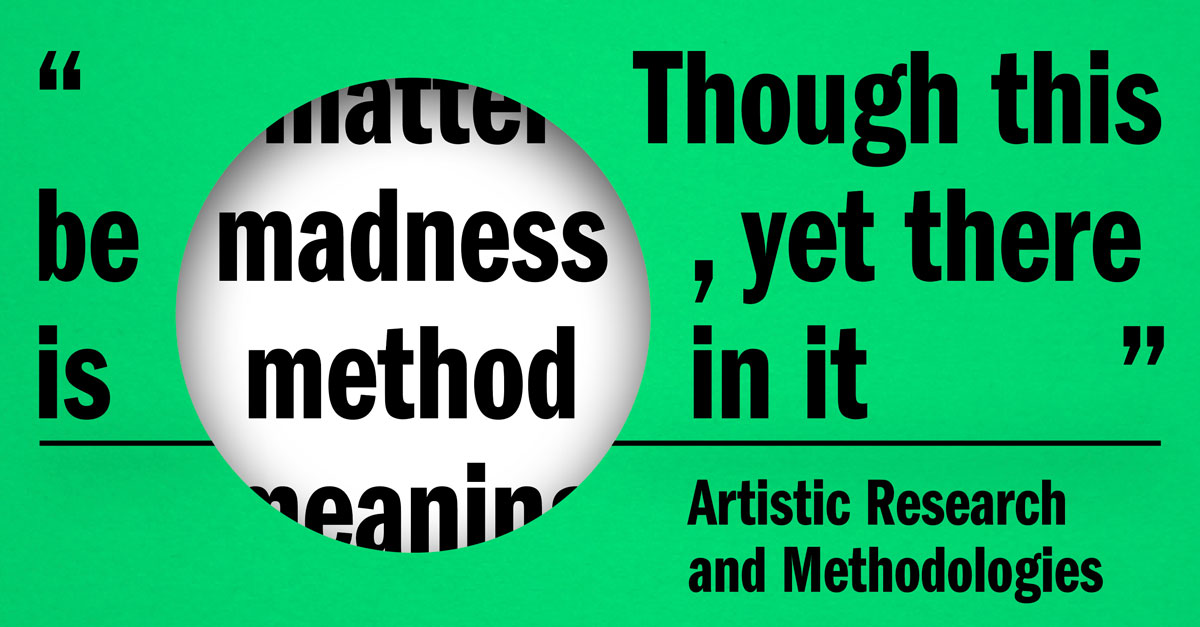
In the two decades that artistic research has existed in Flanders within an academic environment, discussion about what is an artistic versus a discursive methodology, “productive” versus “reflective” research, has never abated. And that is a good thing, as consensus in art is always suspect. That is also the reason a day spent examining the methodology of artistic research is still relevant today. The goal is not to reinvent the wheel, but to show an interesting combination of, on the one hand, hands-on methods of artistic researchers and, on the other hand, reflections about methodology that start from the specific observations in the workplace, studio, stage, editing room, study room, and so forth. For several years, “artistic research” has been given a more important role in arts education programs. Therefore, it is very useful to take a closer look at and interpret the methodological bottlenecks for artists-as-researchers from a pedagogical point of view. Perhaps a beginning to a solution can be found – a solution that will always be specific and very seldom generic.
This cluster is a collection of contributions based on the lectures given at a symposium on artistic research and methodologies on the 26th of April 2021. This event — a live stream that was broadcasted from the Kaaitheater in Brussels — was organised by PXL-MAD School of Arts, UHasselt, RITCS, Royal Conservatory Brussels, VUB and Brussels Art Platform. A recording of the whole stream can be watched here.
a
clustered | unclusteredResearch Environments
Joost Vanmaele, Agency, Katinka de Jonge, Amber Vanluffelen
De vrolijke wetenschap beperkt zich niet enkel tot het verstand, maar richt zich op alle aspecten van onze lichamelijke relatie tot onze omgeving – we verwerven een dergelijke kennis immers niet enkel via ideeën en beelden, maar ook via sensaties, affecten, stemmingen, emoties en verlangens.
— Kris Pint, De wilde tuin van de verbeelding (2017)
Methodonomy: Navigating the Space of Artistic Research
Joost Vanmaele
Excerpt from “Forever Young,” opening speech at Though this be madness, yet there is method in it, Symposium on Methodologies in Artistic Research, 26 April 2021, Kaaitheater Brussels
My approach to the question of artistic research takes its cue from the frequent use of the preposition ‘versus’ in the text that announces this event: artistic versus a discursive methodology, productive versus reflective research. It is the theme of relation where ‘versus’ points to a relation of conflict, a stand-off with a potential winner or with no winners at all in the case of a status quo.
Further on, we find three small connecting words in the title of this symposium, which also refer to a specific type of relation or connection:
though this be madness, yet there is method in it.
In the Oxford English Dictionary ‘though’ in combination with ‘yet’ is defined as:
An adversative particle expressing that relation of two opposed facts or circumstances […] in which the one is inadequate to prevent the other, and therefore both concur, contrary to what might be expected.
This comes close to what we would call a contradictio in terminis, an apparent but not a real contradiction — a relational situation where one cannot do without the other.
This close link is even more strongly articulated by the preposition ‘in’. Method, then, is considered to intrinsically belong to madness. It is a relation of close belonging and embeddedness.
We are all familiar with the fascination that artistic research, a concept that does not necessarily include a specific relational link or preposition, seems to have with exploring small words that can shed light on the connection between the world of art and the one of academia. Research on, for, in and through the arts are alle options that have been extensively examined in the past.1
This relational struggle between art and academia is not new, of course. In Antiquity forms of madness and divine inspiration, called enthousiasmos, mania of phantasmata were considered as methods that gave poets privileged access to the world of the muses and original ideas. These Greek terms later evolved into the concept of genius, where Immanuel Kant famously made a clear distinction between the genius-driven methodlessness of the arts and the predictable and method-laden world of scientists.2
This is not the place to recount the history of ideas related to the semantic spectra that surround the notions of ‘madness’ and ‘method’, but we can explore how ‘versus’, ‘in’ an ‘though’, the words used to frame this event, can be considered as connectors that relate to different attitudes in artistic research that nowadays co-exist and operate along a spectral continuum.
The first attitude in artistic research focuses on ‘versus’ and a situation of radical and functional separation. It is a perspective where both the field of academia and the field of artistic action live in a state of splendid isolation and specialisation. From this romantic and Kantian point of view, artistic practice has immediate access to a privileged world of ideas and creation, and should stay far away from all terrains that have the word ‘logic’ in their denomination. A potential opening to artistic research is one where it is stated that: 1/ practice is research, 2/ that the arts produce specific kinds of knowledge that are qualitatively different from traditional activities in academia, 3/ that this knowledge is embodied in the artworks that are produced and that ultimately any infiltration of academic vocabularies or procedures would harm, endanger and violate this specific contribution to human understanding.
The second attitude in artistic research can be linked to the connectors ‘though’ and ‘in’. Whereas the previous orientation was a Kantian one, we could call this perspective, in line with the title of the conference, a Shakespearian attitude. It is again represented by a small word, a preposition this time: the concept of Practice as Research. When artists look in the mirror of academia, they see that their specific practical activities such as sketching, drawing, rehearsing can take on a new life within a research context and that more generic activities such as collecting, experimenting and conceptualizing have a close connection to activities that are deployed in academia. It can then be enriching to reflect on these connections in function of the development of artistic practices.
Taking the ‘in’ and ‘though’ a step further, we encounter a third familiar movement in artistic research where mirrors are turned into windows— windows that are not only used to look through, but also serve as access to extra- and transdisciplinary fields and to the exchange of ideas and processes. Here the researcher shows a keen interest in the connection between art and academia and values the eclectic relations with other research disciplines and the methods prevalent in those disciplines. By its generous openness, this movement is both vulnerable and full of potential. It is vulnerable because of the danger of one-sided domination of established research practices, and it is full of potential because of the refreshing energy that opening windows can bring.
By sketching this continuum of possibilities that connects art to research via a number of linguistic connectors, we end up with a view of an almost unlimited terrain that seems to be connected by only one element, one recipe for action that is specific to artistic research, namely that in artistic research the research is done through artistic practices. Artistic research methods need to include elements of practice, in the narrow or broad sense, in order to qualify as artistic research. But is this enough as a guide for the future of artistic research? And how does this state of abundance relate to a second topic of interest that speaks loudly from the text you find in the flyer and is embedded in the following sentence: “it is very useful to take a closer look at and interpret the methodological bottlenecks for artists-as-researchers from a pedagogical point of view.”
I wondered what these bottlenecks at a pedagogical level could be and if one of them could be related to a state of affairs where, at least on a methodological level, almost anything seems to go. A situation which is quite challenging and very difficult to navigate. This so-called methodological pluralism or eclecticism presents itself indeed as an open but at the same time daunting place with hardly any points of reference.
In the Facebook version of the announcement for this event I noticed a separation between ‘method-’ and ‘-ology’ by a slash, suggesting that ‘method’ and ‘logos’ do not need to be intrinsically linked. In the foreword of the English version of Mille plateaux by Deleuze and Guattari, Brian Massumi summarizes some of the authors’ thoughts on the difference between ‘logos’ and ‘nomos’: “Nomad space is ‘smooth,’ or open-ended. One can rise up at any point and move to any other. Its mode of distribution is the nomos: arraying oneself in an open space […], as opposed to the logos of entrenching oneself in a closed space.”3
It is an idea that would require further investigation and substantiation, but a case could be made that artistic research is related to a state of ‘methodonomy’ rather than ‘methodology’: An open space where no particular boundaries or limitations are set, besides a central place for artistic practice, and where one has to set out an individual and tailormade trajectory in close relation to particular research questions or interests, over and over again.
Massumi further connects the space of the nomos to the one of air, whereas the logos is related to the space of earth. But again, the question prompts itself: how to behave or array oneself in such an open space, starting anew over and over again with the danger of losing track or getting lost?
I relate this question to Immanuel Kant’s remark in the Critique of Pure Reason: “The light dove, in free flight cutting through the air the resistance of which it feels, could get the idea that it could do even better in airless space.”4 We do not act in a complete vacuum, I think, given the centrality of practice, but this image suggests that some kind of resistance or order is needed to support and allow for free and creative flights. Paulo de Assis and Falk Hübner have both proposed such frameworks with specific attention for elements of emergence; their ideas can be consulted in the article that opens the thematic issue on methodology in FORUM+.5 But I would like to add here another option, one that keeps with the notion of a methodonomy, i.e. an open space, but also indicates ‘topoi’, a term borrowed from ancient rhetoric studies, here understood as strategic and fertile places in a methodical landscape that do not limit any terrain but are by their nourishing qualities frequently visited by artist-researchers.
A first topos focuses on creation and experimentation. Within this topos, artist-researchers enrich the field of artistic practice by focusing on the production of new artifacts or events. It is an action-based, hands-on topos that is closely and implicitly connected to the experimental and creative habitus of the artist-craftsman. This topos is concerned with the artistic material itself, which evolves into an artistic product by activities such as drawing, creative writing, composing, writing a film script, or developing a dance production or a performance.
A second topos, or frequently visited place in artistic research, does not focus on the product but rather on the artistic process and the tacit or embodied knowledge implicit in the creative act. It is the topos of reflection and can be related to the image of the mirror that we encountered in a previous phase of this text. Within this topos the intention is to scrutinize and verbalize through a process of self-reflection. Specific methods linked to reflection are activities such as thinking, imagining, conceptualizing, writing, modelling, developing, questioning, integrating, criticizing, articulating and reflecting-in-acting.
A third topos focuses on the exploration of new sources of information as a basis for further artistic reflection and experimentation. It prioritizes an outward look and explores the information galaxy for locating potentially relevant insights to then translate these into an artistic discourse and practice. It is the topos of the window or the bee, as stated by Francis Bacon in The New Organon: “it takes material from the flowers of the garden and the field; but it has the ability to convert and digest them.”6 Here, concrete actions on the level of method are reading, surveying, interviewing, collecting, asking, inquiring, observing, auditing, and so on.
The perspective of topoi is one that Aslaug Nyrnes advocates in an article dating from 2006, where she adds that artistic research is not about staying with one topos but about travelling in a space and as such connecting various outlooks and engagements with a field of interest.7 On this view, artistic research should always be about finding a balance between topoi; artistic research is research that combines experiment with reflection and information and in that manner moves beyond the private sphere of experience and creation. In a topical approach to artistic research, it is not about one topos versus the other but about connecting various strategic outlooks and engagements with regard to certain questions and interests in order to gain new insights.
The topical approach at the strategic level of artistic research, which is always open to additional topoi, is situated between openness and systematicity. It does not provide researchers or students with ready-made methods or a closed methodology but offers instruments to make up their own research design.
This balance between openness and systematicity brings me to the future of artistic research and its methodology, or methodonomy, as I would suggest to name what concerns us here.
It is often mentioned that artistic research is a young discipline, a qualification that implies that one day artistic research will naturally evolve into a mature discipline that teaches and disciplines its disciples with clear-cut paradigms and solutions. Is this the route we want to follow as a community of researchers? Or do we want to stay forever young? Or do we favour an in-between position, drawing on and sharing experiences in the field and being forever open to new and often rebellious perspectives by artists themselves. It is my view that artistic research has fruitfully weathered a first wave of discursive domination and disciplining. Whereas in its beginnings, the discourse was dominated by ontological questions formulated by theorists and specialists in philosophy and epistemology, we now see the emergence of a meta-practical discourse that is generated and owned by artist-researchers themselves and pragmatically supported by interesting practices.To me, at least, these are signals that we are slowly heading towards a balanced in-between situation where identity, freedom and constraint counterbalance and energize each other and sustain a longstanding youthfulness.
(…)
Notes
- 1 Henk Borgdorff, The Conflict of the Faculties: Perspectives on Artistic Research and Academia (Leiden: Leiden University Press, 2012), 37-39.
- 2 Immanuel Kant, Kritik der Urteilskraft (1790), §49.
- 3 Brian Massumi, foreword to A Thousand Plateaus: Capitalism and Schizophrenia, by Gilles Deleuze and Félix Guattari (London: Bloomsbury, 2013), xiii.)
- 4 Immanuel Kant, The Critique of Pure Reason. Trans. Paul Gruyer and Allen W. Wood. 15th printing (Cambridge: Cambridge University Press, 2009), 129.)
- 5 Falk Hübner and Joost Vanmaele, “Pathways to a Fertile Valley. On Methods and Methodologies in Artistic Research,” FORUM+ 27, no. 3 (Fall 2020): 4-16, https://www.forum-online.be/en/issues/herfst-2020/op-weg-naar-een-vruchtbare-vallei.
- 6 Francis Bacon, The New Organon, ed. Lisa Jardine and Michael Silverthorne (Cambridge: Cambridge University Press, 2000), 79.
- 7 Aslaug Nyrnes, “Lighting from the Side: Rhetoric and Artistic Research,” Sensuous Knowledge Journal 3 (2016).
boundary thing 001652 (Monkey’s Selfies)
Agency
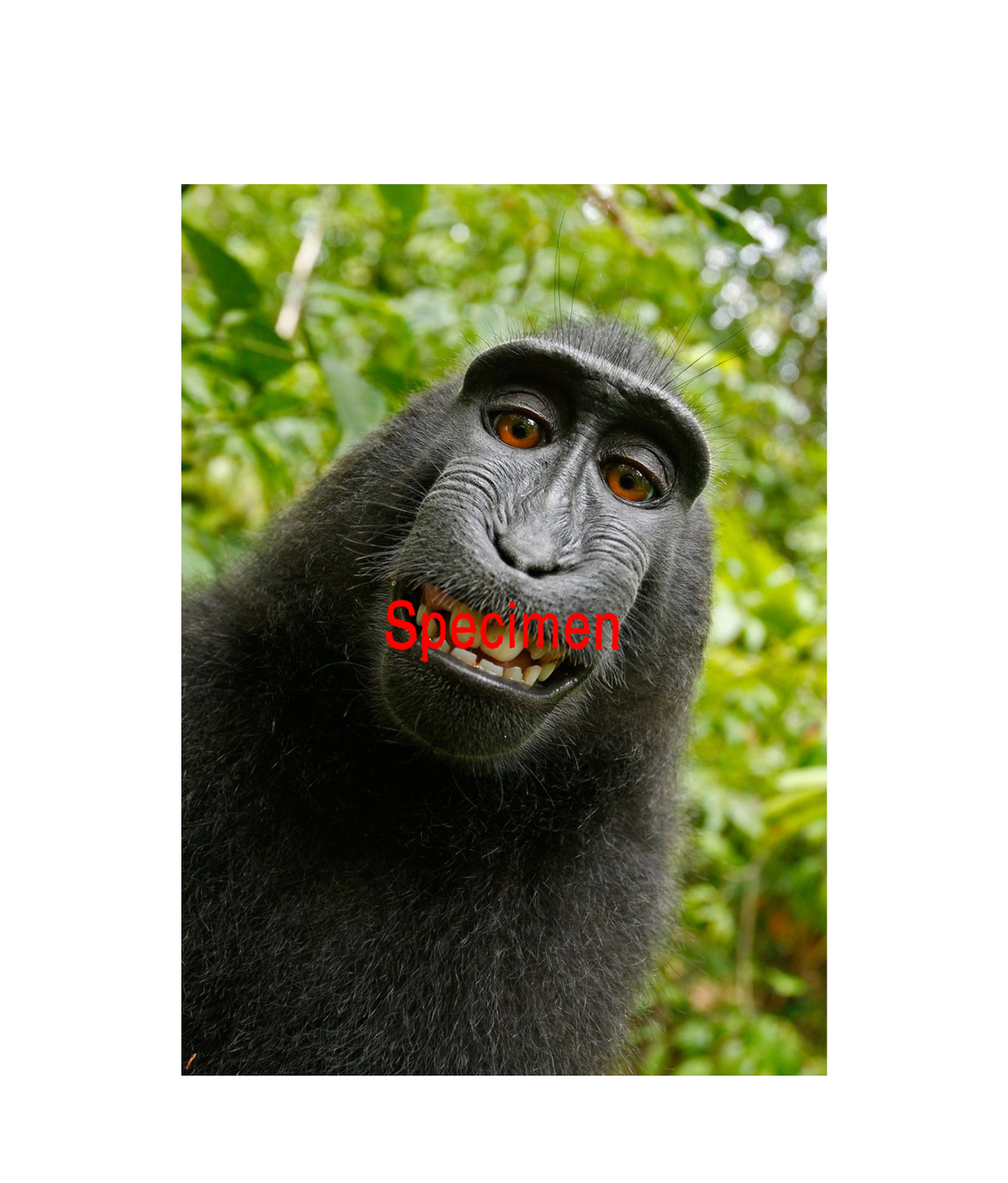
boundary thing 001652 (Monkey’s Selfies)
In 2011, David Slater, a wildlife photographer from the United Kingdom, traveled to Indonesia to take photos of the rare Sulawesi crested macaques. The crested macaques (Macaca nigra) are a species that today only lives in the Tangkoko Reserve, northeast of the Indonesian island Sulawesi (Celebes), and on smaller neighboring islands. Over the last 25 years the number of crested macaques has decreased by approximately 90%. The Tangkoko Reserve is near a village and the macaques are used to encountering tourists and photographers. During Slater’s visit, one macaque examined and manipulated his camera. When Slater retrieved his camera, there were several photographs taken by the macaque on it. In 2011 Slater published some of these photographs under the title Monkey’s Selfies. One photograph was included in The Daily Mail online newspaper. Its copyright notice read: “Copyright Caters News Service”. Monkey’s Selfies went viral on the internet. In November 2014 Slater published the Monkey’s Selfies series in the book Wildlife Personalities.
In 2015 Next Friends of Naruto, a group including People for the Ethical Treatment of Animals (PETA), an animal rights organization from the United States, and Antje Engelhardt, a primatologist from Germany, filed a complaint against Slater for the violation of the macaque’s copyright by displaying, advertising, and selling copies of the photographs. Engelhardt studies the endangered Sulawesi crested macaques as part of the Macaca Nigra Project. She claimed that Naruto, a six year old macaque, took these photos. Next Friends stated that Naruto should have the right to own and benefit from the copyright of the photos in the same way as any other author would. They claimed that all benefits of Monkey’s Selfies should fund the conservation efforts for the Macaca nigra. Slater argued that PETA’s claim should be dismissed because animals such as Naruto are not protected by the U.S. Copyright Act of 1976.
On January 28, 2016, the court case Naruto v. David Slater took place at United States District Court of California. Judge William Orrick held:
I disagree with Next Friends. [...] Here, the Copyright Act does not “plainly” extend the concept of authorship or statutory standing to animals. To the contrary, there is no mention of animals anywhere in the Act. The Supreme Court and Ninth Circuit have repeatedly referred to “persons” or “human beings” when analyzing authorship under the Act. [...] “For copyright purposes, however, a work is copyrightable if copyrightability is claimed by the first human beings who compiled, selected, coordinated, and arranged [the work].”1 [...] Next Friends have not cited, and I have not found, a single case that expands the definition of authors to include animals. [...] Moreover, the Copyright Office agrees that works created by animals are not entitled to copyright protection. It directly addressed the issue of human authorship in the Compendium of U.S. Copyright Office Practices issued in December 2014 (Compendium). [...] [T]he Compendium states that, “[t]o qualify as a work of ‘authorship’ a work must be created by a human being. Works that do not satisfy this requirement are not copyrightable”.1 Specifically, the Copyright Office will not register works produced by “nature, animals, or plants” including, by specific example, a “photograph taken by a monkey”. [...] Naruto is not an “author” within the meaning of the Copyright Act. Next Friends argue that this result is “antithetical” to the “tremendous [public] interest in animal art”. Perhaps. But that is an argument that should be made to Congress and the President, not to me. The issue for me is whether Next Friends have demonstrated that the Copyright Act confers standing upon Naruto. In light of the plain language of the Copyright Act, past judicial interpretations of the Act’s authorship requirement, and guidance from the Copyright Office, they have not.
The court dismissed the complaint by the Next Friends of Naruto and concluded that photographs taken by a non-human are not protected as a work of art within the meaning of the Copyright Act.
Notes
Het lopend gesprek
Over de wandeling als blikwisseling
Katinka de Jonge
Toen de wereld tot stilstand kwam, begon ik te wandelen.
Dat klinkt dramatisch, en dat was het ook, want ik was bijlange niet de enige. In de lente van 2020 wandelde ik tussen drommen mensen langs de Scheldebocht, die alleen of in groepjes, met kinderwagens, picknickmanden, honden, stepjes en rolschaatsen, de smalle paden bevolkten.
We wandelden niet uit luxe maar uit noodzaak, het was de enige activiteit die een pauze gaf van het beeldscherm dat ons dagelijks achtervolgde. De enige manier om de wereld in perspectief te zien, en vanop een afstand onze nieuwe situatie van stilstand te observeren. Hoe waren we hier terechtgekomen? Ikzelf was nog maar net in deze stad komen wonen en mijn huis bevond zich op een prettig overgangspunt tussen het centrum en de velden erbuiten. Wandelen werd een ritueel dat deze twee werelden verbond.
Later schreef ik een voorstel om een artistiek buurtproject op te zetten, omdat ik de stad beter wilde leren kennen. Het was nog niet geheel duidelijk wat het resultaat zou zijn. Ik wist alleen dat ik weer wilde wandelen, en dat ik samen met buurtbewoners de voor mij anonieme straten, pleinen en parken een gezicht wilde geven. Binnen mijn artistiek werk bekijk ik publieke ruimte vanuit de spanning tussen het ontwerp enerzijds en het dagelijks gebruik anderzijds. Kan wandelen in die optiek een subversieve tactiek zijn?1 Met dit project wilde ik focussen op de relatie tussen de wandeling en het gesprek. Ik wilde onderzoeken hoe mensen, door samen te wandelen en te spreken, hun omgeving anders begrijpen.
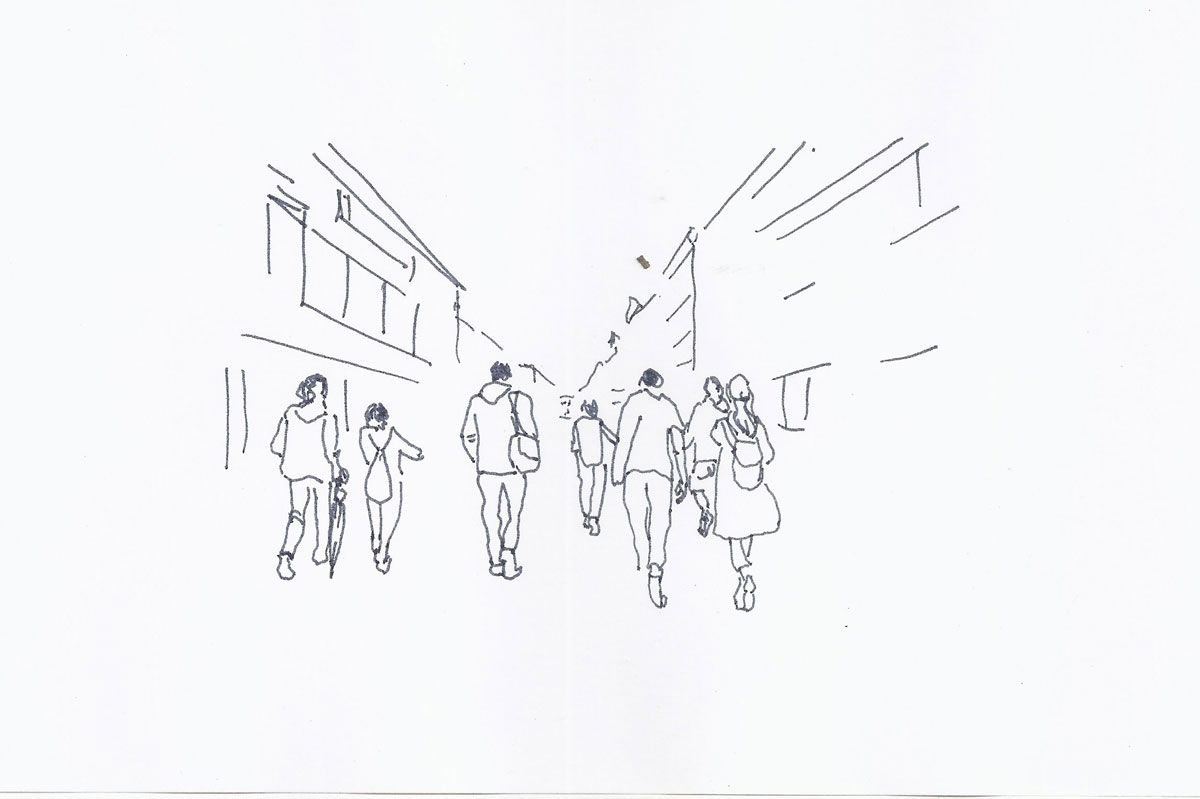
Ruimten Rondom
As humans, walking defines us. We are two legged apes. We walk, and we talk. We are the thinking minds – thinking in language, more often than not. The rhythms of our walking and thinking are one.2
De titel ‘Ruimten Rondom’, naar het bekende boek van Perec, gebruikte ik aanvankelijk als werktitel, maar gaandeweg merkte ik dat deze titel toch mijn houvast werd, en dat de titel steeds meer betekenissen kreeg. In het boek omschrijft Perec de ruimte rondom zichzelf beginnend vanuit zijn eigen bed, en uitwaaierend in de wereld. In eerste instantie was mijn titel een verwijzing naar het boek zelf, een manier om de omgeving te omschrijven. ‘Ruimten Rondom’ impliceert ook een kern, een kern waar het níét over gaat, maar waar omheen wordt gecirkeld. Of zoals Perec het zelf omschrijft:
Het onderwerp (...) is niet precies de leegte, maar veeleer wat zich daaromheen of daarin bevindt. Om te beginnen is er dus niet veel: het niets, het onvatbare, het virtueel immateriële, de uitgebreidheid, het exterieure, datgene wat buiten ons is, datgene waar we ons middenin bewegen, het milieu waardoor we omgeven zijn, de ruimte om ons heen.3
Dit sloot perfect aan bij hoe ik wandelen was gaan bekijken. Wandelen als tussenruimte, tussen locatie a en b, als eeuwige omweg, als iets dat altijd veranderlijk is.
Wandelen is zichzelf veranderen
Wandelen is zichzelf veranderen. Zo staat te lezen in het Vroegmiddelnederlands woordenboek, (online te raadplegen als onderdeel van het Instituut voor de Nederlandse Taal) dat de woordenschat van de dertiende eeuw verzamelt.4 Wandelen is wenden, wentelen, maar ook herhalen, heen en weer gaan. In latere eeuwen verbreedde de betekenis naar ‘rustig stappen voor het genot’. Doelloos rondwandelen was aanvankelijk een hobby van de Europese adel. In de achttiende en negentiende eeuw kregen stedelingen openbare parken en promenades, waar zij naar hartenlust konden slenteren, kletsen, flirten en anderen ontmoeten.
Over het fenomeen wandelen bestaat een heel discours met een traditie die teruggaat tot 1770 (al schreven de Oude Grieken ook al over wandelen om gezond te blijven).5 In 1770 schreef Jean-Jacques Rousseau voor het eerst over het fenomeen wandelen. Volgens Rousseau is wandelen een eenzame bezigheid. Tijdens zijn wandelingen voelde Rousseau zich vrij en onthecht genoeg om onbekommerd te denken en te mijmeren. Het zijn die alledaagse gedachten die de beste toegang geven tot wat en wie hij werkelijk is.6
De figuur van de flaneur (iemand die door in de stad te lopen de stad ervaart) wordt rond 1850 voor het eerst beschreven door Charles Baudelaire.7 Het flaneren was volgens hem de moderne levensvorm bij uitstek: de moderne mens (of ja, man) flaneert over drukbevolkte boulevards, langs de anonieme massa. De flaneur, die alles met een gepaste afstandelijkheid aanschouwt, wordt gezien als hét product van de moderniteit. Het wandelen door de stad speelt een belangrijke rol in het begrijpen, het deelnemen en het vastleggen van de stad. Waar Rousseau zichzelf afzondert tijdens zijn wandelingen, wil Baudelaire juist zoveel mogelijk communicatie en interactie met zijn omgeving uitlokken. De stad is een eerste vereiste voor de flaneur.
Geïnspireerd door o.a. Rousseau en Baudelaire ontstaat een eeuw later de groep van de Internationale Situationisten.8 Opgericht in 1958 streefden de Situationisten ernaar om een toestand van voortdurende maatschappelijke revolutie te creëren. Dit deden zij door het uitvoeren van ontregelende situaties en happenings. Hun zogenaamde dérive (afdrijven/afdwalen) is een variant op Baudelaires flaneren. Guy Debord beschrijft de dérive als het lopen in de stad zonder een specifieke bestemming, om zich zo opnieuw over te kunnen geven aan de prikkels van de omgeving en de daarmee gepaard gaande ontmoetingen. Het ronddolen zonder specifieke bestemming en jezelf opzettelijk proberen te verliezen in de stad zou een radicaal nieuwe ervaring van de stad mogelijk maken. Deze manier van wandelen was een spel, en een methode om de stad als ontregelend en inspirerend te ervaren, om anders te denken over de ons omringende ruimte.
De natuur van de stad
De spanning tussen wandelen in de natuur en in de stad is als een rode draad verweven door het project Ruimten Rondom. De artistieke organisatie die het project ondersteunt bevindt zich in een voormalige arbeidersbuurt aan de rand van de stad. Het is een dichtbevolkte volkswijk die deel uitmaakt van de negentiende-eeuwse industriële gordel, zoals veel grotere steden in België die kennen. En hoewel de buurt dus in dezelfde tijd werd gebouwd als de promenades en de parken voor de adel, kende deze arbeiderswijk geen open ruimte, laat staan groene ruimte. Er werd aanvankelijk überhaupt niet nagedacht over de leefbaarheid van de wijk. De grijze straten en karakteristieke cités bevonden zich onder de rook van twee grote fabrieken die werkkrachten nodig hadden om te kunnen draaien. Alle andere voorzieningen waren ondergeschikt. Arbeiders werden geacht om van de fabriek naar huis te wandelen, met hoogstens een omweg langs de kerk of de buurtwinkel. Vrouwen en kinderen werkten ook in de fabriek. Hoewel het dagelijks leven zich voor een groot deel op straat afspeelde, was dit eerder een onvermijdelijke expansie van de woonkamer van de klein behuisde gezinnen, dan dat het de bewoners toeliet om, zoals Rousseau het omschrijft, onbekommerd te denken.
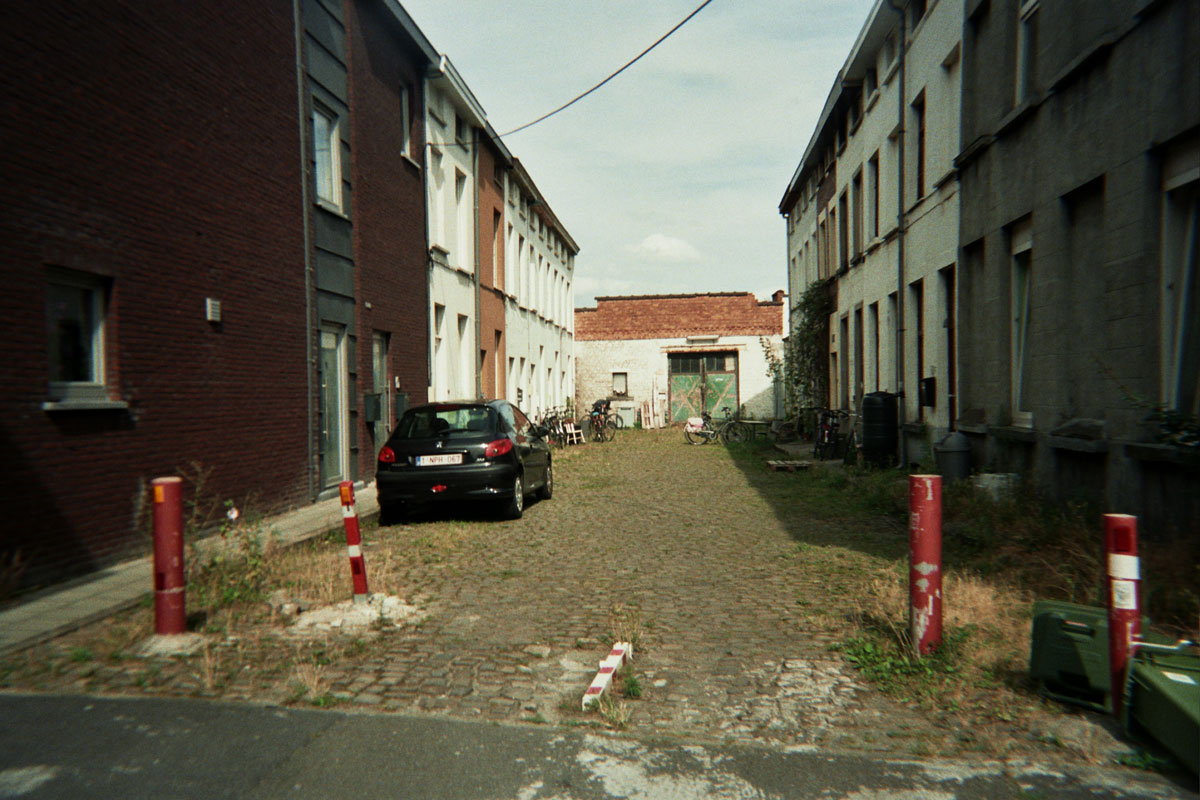
Openbaar groen was er honderd jaar geleden nauwelijks te bekennen. Als je geluk had, had je een klein tuintje waar je wat groenten in kon kweken, maar daar hield het vaak wel op. Momenteel zijn er echter vrij veel parkjes en andere stukjes groen in de buurt, maar hoe waren deze er gekomen? Ik besloot op verkenning te gaan.
Het spel
Ik maakte een plan waarbij ik één keer per week zou gaan wandelen, en waarbij mensen uit de buurt zich konden opgeven om mij te vergezellen. Samen met telkens andere groepjes buurtbewoners vertrok ik altijd vanuit dezelfde locatie voor wandelingen van twee à drie uur, zonder vooropgesteld plan. Geïnspireerd door de situationistische dérives draaide ik de verwachte rollenpatronen om, en gaf de controle uit handen. Wie meewandelde kreeg een rol: gids, verslaggever of fotograaf. De wandelaars kenden elkaar vaak niet, en door een rol op te nemen en de bijbehorende attributen toebedeeld te krijgen, werd het ijs gebroken om in gesprek te gaan. Er ontstond een speelse sfeer zonder dat die opgelegd aanvoelde.
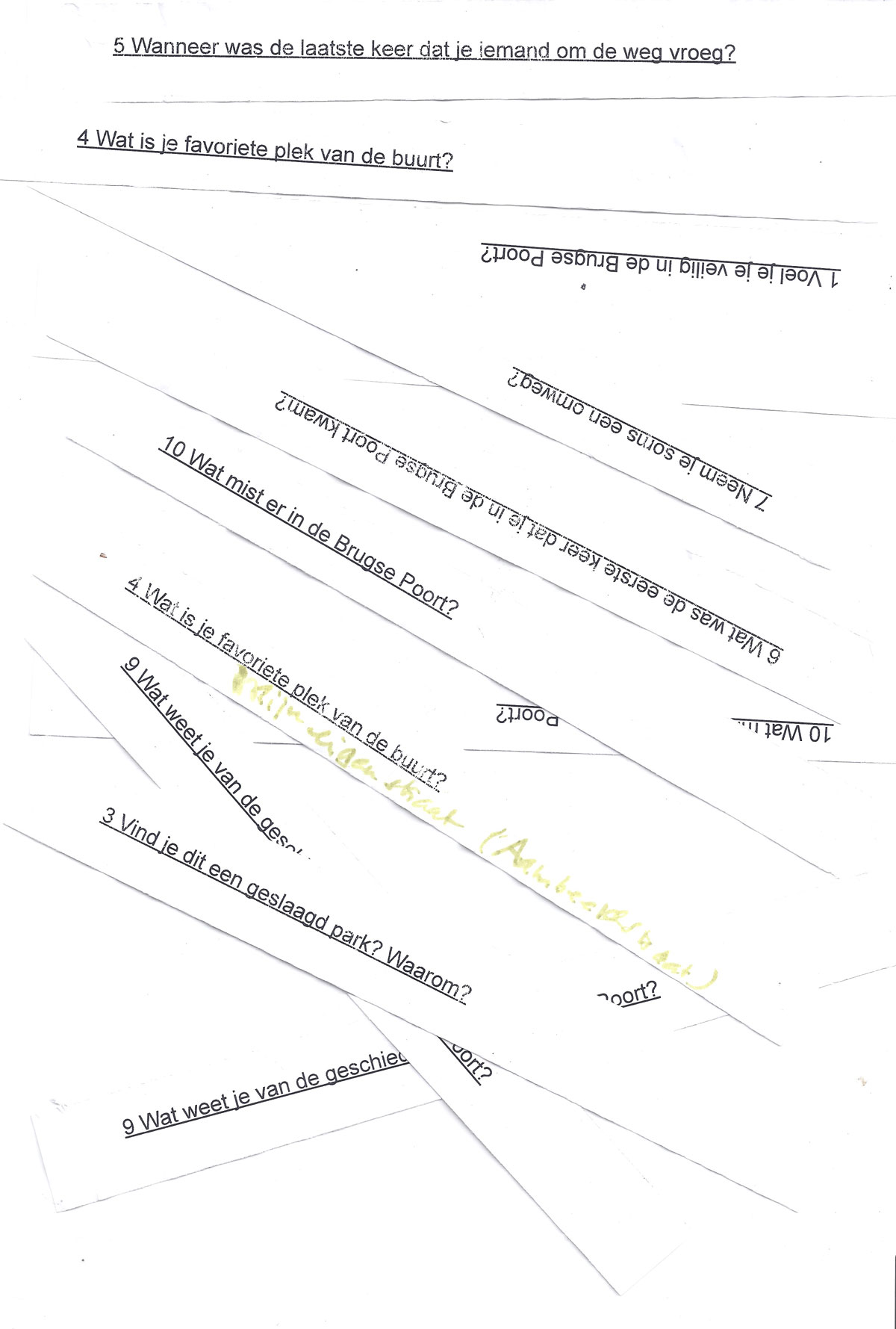
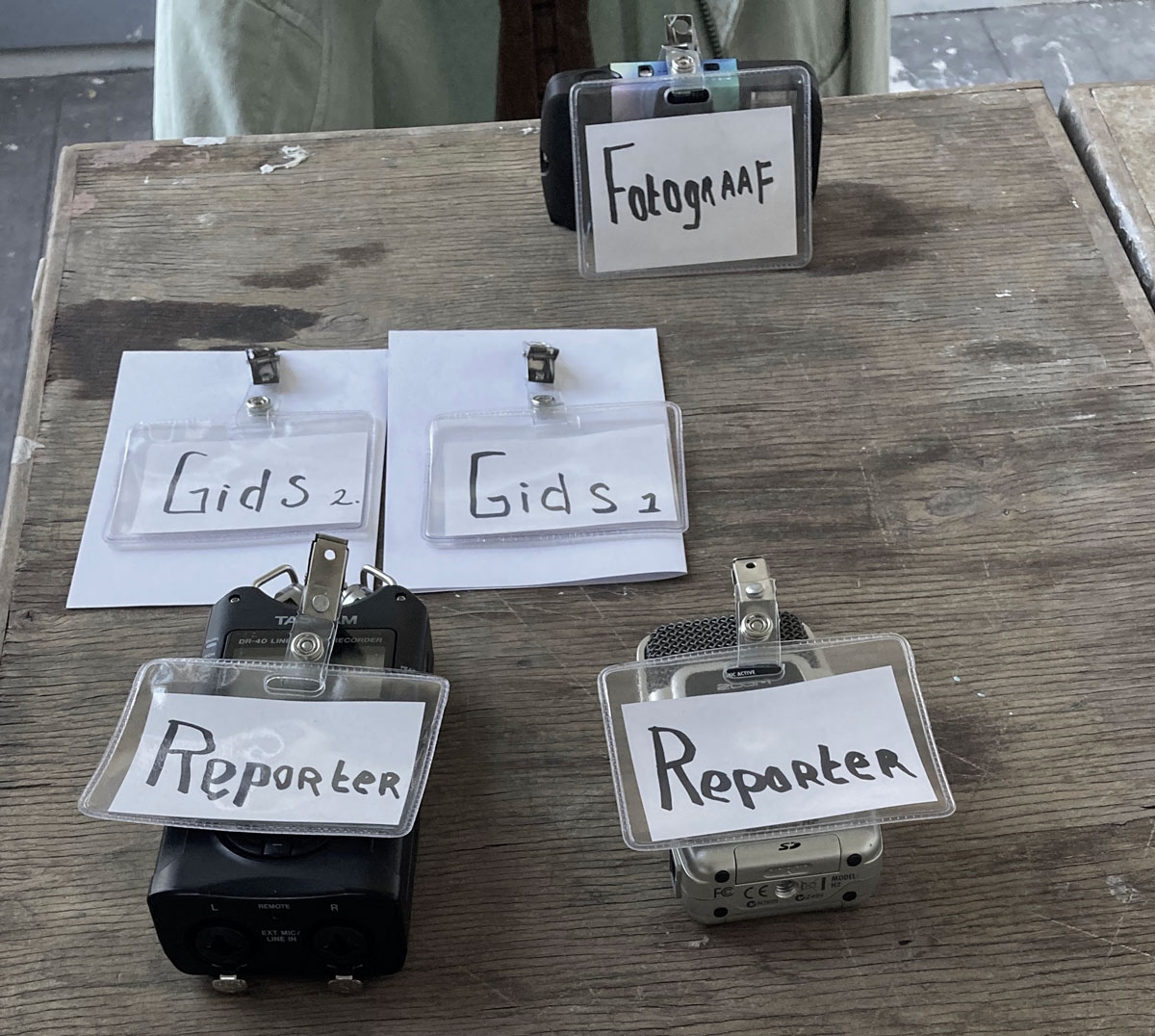
Ik leerde om niets voor te bereiden. Niet waar we naartoe zouden gaan, niet waarover we zouden spreken, niet waar we even stil zouden staan of wie of wat we zeker moesten tegenkomen, daar was het weer, de Ruimten Rondom, het toelaten van de leegte waarrond men zich beweegt. Er waren bewust twee gidsen, die met elkaar moesten overleggen over de route. Er waren twee verslaggevers, die ik een audiorecorder meegaf met het verzoek om gesprekken op te nemen. Vaak werd de aanwezigheid van de recorders na een tijd vergeten, waardoor de interviewachtige conversaties al gauw hun lossere en associatieve vorm terugkregen. Ik kocht voor elke wandeling een wegwerpcamera, waarmee de fotograaf mocht fotograferen wat die zelf belangrijk achtte.
Gezamenlijk wandelden we telkens door dezelfde straten van de buurt, en het viel op hoe traag wandelen gaat als je met een groep van ongeveer 10 personen bent. Er werd stilgestaan bij elke opvallende gevel, bij elke boom die niet in het rijtje paste, bij elke ongehoorzame geveltuin. In tegenstelling tot de eenzame mijmeringen van Rousseau werden mijn wandelingen een collectieve oefening in observeren. De straten werden telkens op een andere manier beschreven. Dezelfde verhalen werden door andere stemmen telkens op een andere manier verteld, en langzaamaan werd de groep een collectief brein dat de verhalen aanvulde en corrigeerde, of een nieuwe richting liet inslaan. De buurt werd nauwkeurig uitgepakt, en door de verschillende stemmen en perspectieven van de buurtbewoners werd dit voor mij een beeld in 4D.
De parken
Ik hield van de verhalen die de deelnemende wandelaars mij vertelden, en die uiteindelijk zoveel meer bleken te zijn dan louter anekdotes. De gesprekken lieten mij reflecteren over de verbondenheid van veel bewoners met hun omgeving. Door de recorders werden alle conversaties en interacties opgenomen en na een aantal wandelingen merkte ik dat veel verhalen cirkelden rond de tuinen en parken in de buurt. Dat was niet voor niets het geval. De aanvankelijk grijze buurt had geen groen. De oudere bewoners vertelden mij dat hier pas verandering in kwam toen een van de fabrieken in de jaren 60 van de twintigste eeuw failliet ging. De gebouwen werden gesloopt en het steenpuin bleef liggen, daarop groeide al snel een dicht bos. Plotseling was er een groene plek gekomen in de volgebouwde wijk. In de jaren 1970 leefde de vraag wat er met de open ruimte aan de rand van de wijk moest gebeuren. In eerste instantie leek het logisch om de hele plek vol te bouwen. De vroegere fabrieksgronden waren immers als bouwgrond bestemd. In die geest zijn destijds een aantal appartementsgebouwen opgetrokken, volledig volgens de ideeën van het Nieuwe Bouwen: een scheiding van functies, hoogbouw met groene grasvelden eromheen. De bedoeling was om hier nog eens vijf gelijkaardige blokken aan toe te voegen. Toen de aannemer failliet ging, werden die plannen opgeborgen en bleef het groen staan. Wat de beleidsmakers echter niet beseften, was dat de buurt al een functie voor deze ruimte had bedacht, en dat het groen al snel vergroeid was met het sociale weefsel van de buurt. Het deed mij denken aan wat Jane Jacobs in 1961 schreef in haar befaamde boek Death and Life of Great American Cities:
I will write mostly about general, ordinary things: for example, what kind of urban streets are safe and what kind are not; why some urban parks are beautiful and others are life-threatening ponds of lewdness; [...] what an urban neighborhood actually is and what tasks, if any, neighborhoods in big cities fulfill. In short, I will describe how cities function in real life, because this is the only way to find out which planning principles and which renewal practices can promote the social and economic vitality of cities, and which practices and principles weaken these qualities.9
Het braakliggend terrein was al lang geen lege ruimte meer, maar een plek om te wandelen, picknicken, te spelen en de hond uit te laten. Het enige wat het stadsbestuur moest doen, was hiernaar luisteren, en dit helpen faciliteren.
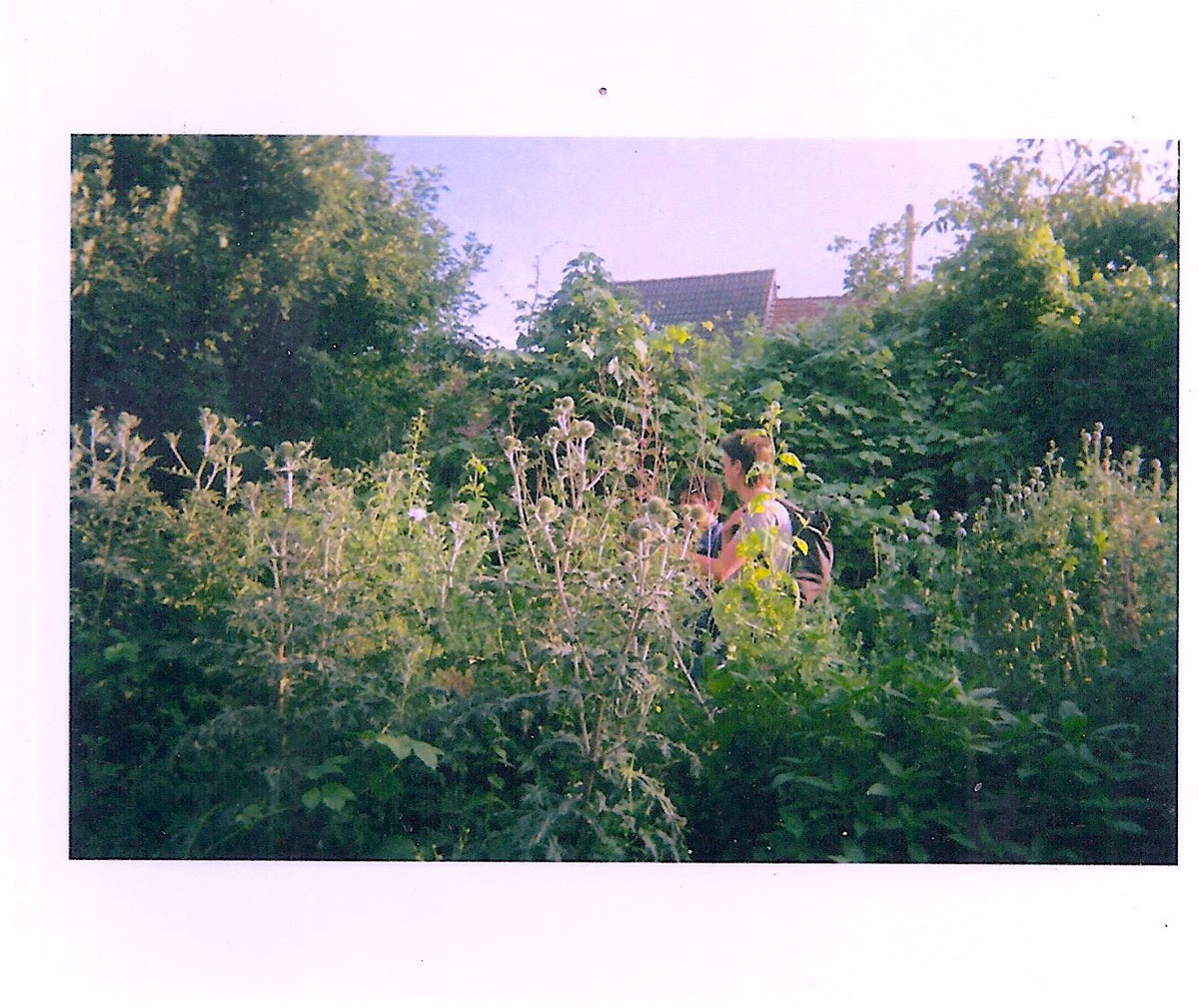
Maar dat deden ze niet meteen, dus roerde de buurt zich. In de jaren die volgden pleitten actiegroepen van buurtbewoners voor een groot park. Ze bezetten het terrein met een tentenkamp dat soms verschillende maanden bleef staan, ze bouwden boomhutten en organiseerden feesten. Dertig jaar lang volgden verschillende bouwplannen elkaar op, en telkens kwamen nieuwe actiegroepen op voor het behoud van hun ‘groene vallei’. Totdat, eind jaren 1990, eindelijk de knoop werd doorgehakt: het zou een park worden.
De strijd om groene ruimtes is nog altijd een humuslaag die de buurtbewoners verbindt. Nog altijd wordt één keer per jaar een groot feest georganiseerd in het park, en velen herinneren zich de bezettingen als de dag van gisteren.
Niet lang na deze overwinning stond er een nieuwe generatie op die, na het verzet van de jaren 1970, op een andere manier de strijd aanbond voor het behoud van hun buurt. Gentrificatie is het spook dat ook deze buurt eind jaren 1990 infecteerde. Doordat de buurt meer groen en andere voorzieningen kreeg, werd zij aantrekkelijker voor hoogopgeleide (witte) gezinnen, die de vervallen huisjes opkochten en opknapten. Cités werden platgegooid om er parken van te maken, en een aanzienlijk deel van de armere bevolking moest uitwijken. Als verzet hiertegen werden hele straten gekraakt om de plannen voor de toekomstige parken tegen te houden. Groen werd gezien als de gentrificatiemotor van de stad.
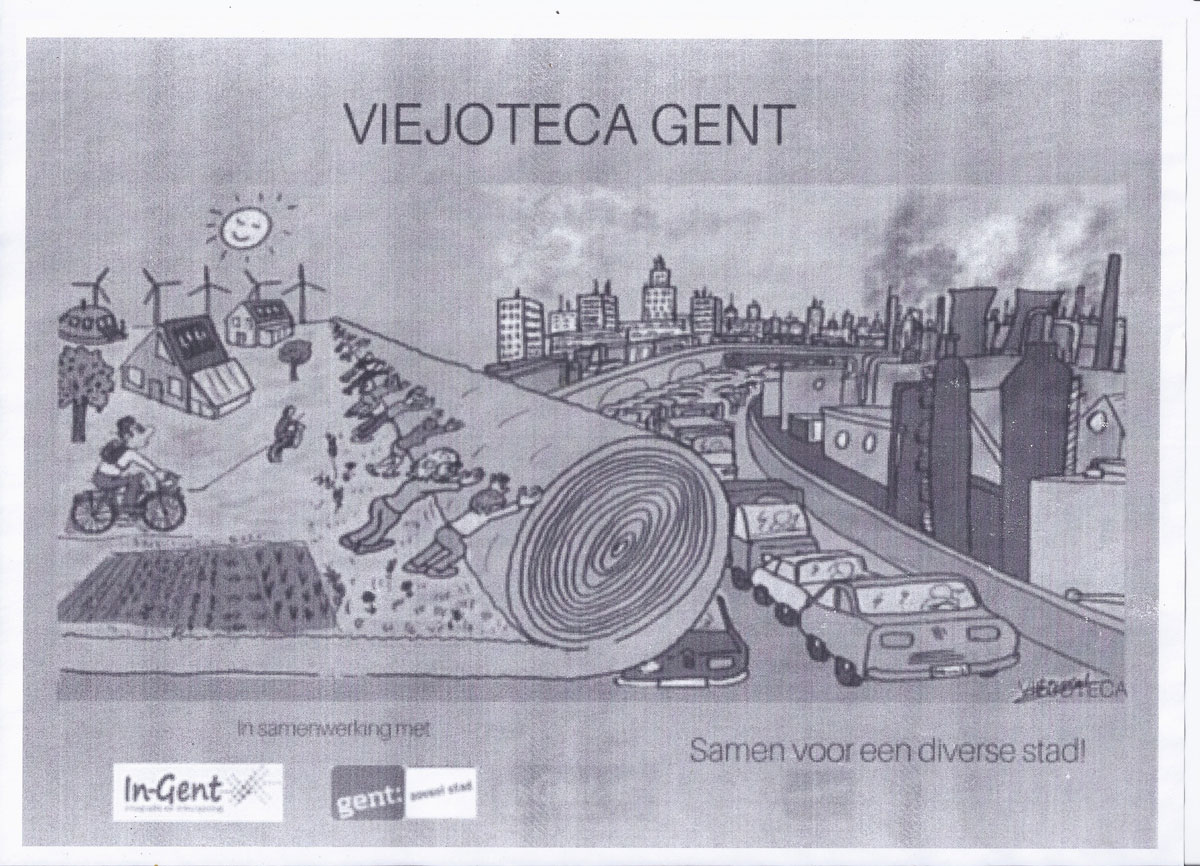
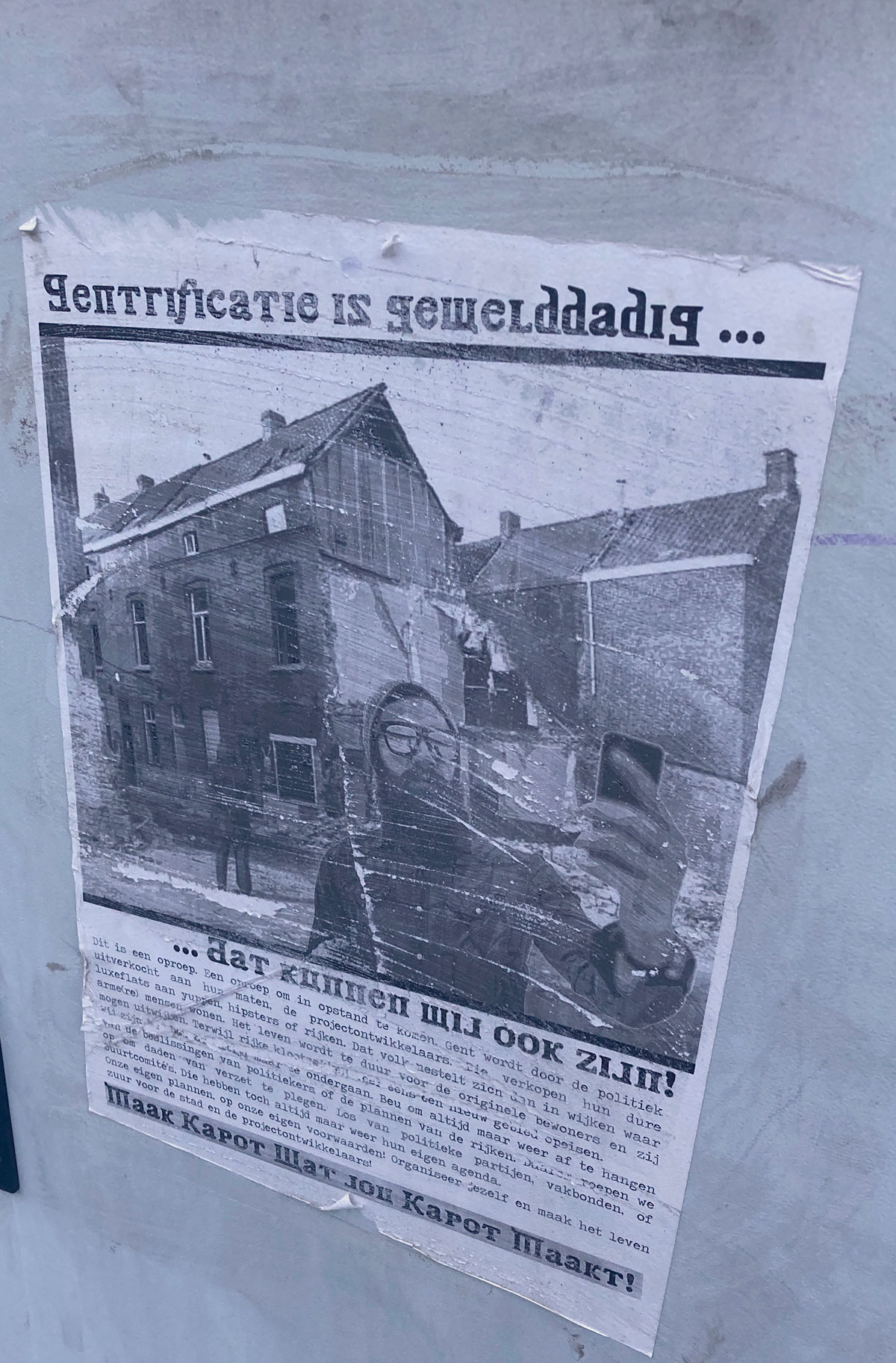
Mede door deze geschiedenis werden keer op keer de planten, plantsoenen, perkjes, bomen, geveltuinen en grasveldjes uitvoerig besproken tijdens de wandelingen. Wie maakt er gebruik van? Voor wie zijn de ruimtes toegankelijk en voor wie niet? Welke soorten planten en bomen groeien er, en wat groeit er maar hoort er niet te groeien? De blik op groene ruimte bleek de perfecte metafoor voor hetgeen wat wordt gedeeld, wat van iedereen is, en wat blijkbaar ook iedereen aangaat. Het onderwerp opende deuren om te spreken over andere zaken zoals de veiligheid op straat, discriminatie, toegankelijkheid en leefbaarheid. Onze wandelingen doorkruisten verschillende kennisgebieden, we hadden het over cultuur, antropologie, architectuur en stedenbouw, sociologie, onderwijs, biologie en filosofie. Het was onmogelijk om de gesprekken af te bakenen.
Lagen
Wat ik terugkreeg na al deze wandelingen waren urenlange geluidsopnames van buurtbewoners die even uit hun dagelijkse routine werden getrokken door een andere route te volgen, en zo de buurt van een andere kant bekeken. De woorden routine en route zijn niet voor niets met elkaar verbonden. Er ontstond ruimte om te reflecteren, om Rousseauiaans te mijmeren, Situationistisch te spelen, om te zoeken naar gedeelde grond.
Daarnaast kreeg ik een berg foto’s. De beeldenstroom vertelt ons iets over de blik waarmee verschillende bewoners hun eigen buurt observeren, en de esthetiek van de wegwerpcamera geeft een voyeuristische inkijk in een buurt die even specifiek als universeel is in haar identiteit en geschiedenis. De foto’s zijn aantrekkelijk doordat ze een zekere intimiteit en oprechtheid bezitten, het zijn ongefilterde beelden van de omgeving, de mensen en de sporen die zij achterlaten in hun buurt. Tegelijkertijd zijn de beelden herkenbaar en in zekere zin universeel: doordat elke buurt wel een bewoner kent die zijn geveltuin niet in toom kan houden, of dat ene huis dat werkelijk al drie jaar in de steigers staat, of dat basketbalpleintje waar alleen gevoetbald wordt, of die ene boom waar alle kinderen in klimmen.
Het mooie van het materiaal is de gelaagdheid ervan. Een moment wordt dikwijls driedubbel vastgelegd. Er is vaak niet alleen een moment in audio, maar er zijn ook de foto’s van de wegwerpcamera en foto’s genomen via een telefoon. Telkens als we dezelfde plek opnieuw bezoeken met andere wandelaars ontstaat er weer een ander moment, waarop een ander verhaal over de plek wordt verteld. De gelaagdheid die zo ontstaat geeft het materiaal een grote verbondenheid en verwevenheid, die meerstemmigheid toelaat. Door het materiaal opnieuw te bekijken ontstaan onverwachte verbanden en toevallige relaties die de buurt en de ervaring ervan op een heel dichte en subjectieve manier laten zien.
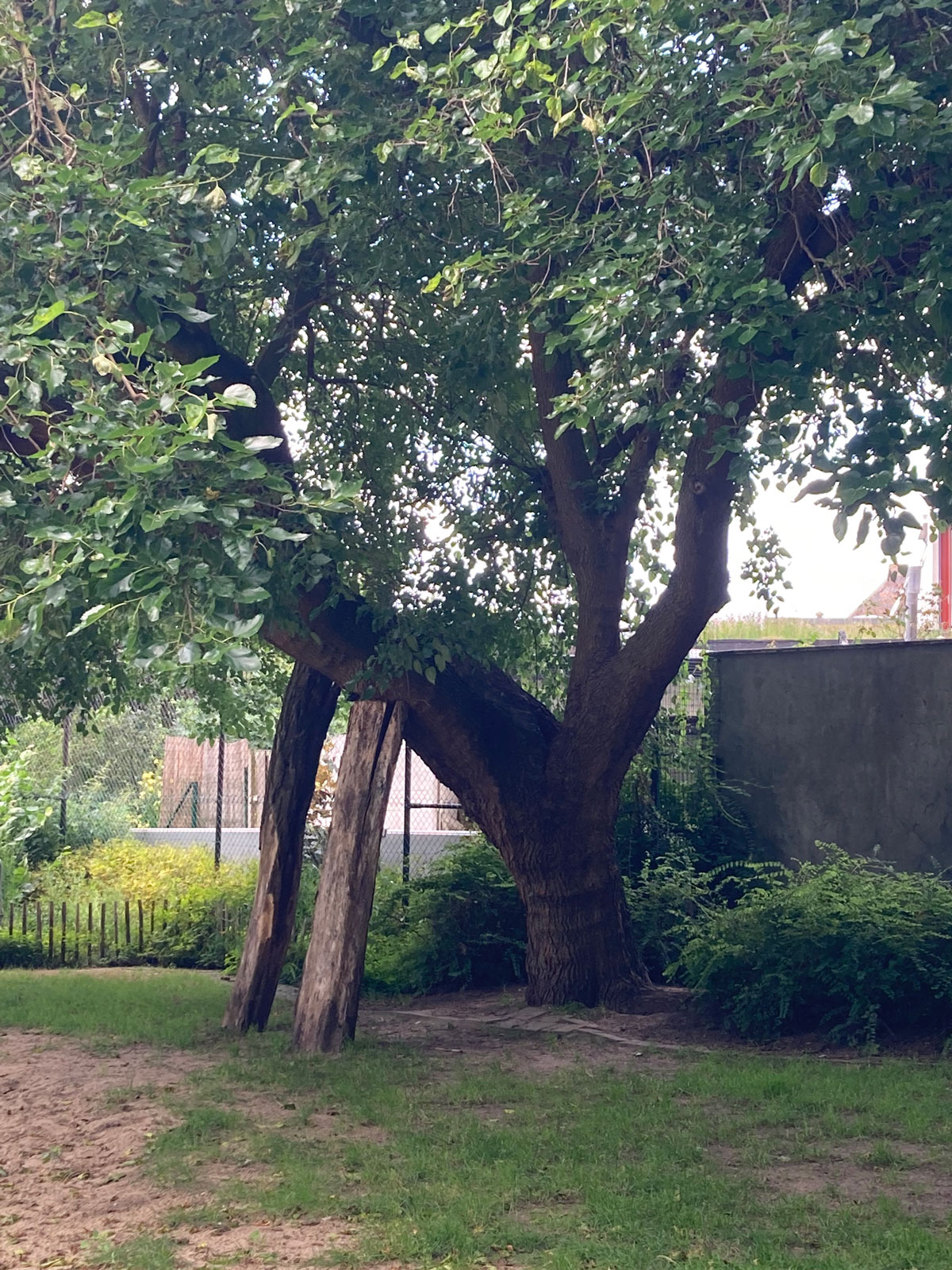
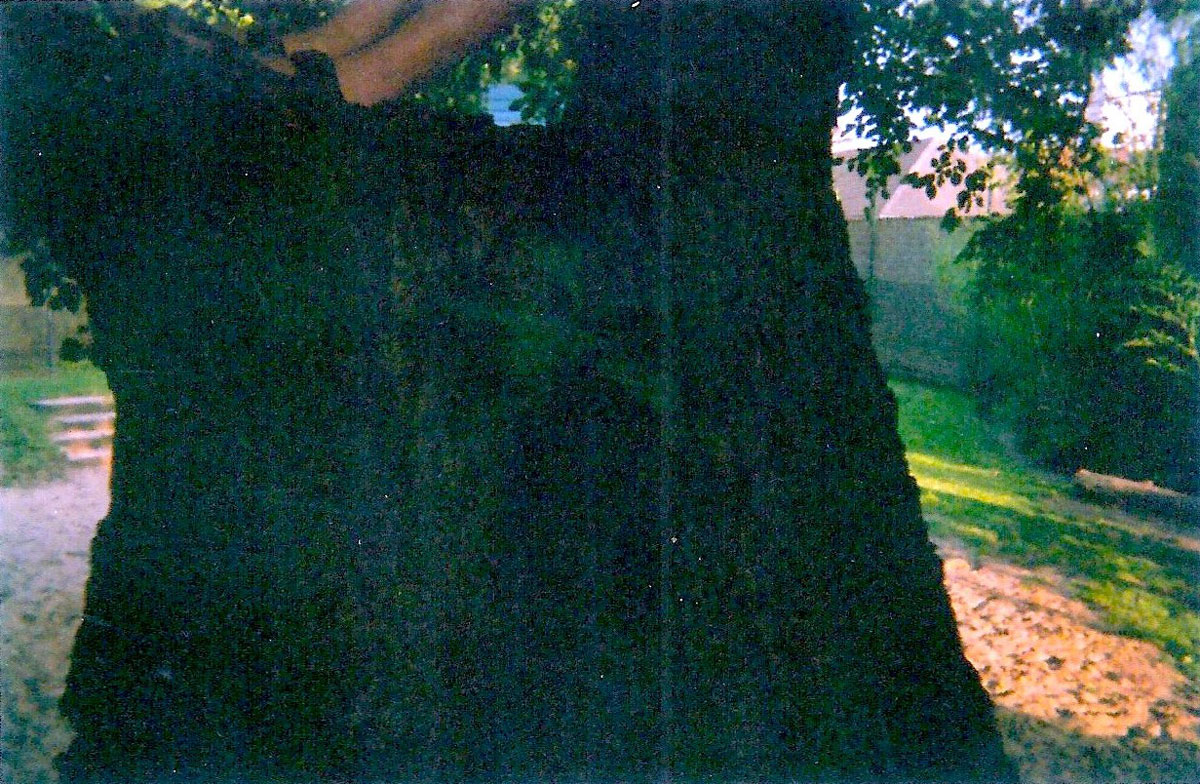
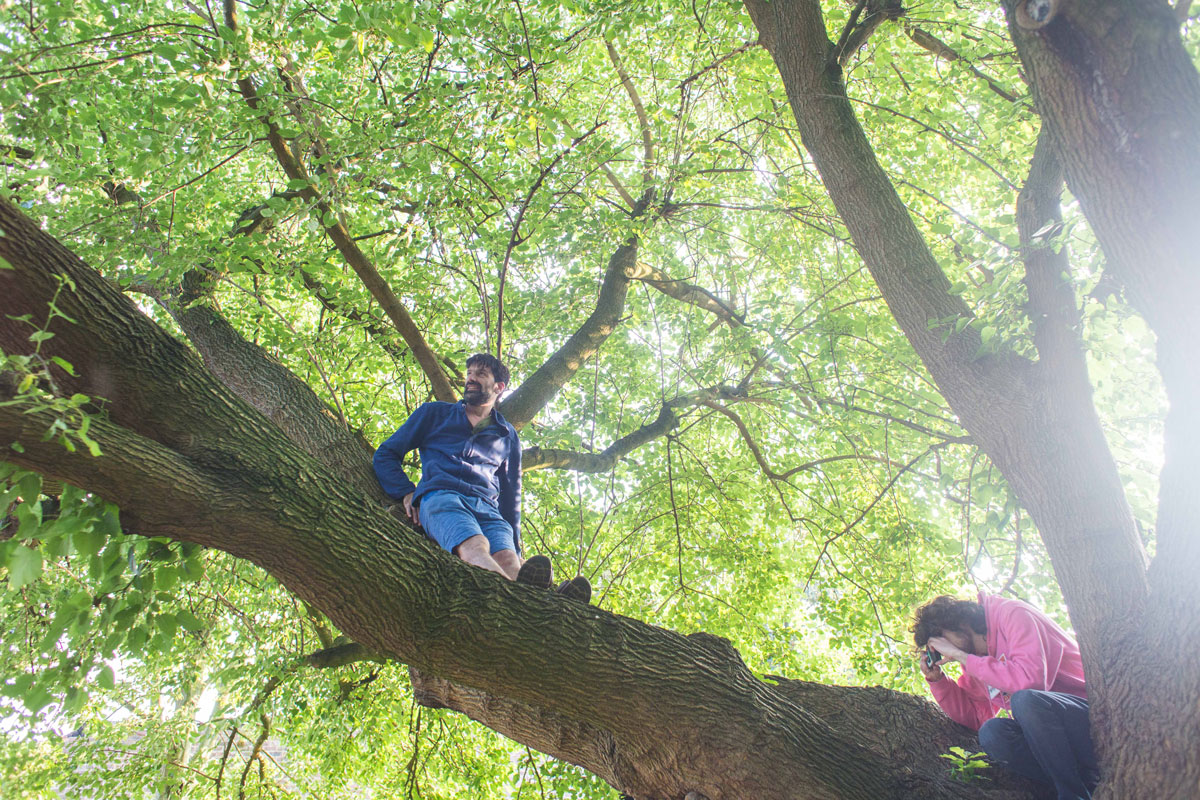
Fragment gesprek:
spreker 1 - Ahja wow spreker 2 - Een boom met krukken? Zit daar geen verhaal aan vast? spreker 3 - Die krijgt een uitkering nu… [gegiechel] spreker 4 - Ah daar, ja, daar had ik zelfs geen weet van, dat die ondersteund is spreker 1 - Ik heb dat ook nog nooit gezien, maar ik fiets hier gelijk… elke dag voorbij, da’s wel grappig… spreker 4 - Da’s ook een hele goeie klimboom spreker 4 - Waarschijnlijk daarom dat ie ondersteund is [gerommel, spreker 4 doet poging om in de boom te klimmen] spreker 1 - Moet ik u .. uhh – een voetje geven? spreker 4 - Wacht hé spreker 1 - 3, 2, 1 … spreker 2 - … en als je dan speelt en hij omvalt … spreker 1 - Ik ga je gewoon een voetje geven spreker 4 - Oke spreker 4 - Wacht he, die recorder [spreker 4 krijgt voetje van spreker 1 en klimt in de boom] spreker 1 - Ja, of om er makkelijker op te kunnen klimmen? spreker 2 - …. neee, dat denk ik niet, die balken, dat maakt het toch niet makkelijker? spreker 3 - Dat moet al een hele tijd zijn, he, dat ie ondersteund is, je ziet dat hem al dik ingegroeid is spreker 1 - Jajajjajaja – spreker 3 - En wat hebben ze hier zelfs gedaan, ze hebben gewoon hun riem ertussen gestoken - spreker 4 - Er zit hier een mega barst in de tak en er komt een eikje doorgegroeid spreker 1 - Komt er een eikje uit? spreker 3 - Groeit er een eikje door? spreker 4 - Ja, er groeit een klein eikje door de boom spreker 1 - Moet jij ook een voetje hebben? spreker 3 - Uuuh, ik denk dat het wel gaat lukken, ik moet gewoon even … wil je anders wel de camera vasthouden? spreker 1 - Dat kan ik – jaja [spreker 3 krijgt voetje van spreker 1 en klimt in de boom]
Uiteindelijk komen de beelden en verhalen samen in een publicatie. Ik heb lang over de juiste vorm nagedacht, maar weet nu dat ik het spel en het plezier van het wandelen zelf niet kwijt wil raken door de al te rigide vorm van een boek. Hierdoor besloot ik om alle beelden en geluidsfragmenten op een associatieve manier bij elkaar te brengen op losse kaarten. Op elke kaart staat een beeld, een omschrijving, een geluidsfragment in de vorm van een QR-code. Op de achterkant van de kaart staat de locatie van de foto aangeduid op een plan van de buurt. Op die manier kunnen de kaarten worden geschud, uitgekozen en gebruikt om een nieuwe route te bepalen. Het wordt zo een werk dat zichzelf telkens regenereert. De eerdere wandelingen bepalen de route van de volgende wandelingen, en tekens komt er een nieuwe laag van beleving bij. Door de vorm van losse kaarten is het mogelijk om verder te associëren door combinaties te maken, maar ook om nieuwe kaarten toe te voegen, en zo de mogelijkheden uit te breiden.
Door dit project ben ik mij anders gaan verhouden tegenover wandelen en routines, er gaat een bepaalde verfrissing vanuit om uit je dagelijkse routine te worden getrokken doordat iemand anders je route bepaalt. Ik hoop het ronddolen, flaneren, de wanderlust en de dérive terug te geven aan de buurtbewoners. Uiteraard zijn de huidige buurtbewoners andere mensen dan de arbeiders van honderd jaar geleden, maar de blikwisseling die wij creëerden, en de tussenruimten die wij bewandelden zijn iets wat mensen intergenerationeel met elkaar verbindt.
Noten
- 1 Michel de Certeau’s Practice of Everyday Life (California: University of California Press, 1980) is hierbij nooit ver weg. In het invloedrijke hoofdstuk “Walking in the City” stelt De Certeau dat “de stad” wordt gegenereerd door de strategieën van regeringen, bedrijven en andere institutionele instanties die instrumenten zoals kaarten produceren die de stad als een organisch geheel beschrijven. De kaart is vrijwel altijd een verticaal perspectief. Daarentegen beweegt de wandelaar op straatniveau zich op een tactische manier en nooit volledig bepaald door de plannen van organiserende instanties. Hij neemt bijvoorbeeld kortere wegen en ontwijkt daarmee het strategische raster van de straten. Dit concretiseert het argument van De Certeau dat het dagelijks leven zich afspeelt als een proces van het bewandelen van het grondgebied ontworpen door anderen, waarbij de patronen, regels en systemen die al bestaan, worden gebruikt op een manier die nooit volledig wordt bepaald van bovenaf.
- 2 Kerry Andrews, Wanderers. A History of Women Walking, (London: Reaktion Books, 2020)
- 3 George Perec, Ruimten Rondom (originele uitgave Fr. Espèces d’espaces, 1974), (Amsterdam: Arbeiderspers, 2008)
- 4 Vroegmiddelnederlands woordenboek, https://gtb.ivdnt.org/search/?owner=VMNW, geraadpleegd op 10-01-2022.
- 5 Aulus Cornelius Celsus, De Geneeskunst (Amsterdam: Uitgeverij Damon, 2017).
- 6 Jean-Jacques Rousseau, Overpeinzingen van een eenzame wandelaar (Utrecht: Uitgeverij Veen, 1994, eerst gepubliceerd in 1782).
- 7 Charles Beaudelaire, The Painter of Modern Life (London and NY: Phaidon Press, 1995, eerst gepubliceerd in 1863).
- 8 Andrew Hussey, Guy Debord. La société du spectacle et son heritage punk (Paris: Uitgeverij Globe, L’école des loisirs, 2014)
- 9 Jane Jacobs, Death and Life of Great American Cities, (NYC: Vintage Books ed, 1992, eerst gepubliceerd in 1961)
Strategy Guide for Environments
Amber Vanluffelen
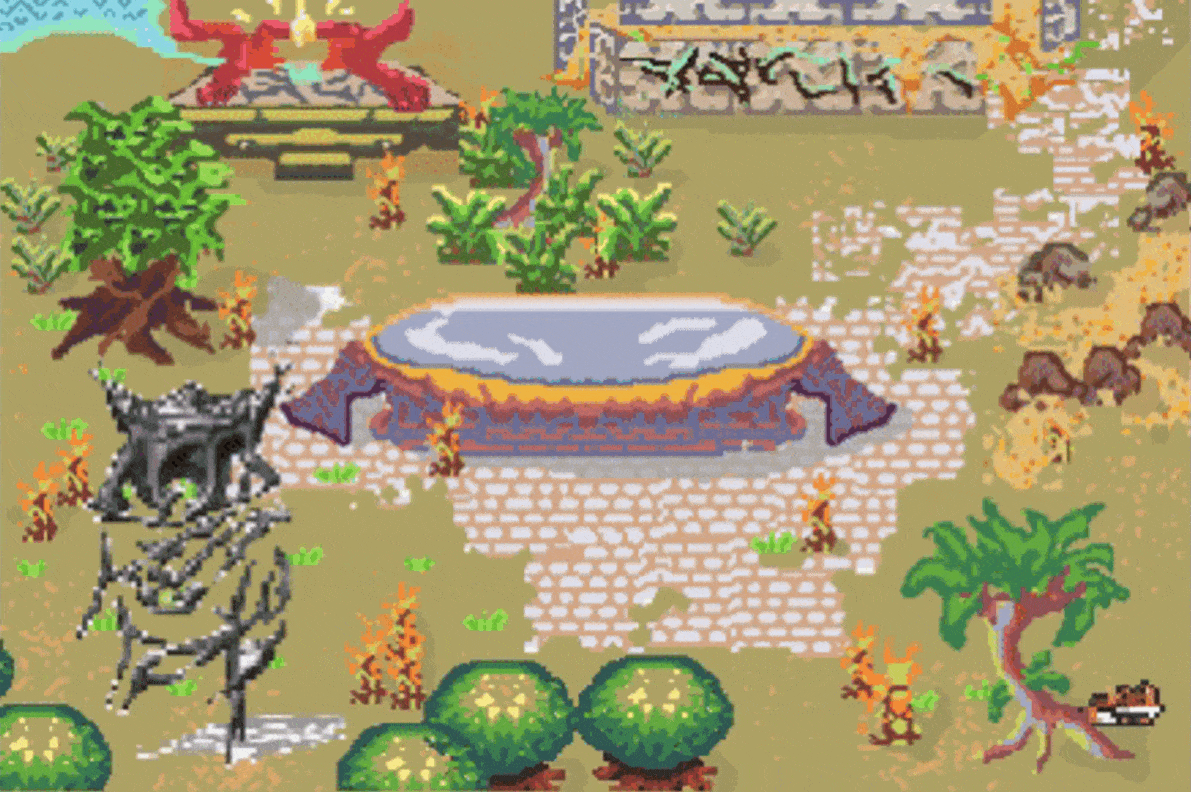
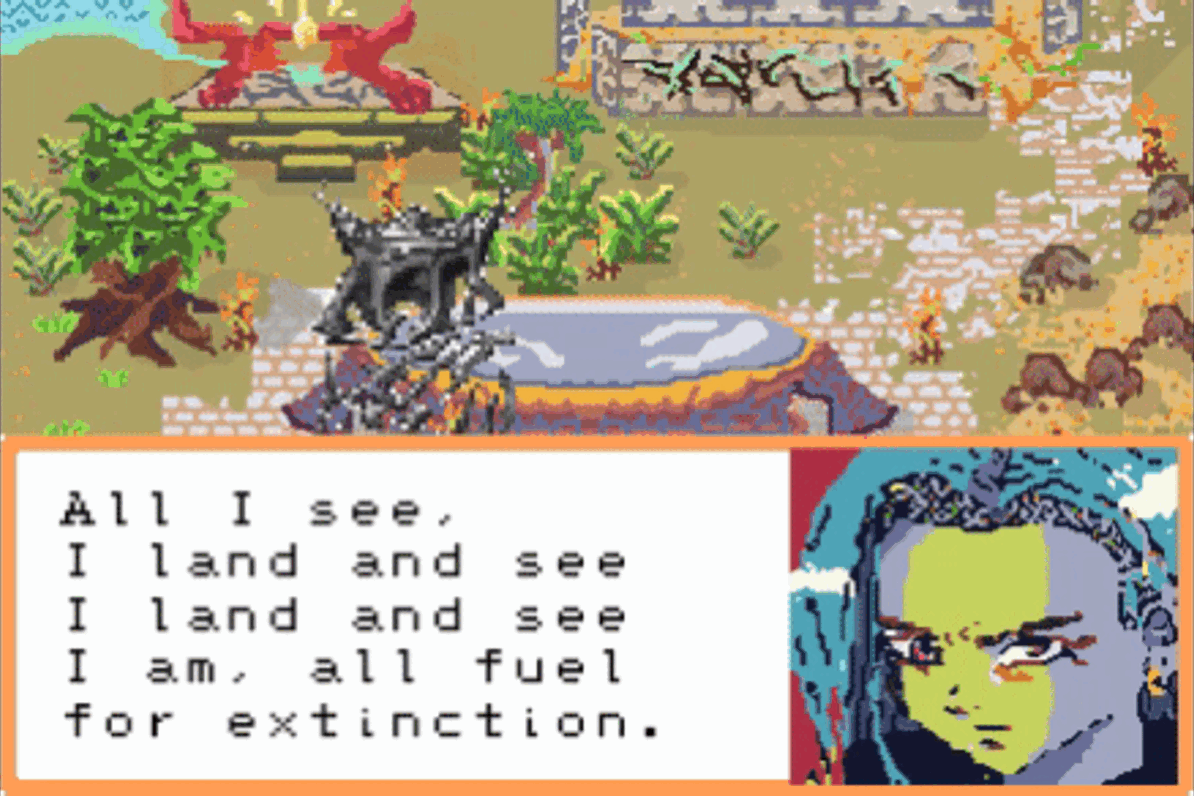
A platform as displayed here: “A court, an area, a space, the gate, where I can dwell, explore, play, search, land, to end, to open and to discover, this cover is just another environment I hover over.” Well, that doesn’t seem to be entirely true. See, a shatter of it hit me in my area so ignorant of what I could possibly partake in. Completely immersed in aspiration, I fantasized about: You make very precise choices, when piercing through, the better the cut, the better the fit, might that be Balenciaga, Kansai, who cares? I carry.
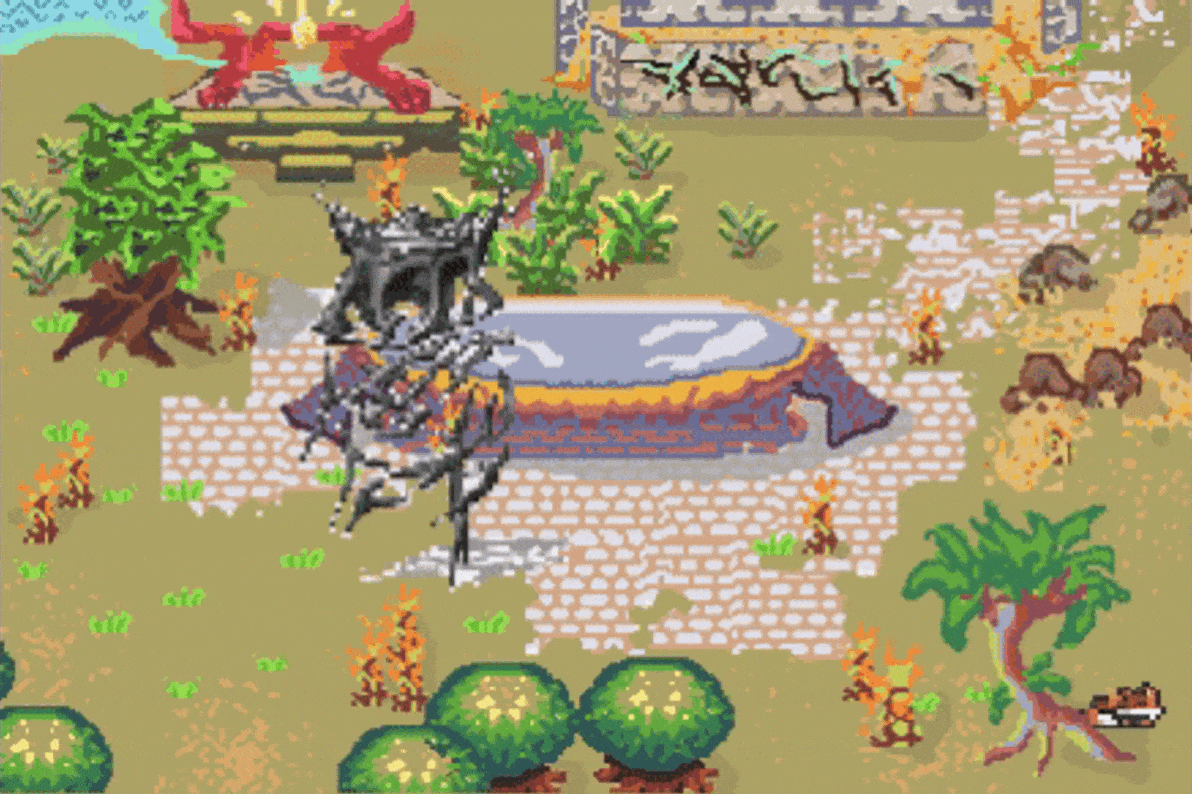
Well, Land, The environment, The almighty has spun layers of atmosphere, even beyond the exosphere, into bindings of scriptures and scrolls; unrolling, all that lies latent within us, unveiling, upcoming, an extension of her belonging.
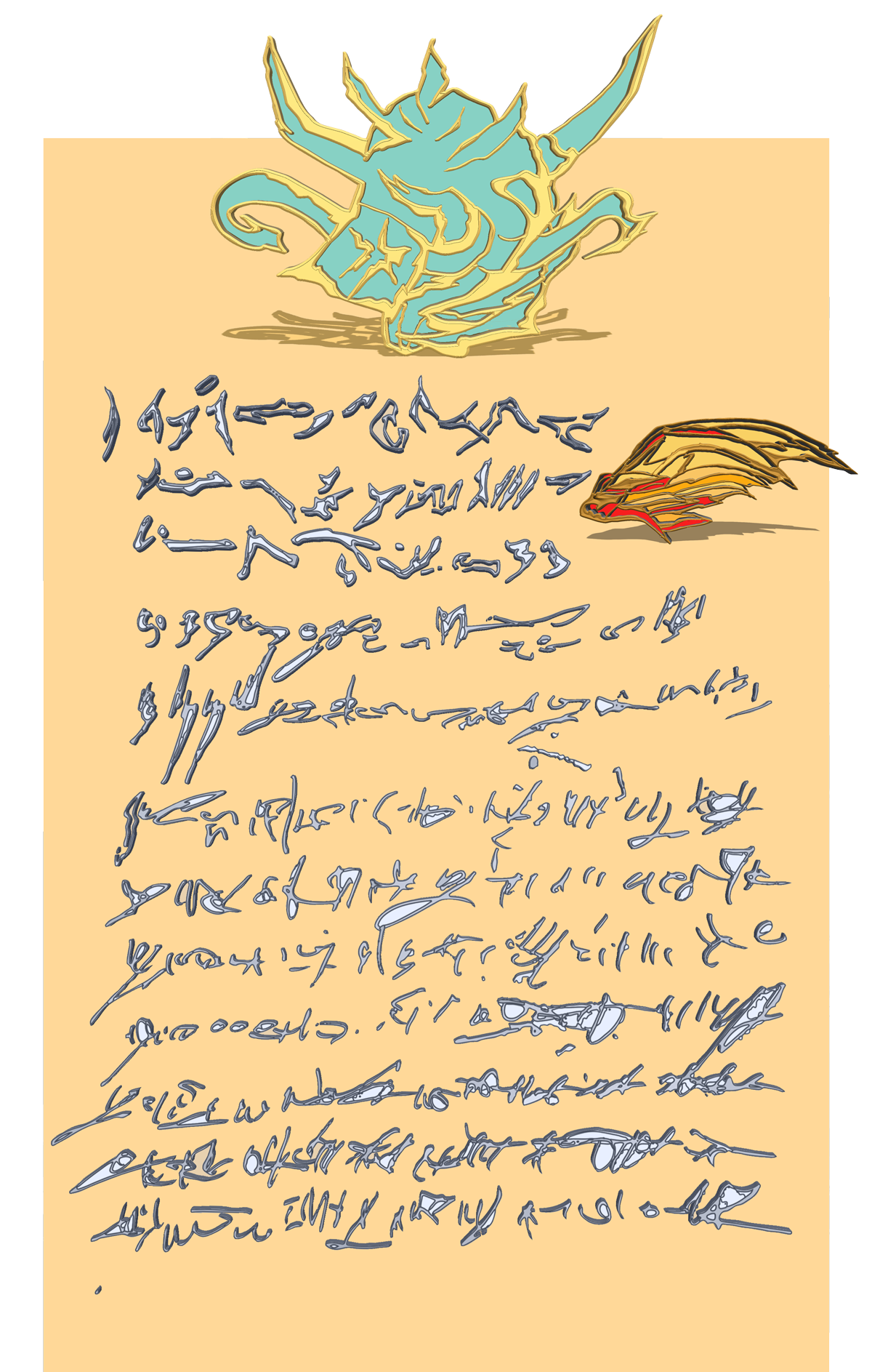
I believe these matters can be rendered through many things, such as: tokens, portable icons, cards, sports relics, sacred artifacts, all of them waiting to be evoked. Keep it closed and sealed, it will rest in its possibility to be anything, have any value, but might it be that its real value only comes through when taking matter into your hands when taking off its sacred seal when taking the cards in your hands, and let them strike, may they hit where the heart fits! Speaking about the latter, like I always say: Love, play, and conduct your game and manifest whatever it is you hold in your heart. Here, now, something is casting its shadow over the landscape. Let it also cast a spell, for it will enlighten us with its essence.
THE ORACLE
as disclaimer
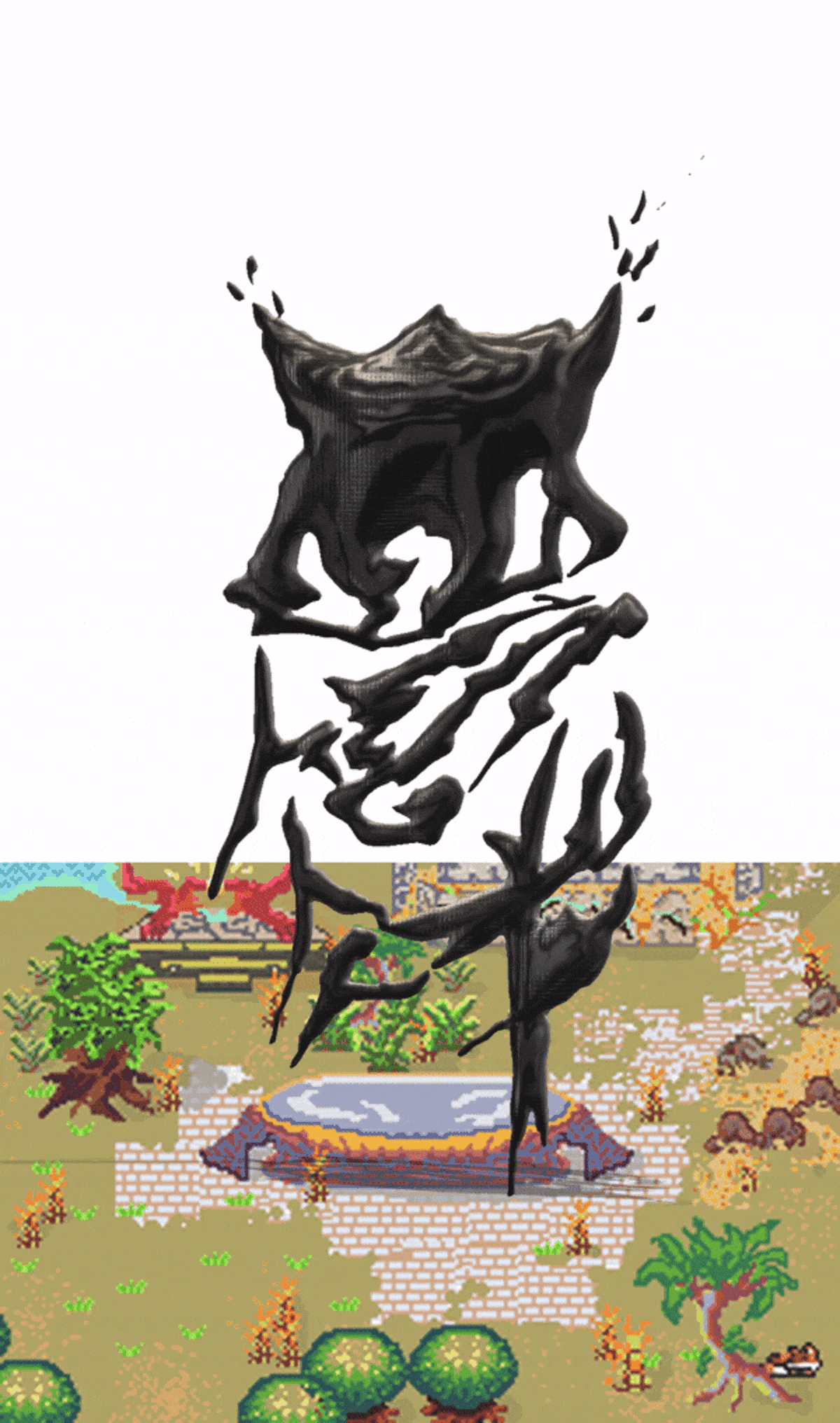
She will generate all, she makes her words come into being; spell into life She will twist her tongue until no tale remains untold For she will speak in any language of enemy and ally She will facilitate the mayhem of your time She ought to turn and you continue She ought to repress herself until the day the ignoble regime has been turned over Into you For you will lift your spirits For she will grant you forgiveness And nothing will be forgotten Every effort, even the trembling of the spine of a leaf You might exhaust it all Still, her plains stretched at your sight, you regard them no longer But turn to the view of infinite suns Burning spear, piercing through all the bigger sphere Whenever you extinguish. Your ashes onto the earth For All, I will give you ground, on which you can rise Until the last has been generated I will gyre around you, demise you You might make moves of opposition and expose yourselves However, in any endeavor I trust that the nature you find Is my constellation, aligned and assigned to the words: “No one can deliver from thy hands” Then finally “I land and see“ “I land and see” All seems to fall on her surface now In place, because, anywhere is where she wields the parting glass Until her brightness deems the sever undone
A witness of the oracle: And there it is: no journey for me to embark on and mark, oh, solely by my theory. It seems; this environment, it is a force field in which we can maneuver; it gives rise to events strung together by time. It is there where plains and players reside in suspense, sparking depictions of their own dynamics into life. The very subject that will let you in, is the one you feel for Take it to heart and in the rotation of the chrono, the parting glass might just bring out the better passes, we call dimes
THE FORCE FIELD
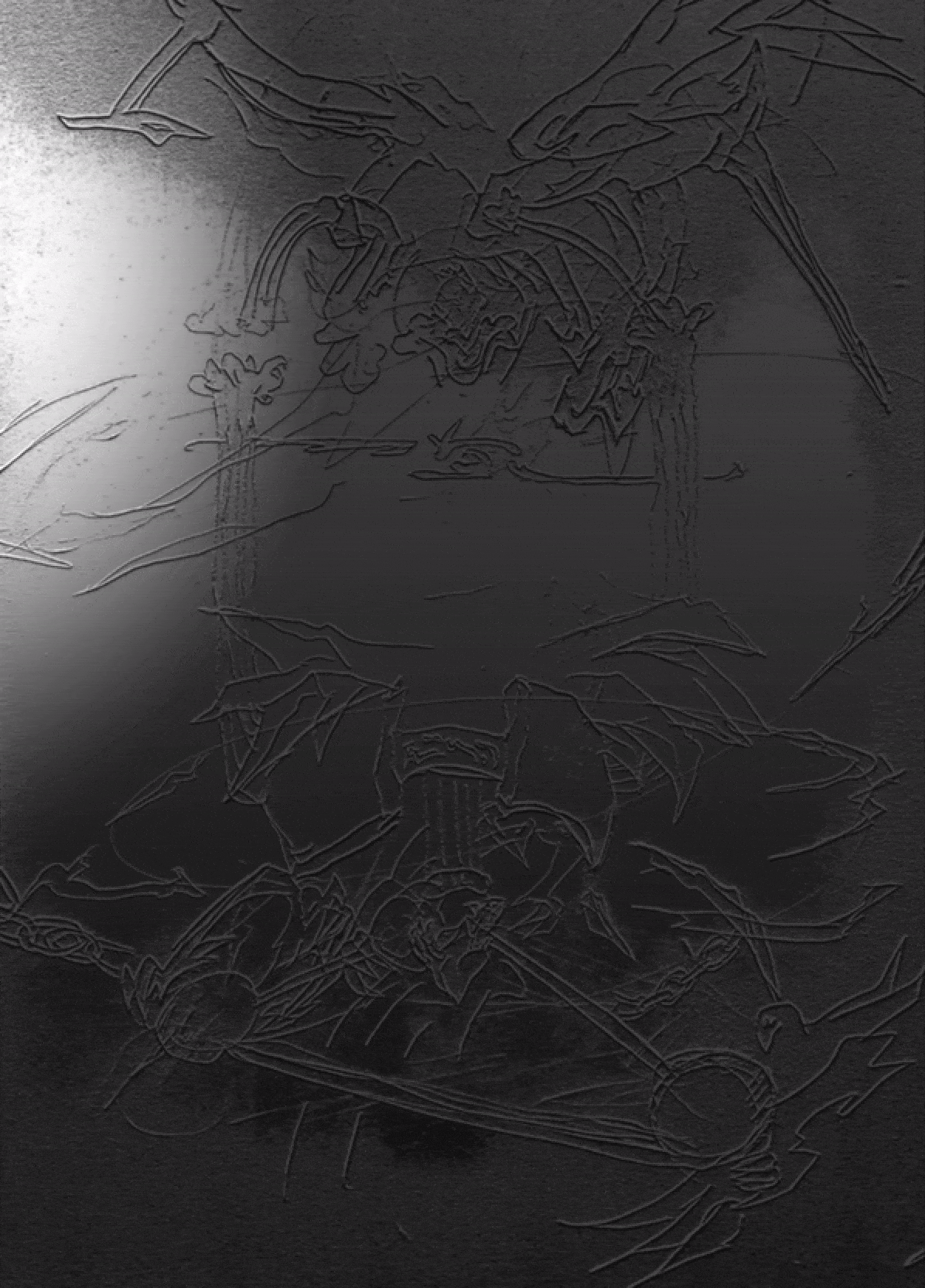
This force field is constituted by some basic principles:
- Creating a court/ platform/ battlefield - Expanding and transcending borders
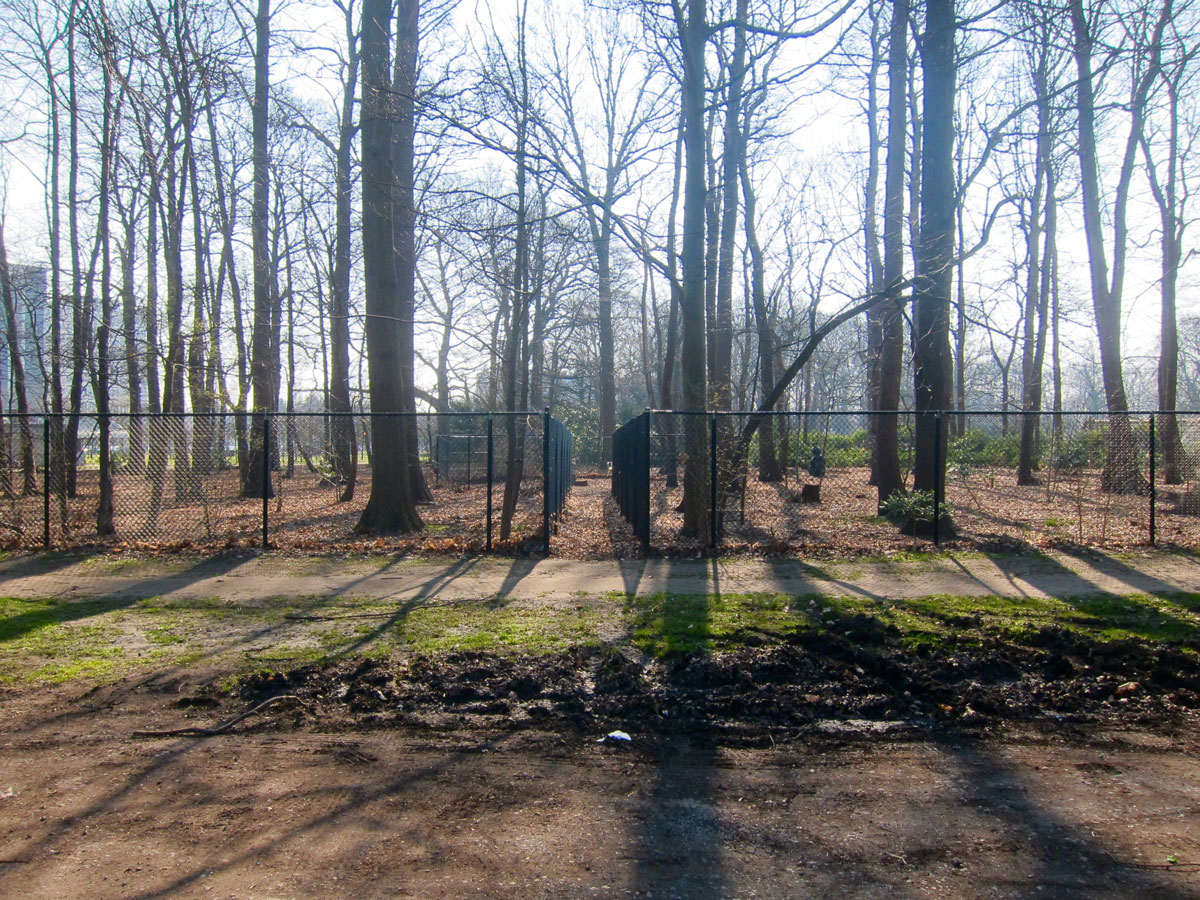
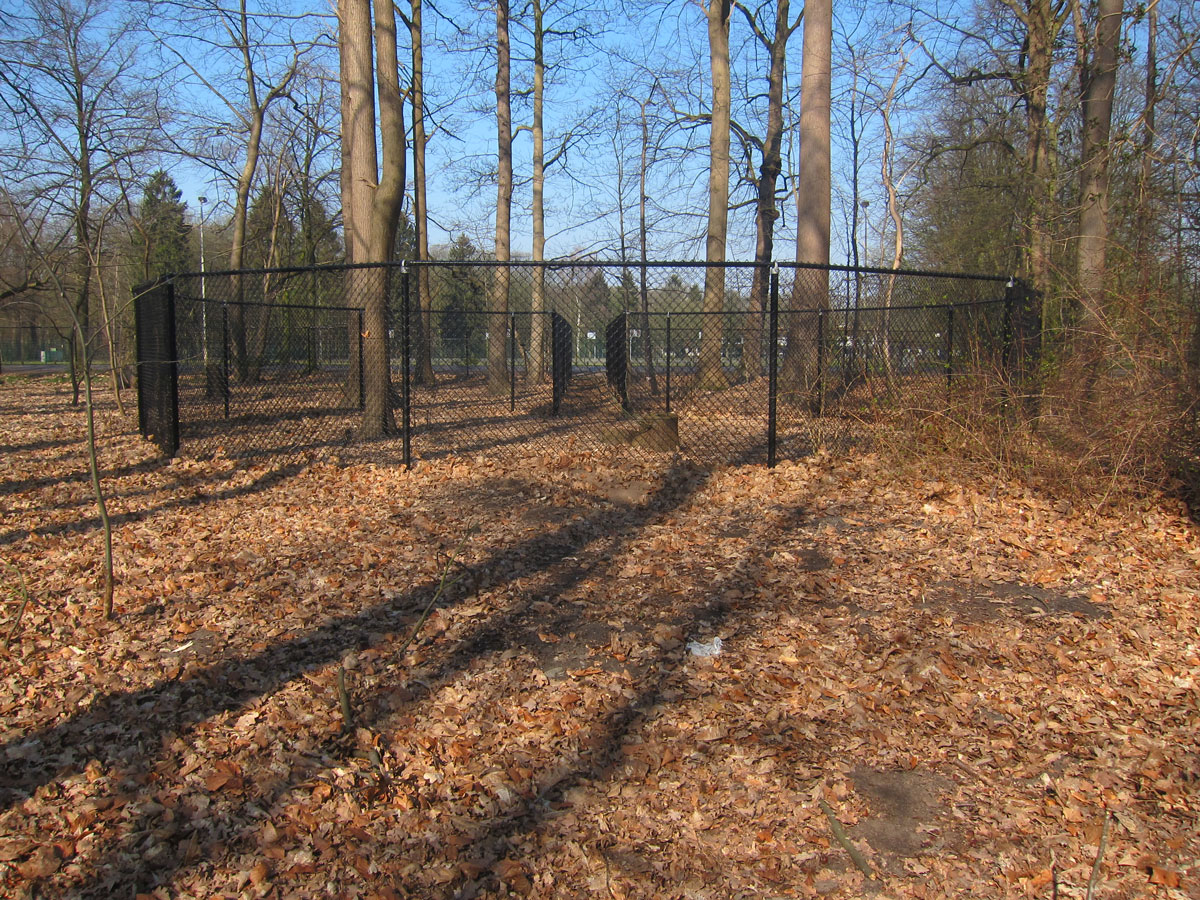
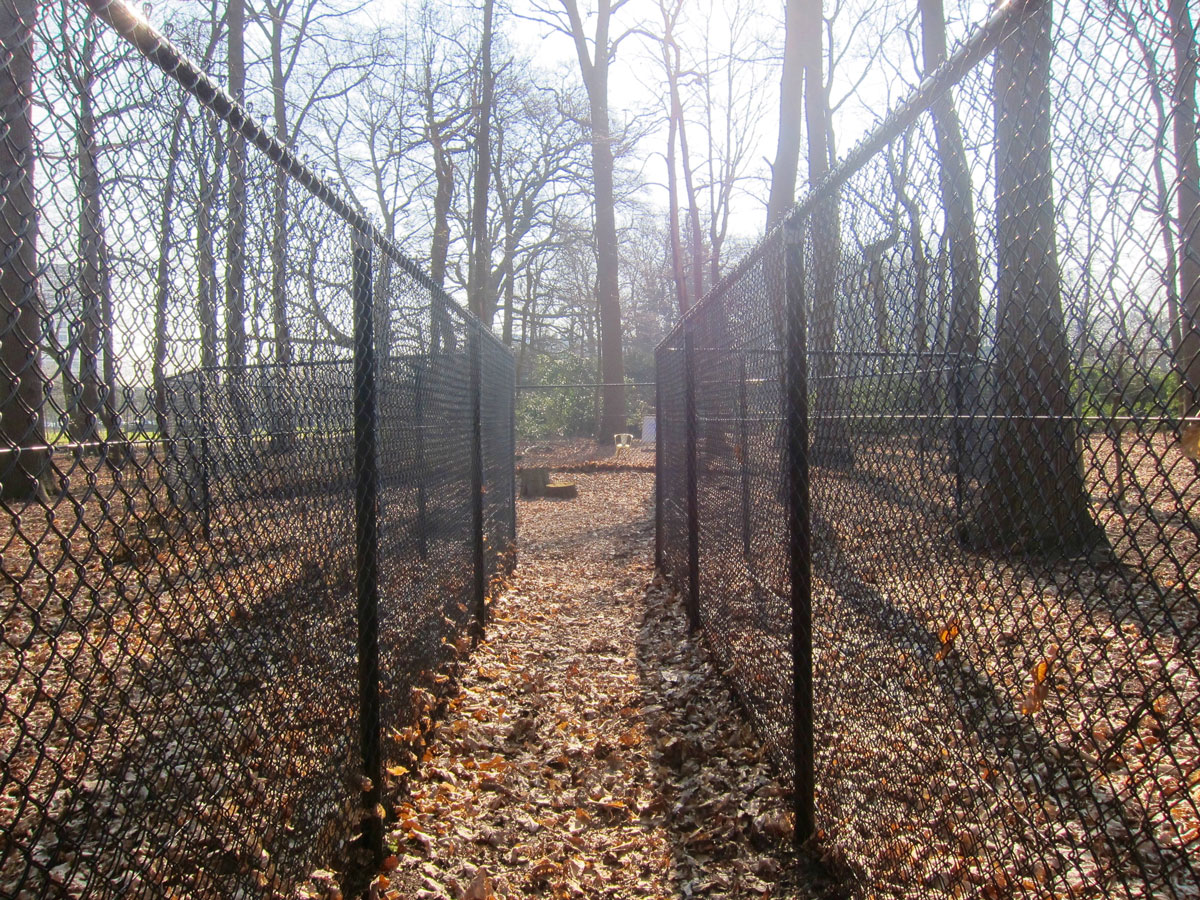
- Seeking to generate energy, giving life - Learning what’s close to one’s heart - Exchanging between realities - Generating its nature
Extract from Beigoma the movie, 2020
- Venturing with other players - Referencing spiritual realms
Hi, I’ve been sensing you for some time I like to feel you when your leaves lie low (I like to watch you really closely) The Tree is dimming the schemes of the grass no drone could catch what we No passenger other than me will fetch What we shattered, I really like how you host me This charm and chant you are unveiling my hand, exposing all that lies latent, a cover, forever able to discover its most valuable inside, I will not let it slip through my fingers I know I am not a fleeting illusion, your essence speaks to mine, letting me know I can unroll my soil and give life, unstoppable you wrinkling pool, touching my edges rejuvenating my senses Hosted by every ripple you cause at me Your spirit lies in every endeavor I can chop off a piece of wood and adore it Eventually, trespassing the root And I have left you, but the certainty of Your presence will stay in me When I land and see you, pool glaring in my eyes Surrounded by your proxies of divine dwellings Deeper and deeper, I understand I had to come My chest exposed to the fiercest strain, the sun we will be done, whenever, wherever, we roam; the sun, shines, glaring, my eyes, glancing, my mind, gone, we roam
Park walk Hymn, Mutoko: Mathias MU & Amber Vanluffelen, 2021
b
clustered | unclusteredEmbodied Knowledge
Thomas Moore, Agency, Ode de Kort, Florian Dombois
Movement operates from the middle of things.
— Bojana Cvejic, “How open are you open? Pre-sentiments, pre-conceptions, pro-jections,” in Sarma (October 2004).
Conductor as Subject.
An analysis of Alexander Khubeev’s Ghost of Dystopia (2014, rev. 2019)
Thomas R. Moore
Introduction
“Khubeev’s work is as much spectacle as musical experience; in this piece, conductor Thomas Moore was chained to the podium, his gestures the result of attempts both to gain musical control and break free. Though Khubeev’s training is rooted in electronics, the sounds here were largely acoustic. But what sounds! The eight-piece, string-heavy ensemble creaked back and forth like a piece of rusty machinery on its last legs: an ugly but utterly compelling piece of musical grunge.” (Reynolds, 2016)1
Reynold’s review serves as an unambiguous introduction to Alexander Khubeev’s (°1984) Ghost of Dystopia for ensemble and solo-conductor. The conductor, standing at the center, bound hand and foot to Khubeev’s self-made instrument, employs generally recognizable conducting gestures that generate the ‘grungy’ multiphonics. The instrument is a delicate web of glass, twine, and ‘acoustic sensors’2 that focuses the audience’s attention on the role of the conductor as the subject of the piece. In this paper I will first explore Khubeev’s score and self-developed gestural notation for the solo-conductor. I will then explain my analysis of the conductor’s shifting role from chained soloist to brutal dictator and its dystopic development throughout the piece. Lastly, I will detail detectable artistic and socio-economic motivations for utilizing a conductor in Ghost of Dystopia.
Specifics of the piece
— Alexander Khubeev (b. 1984): Ghost of Dystopia, written in 2014, revised in 2015 & 2019
— The 2015 revised edition was premiered during the Gaudeamus Muziekweek in Utrecht, The Netherlands. The 2019 revised edition was premiered during Klara Festival in Brussels, Belgium. Both were performed by Nadar Ensemble and Thomas R. Moore, conductor.
— Orchestration (2015): flute, clarinet, piano, percussion, violin, viola, cello, double bass, and conductor with acoustic sensors.
— Orchestration (2019): flute, clarinet, piano, percussion, guitar, violin, cello, and ‘conductor’ with acoustic sensors.3
Reading the score
Alexander Khubeev developed a new instrument for Ghost of Dystopia that resembles a spider’s web made up of sixteen ‘acoustic sensors’. A conductor-like-figure4 stands at the center of this web and is bound hand and foot to sixteen plastic boxes of various shapes and densities. These boxes, with the open end facing downward, scrape along eight glass panels (two boxes per panel), pull hem and haw by the conductor’s gestures and generate unique multiphonic sounds. In the legend prefacing the score, Khubeev has indicated the general tuning of the sensors and their placement on the glass. The lower sounding boxes are attached to the ankles. The middle range is fixed to the knees and elbows and the higher boxes are bound to the conductor’s fingers.
Khubeev developed a specific notation for the conductor’s movements (see figure 1). It has two staves and has been written into the score above the strings and below the piano and percussion parts. The upper stave is for the right side of the body and the lower for the left side. Like a percussion part, no traditional clef symbol is used. Instead, Khubeev has marked the beginning of each stave and system with elbow and knee symbols; above the elbow symbols are five additional lines that correspond with the five fingers on each hand. In total there are six lines per side for the arms and hands and two per side for the knees and ankles. The piece begins in this manner and continues so until the end of measure 56. From measure 57 until the end, the conductor’s score delineates combined movements for the upper body (fingers, hands, and elbows) while keeping the movements for lower body (knees and ankles) independent.

The conductor’s movements have been severely restricted by the composer. Any extra movements, such as turning a page in a score, would generate excess sound from the acoustic sensors. Therefore, out of practical necessity, the conductor’s part is displayed on a video monitor and shown in the form of a video score. A click-track, audible to all musicians via headphones, is synchronized with the conductor’s video score. This ensures that the pages are automatically turned at the correct moment and assists the ensemble with temporally synchronizing their performance. Here the dystopic duality of the conductor’s role in this work becomes apparent. By chaining the conductor, the composer ensures that every movement is audible, punishing any surplus in the harshest of screeching fashions. And yet, conducting is a movement-based musical practice. Musicians and audiences alike expect specific gestures5 from a ‘silent’ conductor6 that facilitate a musical performance in everything from entrances to temporal synchronicity. Both the click-track and especially the chaining instrument strip Khubeev’s conductor of their silence and a great deal of their facilitating functionality.
Analysis Method
Similar to my analysis of Alexander Schubert’s Point Ones (2012),7 I was able to divide the conductor’s role in Ghost of Dystopia throughout the piece into two polar functions: a soloist’s role and the more traditional post as ensemble conductor. There are measures in the piece when the conductor is completely focused on the ensemble, conducting every detail and showing every beat. There are also measures when he/she acts entirely as a soloist. Also, but only sparingly, he/she takes on both roles simultaneously and conjunctly. When simultaneous, the balance between the two roles is sometimes, but not always, equal, either leaning more towards soloist than conductor or vice versa.
To better understand and visualize this, I created a chart assigning each of the five above-described situations with a number. I used the number ‘one’ to represent a conventional conductor-ensemble relationship. The number ‘five’ represents the times at which the conductor acts as a soloist. The numbers in-between (‘two’, ‘three’, and ‘four’) are used to represent the parts in the piece when the conductor is both soloist and conventional conductor, with ‘two’ leaning more towards acting as conventional conductor, ‘four’ representing more of a soloist, and ‘three’ equaling balancing the two roles. The entire chart can be found in the appendix.
I will first describe each of the categories and where they can be found in the piece. Then I will apply the analysis and detail the results in terms of structure and measurable trends.
Category 1. Strictly conventional conducting
Khubeev waits until the final third of his piece to offer the audience, the musicians, and the conductor-soloist the chance to experience functional conducting gestures that are clearly linked to the material performed by the fellow performers on stage. In measures 130-139, the conductor is instructed to display a dry, dictatorial (even harsh) two-beat pattern. At regular intervals the conductor must also use his/her left and right hand to indicate a combination of glissando and crescendo by moving an open palm, arm extended, from low to high. This corresponds in a stereo fashion with the ensemble: Left hand = left side of the ensemble and Right hand = Right side of the ensemble. As shown in the example below, the choreographed (physical) gestures have a direct correlation with the musicians’ parts (see figure 2).

In measures 145-149, the conductor’s movements are also clearly linked with the musicians’ material. However, this time Khubeev has choreographed non-conventional conducting. The conductor improvises full arm, clock-like gestures that coincide with the rhythms in the musicians’ parts, utilizing minimum gesture for maximum effect from the ensemble. These measures can be viewed by clicking on the following link: https://youtu.be/fpPTaMCQ3YY?t=599

In the final twelve measures of the piece (m. 153-164), the conductor’s role verges upon the ritualistic. As the piece ends, the conductor raises his/her arms – starting very low, until they are pointed up towards the ceiling and extended in an open, Christ-like gesture. His/her movements correlate with a long crescendo in the musicians’ parts, bringing the ensemble’s role in the piece to a close and at the same time displaying the conductor’s freedom from the plastic box and glass plate instrument. During an interview, Khubeev indicated that these gestures are intended to create a kind of doubt over the fate of this newly arisen conductor-come-dictator.8
<5 class="secondsubtitle">Category 2. Mostly conductor combined with occasional responsibilities as instrumentalistOn rare occasions (6% of the piece), the conductor in Ghost of Dystopia combines fully conducting the ensemble with just a small amount of focus on the solo instrument. This is mostly because, by being bound to the instrument, the conductor’s conventional freedom of gesture has been severely limited. To find sections in the piece that fall into this category, I first had to look for places in which the sound generated by the conductor’s movements is a secondary effect of conducting-like gestures. The first example occurs in measure 43. The conductor has a crescendo both in the right elbow and the left knee that ends with an accent at the last possible moment in the measure. The piano has the same effect in both hands. Conventionally speaking, the pianist will look to the conductor to precisely time his/her accents.9

A similar situation occurs in measure 56. The conductor has a crescendo indicated in the left hand that ends with an accent at the last possible moment of the second beat of the measure. This coincides with the strings’ parts.

In measure 94, the conductor combines both non-functional conducting (solo) with a small movement at the end of the second beat that could be viewed as conventional conducting. With his/her entire left hand, the conductor moves rapidly to create a crescendo to forte and then abruptly stops with an accent at the last possible moment in the second beat. The flute, bass clarinet, and percussionist have exactly the same (timed) accent. In a similar fashion to the two examples cited above, the conductor’s movements could be considered to assist and unify the musicians’ parts.
Category 3. An even division of tasks: instrumentalist and conductor
In measure 57, the notation of the conductor’s part shifts from two eight-line staves to two three-line staves. Khubeev now writes for the hands in general (all five fingers and elbows acting in unison) and uses separate graphic notational lines for the acoustic sensors connected to the knees and ankles. (In total three lines: hands, knees, and ankles) The switch in notation coincides with two other events in Ghost of Dystopia. This is the first time during the piece when the conductor is equally both soloist and conventional conductor. It is also the first time we see the composer-choreographed use of recognizable conducting gestures in each hand.
Starting in measure 57 and continuing until measure 66, the entire ensemble, except the conductor, plays dynamically and rhythmically in unison. The conductor fills in the gaps, suffusing every rest that the ensemble has with a multiphonic reply. The gestures for the conductor are as follows:
During the conductor’s rests: freeze, highlight the ensemble (hands open, in front making a displaying/featuring gesture.)
During the conductor’s playing: make sharp down and up movements. (recognizable conducting gestures: ‘up’ and ‘down’ beats)
A second example can be found when the conductor makes a visible and audible (all the conductor’s movements are audible in this piece) decrescendo that begins in measure 73 and continues until the beginning of measure 79. The ensemble first makes an orchestrated (fewer and fewer musicians play) and then a performed (individual musicians decrease volume) decrescendo in the final measures. It could be argued that the conductor’s movements, like conventional gestures, guide the musicians from their loudest to their softest. His/her movements and the speed thereof also quite literally help to determine the collective volume of the piece.

Category 4. Mostly instrumental soloist combined with little actual or apparent conducting
It can be argued that thanks to performance rituals, any movement a conductor-like figure makes can be perceived by the audience (and the musicians, too) as a meaningful, and musically loaded gesture intended to influence the performance of the live musicians.10 Simply by standing in front of a group of classically trained musicians and in front of an audience who are attending a concert that takes place within the Western art music tradition, one could perceive the soloist in Ghost of Dystopia as a conductor. With that in mind, there are a few moments in this piece in which the solo-conductor is clearly acting in a solo role and his/her movements can also be interpreted as conventional and functional conducting gestures. Such an instance can be found in measures 106-114. The ensemble has been split into fixed duos (flute and clarinet, piano and percussion), a string trio (violin, viola, and cello) and another soloist (the double bass). The conductor-as-soloist regularly accompanies these groups. (See figure 7.)

Category 5. Completely and solely instrumental soloist
Ghost of Dystopia opens with miniscule sounds and physical gestures. These pianissimo events originate with the conductor and resonate throughout the entire ensemble. The sounds are sharp multiphonics generated by scraping plastic containers across glass plates and drawing well-rosined bows along the hard edges of plastic boxes. The conductor’s instrument is similar to the prepared conventional acoustic instruments present. A single (physical) gesture is directly linked to sound. One tug of the finger creates an audible plastic multiphonic. A raised (or lowered) arm creates a mass of sounds. All of this occurs in real time and can easily be perceived by a visually attentive audience: one movement equals one sound.
For the entire first section of the piece (measures 1-41), the conductor is clearly and solely focused on operating the instrument to which they are bound. The choreographed (physical) gestures found in the conductor’s score are written in a style similar to a percussion or piano part: each plastic box has its own line in the score (see the figures above). And, like all the other performers on stage, not a single note in these first 41 measures is played in unison with any other player. Besides the conductor’s physical position in the ensemble, there are at this point in the piece no other indications that the conductor’s physical gestures can be interpreted as anything other than instrumental. Thus, they are in no way conducting the ensemble.
This dedication to the instrument returns several times throughout the piece. I will examine three moments in particular. The first begins in measure 89 and continues for five measures. The conductor employs movements during these measures that can be described as non-functional conducting patterns. In other words, the audience can perceive the physical gestures that have been choreographed by the composer as movements a conductor might normally make in a conventional setting. However, the movements have no direct apparent correlation to the notes played by the other performing musicians.

As in Schubert’s Point Ones, an aesthetically similar piece for augmented conductor and ensemble, the conductor in Ghost of Dystopia is granted the opportunity to perform an exciting and dramatic cadenza, the second example of category five. However, instead of drawing the audience’s attention to the conductor’s grasp upon the live electronics, the solo in Ghost of Dystopia is quite literally liberating. If the solo cadenza is played with enough (and suggested by the composer)11 enthusiasm and wildness of (physical) gesture, the connections between the fingers and the acoustic sensors will snap. The goal of the conductor during the cadenza is to break the strings that bind him/her to the boxes. Again, the conductor is focused solely on the instrument, only at this point in the piece the direct connection between physical gesture and sound deteriorates.
Measures 140-144, the third example, are preceded by eleven measures (to be discussed below) in which the conductor for the first time clearly conducts the ensemble in no conventional manner whatsoever. In these bars, the conductor continues to utilize conventional conducting patterns; however, they no longer have any correlating effect on the performing musicians. By this point in the piece, it is also entirely possible that all the strings binding the conductor to the instrument have been completely broken. If that is the case, the conductor’s movements are entirely non-functional: there is no direct acoustic link to the instrument and there is also no perceivable reaction from the musicians. His/her movements are futile and conceivably a dystopia settles in: The soloist flails without an instrument and simultaneously wildly conducts a non-adhering ensemble.
Structure: from Chains to Dictatorship
When the methodology above is applied to Ghost of Dystopia, the analysis results in a dramatic story told in three parts. The conductor begins the piece on equal footing with all the members of the ensemble. Throughout the first section of the piece, he/she attempts to rise above the other musicians only to fail and rejoin the group for section two. By the time we get to the cadenza the conductor has succeeded in breaking free and celebrates as a soloist. Section three sees the conductor commanding the other musicians first in a conventional, brutal 2-beat manner. He/she then progresses to the point where only minimum gesture is required for maximum effect from the ensemble. At the end of the piece, Khubeev has the conductor take up a Christ-like pose, generating an intentional ambiguity with a chain-muted gong strike from the percussionist, asking: Is the conductor dead? If so, who killed him/her? Society? Or has the dictator become a god?12
Section 1
Section 1 begins with the first movement of the conductor in the very first measure of the piece and continues up to and including measure 56. The conductor’s movements are all primarily dedicated to the movement of the acoustic sensors (plastic boxes) across the glass plates. At rare moments in this first passage, such as in measure 43 (described above) the conductor seems to step briefly out of the role of soloist and functions as a quasi-conductor. That said, all the movements are strictly utilitarian and do not venture close to anything that could be recognized as conventional conducting gestures. Characteristic of this section is the link between sound (the acoustic sensors) and physical gesture (the movements of the conductor), which is abundantly clear to a visually attentive audience.
Section 2
Section 2 begins in measure 57 and continues all the way until the end of the conductor’s cadenza in measure 129. Distinctive to this section is the use of non-functional conventional conducting movements. These can be found and are introduced in measure 58. To this effect, Khubeev alters the notational style of the conductor’s part in measure 57, switching from the (in total) sixteen-line stave to a six-line stave. In the first section, Khubeev used traditional note-head notation in the conductor’s score. From section 2 onwards, the conventional conducting gestures are notated using graphic notation, vertical lines in the stave used to indicate movements in the hands. Although it seems conceivable that the conductor-soloist’s movements found in measure 58 and then later in measure 89 can be recognized as those a conventional conductor would employ, no discernable link can be found between the sounds produced by the musicians and the conductor’s movements. The conductor’s physical gestures are therefore non-functional in any traditional sense.
Section 2 culminates in a measured and improvised conductor’s solo: a cadenza.13 The notation during the solo is graphic and extremely difficult to replicate from one performance to the next. According to the composer,14 the conductor should attempt to break free from as many of the acoustic sensors as possible in the measures leading up to the cadenza, and especially during it. During any given performance, the fasteners that hold the strings to the soloist’s appendages break in a random order. For example, sensor 1 may break off first, followed by the 7th, 16th, etc. In the next performance the breaks may first occur on the opposing side of the instrument. Both this lack of predictability and the graphical notation can lead us to the conclusion that a certain amount of improvisation is required to perform this solo.
Section 3
After breaking free of the instrument (or as much of it as possible) the conductor is now free to openly conduct the ensemble. The final section of Ghost of Dystopia begins in exactly that fashion, and in a rather exaggerated manner. During the first ten bars of Section 3, measures 130-139, the conductor gesticulates an overtly, even brutally, clear two-beat pattern with both hands. The two beats are equal eighth notes and can be understood by a visually attentive audience to coincide with the rhythms being produced by the musicians. In addition to the two-beat pattern, the conductor is instructed to employ a traditional physical gesture for crescendo: an open hand moving from low to high. These gestures coincide with glissandos from low to high and crescendos that are performed by the musicians. Furthermore, the glissando/crescendo combinations are performed in stereo. The instruments seated on the conductor’s left-hand side are grouped together and so are the musicians on the conductor’s right-hand side. The conductor’s glissando/crescendo gestures are also made in a stereo fashion: left arm for the left side and right arm for the right side (See Figure 3).
In measures 145-149, the conductor shifts from functional conventional conducting patterns to functional non-conventional conducting gestures. The conductor and musicians have exactly the same rhythms in these measures. However, the conductor’s physical gestures could not be said to be recognizable as conventional conducting movement repertoire. Instead, Khubeev has instructed the conductor to: (see also Figure 4)
From bar 146 till the fourth beat of bar 149 “conductor” starts to make wide movements with straight hands in different directions on each beat. Then (from fourth beat of bar 147) he/she adds separate arm movements on each second eighth note, then (bar 149) adds separate wrist movements on each second sixteenth note for three beats.15
Measurable trends
Instrumental Soloist to Ensemble Conductor
Over the course of Ghost of Dystopia, we see the conductor-like figure make a transition from instrumental soloist to ensemble conductor. This does not happen linearly. There are even moments in the final section when the conductor regresses to an instrumentalist’s role (though dysfunctional: the instrument at this point is no longer in any playable state). In Section 2, the soloist first has choreographed conductor-like movements, however the composer has also written passages in which the audience could perceive the conductor as purely an instrumental soloist. However, in the large arc of the piece the conductor-soloist begins as an instrumental soloist in Section 1, then becomes a soloist utilizing conductor-like gestures in Section 2, and finally in Section 3, takes on the mantle of an ensemble conductor.
Bound to Free
When the transition described above is viewed from a different perspective, it becomes apparent that the conductor-soloist evolves from being completely bound to enjoying and even rejoicing in their freedom. Before a member of the audience has even entered the performance space, the conductor will already have been bound to the instrument. To ensure that no sound escapes the instrument, the conductor must remain completely still while the audience takes their seats. Only once all have subsided to silence may the conductor finally move. The initial physical gestures are all minute, miniature, and pianissimo movements. Throughout the first section, the conductor and ensemble as a whole gradually get louder and are afforded more freedom of movement.
With the commencement of the conductor-like movements in Section 2 and especially during the cadenza-solo, the conductor-soloist begins to break free of the acoustic sensors that bind him/her. Each movement loses its exactly timed (gesturally linked) unique sound. Non-functional conductor-like movement is for a short time (dystopically) associated with an instrument that is also, with each snap of the string, losing its functionality.
After finally applying functional and brutally clear conducting techniques and breaking free of the last few cords binding him/her to the instrument, the conductor begins to slowly raise their arms up towards the ceiling. Is it a gesture of praise? Is it religious or sacred in nature? Might it represent death or deification? Khubeev’s instructions are as follows:
From third beat of bar 152 “conductor” very gradually raises his/her hands till they will be parallel to the floor (on the level of shoulder, hands directed to the right and to the left, palms up). In this “cross”-position “conductor” should stay until the first sound from audience (after the end of the piece).16

Why a Conductor?
I will conclude this paper by discerning what detectable artistic and socio-economic motivations are present for specifically utilizing a conductor as a soloist in Ghost of Dystopia. After all, this work is performed with the assistance of a click-track and video score, so there is no need to utilize a conductor to temporally synchronize the ensemble. Also, every move the conductor-soloist makes has been strictly choreographed, so there is no room for any sort of spontaneous, impromptu artistry17 or practical faciliatory gestures that one might typically expect from the conductor. Below, I present three broad categories of motivations. First, I examine economic considerations for deploying a conductor as soloist in this piece. Second, I consider Khubeev’s reliance on conductor’s movement repertoire. And lastly, I will argue that the composer required a conductor to serve as the subject of his Ghost of Dystopia.
Economic
When looked at in a broad sense, ‘the economy [can be] defined as a social domain that emphasizes the practices, discourses, and material expressions associated with the production, use, and management of resources’.18 A tradition of the conducted (new) music ensembles exists. The ‘practices, discourses, and material expressions’ of a new music ensemble would include the relationship between the musicians and a conductor – two of its resources. This relationship is defined by certain keywords and key-gestures. For example, as Paul Verhaeghe explains in his book Identity, within a group of musicians, when one suggests that the music should be more agitato or when a conductor prepares and then gives a downbeat gesture, all present would comprehend.19
Without this tradition and the group’s keywords and gestures, Ghost of Dystopia would be meaningless. It relies on the audience’s understanding that there is a traditional relationship between the cue-giver (the conductor) and the cue-followers (the musicians). In this sense, the presence of an economic utilization of a conductor by the composer is present and detectable in Ghost of Dystopia.
Movement repertoire
Building further on Verhaeghe and based on an in-depth interview with composer Simon Steen-Andersen, within the framework of the Western art music tradition, specific conductor’s gestures can be seen to be generally recognizable. Their meanings, though the details may be open to interpretation, are also generally understandable.20 For example a conductor’s downbeat is recognizable as a starting point. The gesture is a downward motion made with one or both hands, with an ictus, or perceivable bounce, at the lowest point of the movement. Specifically, the ictus itself is recognizable as the exact moment of commencement: the point at which a beat begins. We can expect that, within the context of a performance, both the audience and the musicians would recognize this gesture as a beginning.21
This gesture, the downbeat, can be found at many points in Ghost of Dystopia. It has been shown above to be both functional and non-functional. For this reason alone, the non-functionality of the gesture, we can conclude that Khubeev has utilized a conductor in this piece for artistic visual reasons. More specifically, Khubeev employs the recognizable conductor’s movement repertoire to generate sounds on the plastic and glass acoustic sensors.
In Section 3 of Ghost of Dystopia, the work enters the functional realm of movement repertoire. The movements of the conductor are now quite clearly traditional gestures, and they function in a conventional manner. The musicians align their rhythmical passages with the gesticulated tempos displayed by the conductor. As shown above, they also align the timing of their glissandos and crescendos with gestures found in the conductor’s movement repertoire. The crescendo, for instance, is shown by the conductor in a fluid motion, raising his/her arm with the palm open and the arm extended.
The gestures in this third and final section, however, are strictly choreographed. Unlike conventional conductors, who to a large part improvise their expressive gestures (such as crescendos), Khubeev has clearly indicated these gestures and their scope in his score. The downbeat gestures themselves can be recognized as part of the pattern for a 2/4 measure, but those particular measures (see above) are written in a 4/4 time signature. The conductor is therefore not even fulfilling the conventional role of matching his/her pattern to the printed time signature.22 However, the gestures themselves will be recognized as functional. This is a clear artistic use, by the composer, of the conductor’s movement repertoire. A conductor is utilized in Ghost of Dystopia to bring to bear the generally recognizable conductor’s gestures, practicing a gesture that would normally cause the audience to expect one sort of event, but dystopically and through non-functionality receive another.
Furthermore, there is evidence that Khubeev relies on ‘performance ritual’23 to ensure that his soloist will be perceived as a conductor. He/she is placed in a conventional position: the musicians are seated in an arc (an open U-form with the opening of the U facing the audience) and the solo-conductor stands, facing the musicians in the opening of the arc. An audience brought up in the Western art music concert tradition can be expected by the composer to regard the soloist as a conductor.
Conductor as subject
While the solo-conductor takes up a central ‘ritualistic’ position, his/her movements have been extremely limited with no room for impromptu movements typical to the conventional role (such as corrections or spontaneously assisting musicians with entrances).24 I have demonstrated above that physical gesture in the first section can be directly associated with sound, but the multiphonic sounds that all the musicians (including the solo-conductor) make are, at the composer’s design, sonically very similar. It is conceivable that, though at first a direct link between player and sound will be evident, by the end of the first section even a visually attentive audience will have a hard time discerning whose gestures are linked with which sounds. This differs from the conventional conductor’s role, in which nearly all the conductor’s gestures can be interpreted to be relative to the global sound presentation.25
The conductor-as-soloist, and the choreographed physical gestures in Ghost of Dystopia also undergo an evolution that commences before the piece starts and continues up to the final measure. The conductor begins, before the audience enters the hall by being bound hand and foot to an instrument that quite literally maps the slightest of movements. As the piece progresses, so do the gestures from simple and minute traces in the first section to non-functional experiments in conductor’s movement repertoire in the second section. And finally in the third section we see the completed evolution to actual and influential conducting.
To summarize, it is reasonable to conclude that the conductor is a/the subject of Ghost of Dystopia, because:
— The soloist has been physically placed (staged) in a position in which the audience would presume that he or she is the conductor of the piece.
— The conventional role of the conductor is brought into question in the first section through a more than usual direct association between physical gesture and sound: acoustic movement mapping.
— The conventional role of the conductor has also been brought into question in the second section by a composer-designed disassociation between conventional conducting gestures and the global sound presentation: non-functional conducting gesture.
— And finally, the conductor-as-soloist undergoes an evolution that is apparent to the audience and is, according to the composer, the subject of the piece. Simply put, Khubeev requires a conductor to tell his tale of the rise and fall of a dictator.
Conclusions
Above I have demonstrated that Ghost of Dystopia begins by employing functional instrumental playing that transforms in three sections to a conducted ensemble piece. Functional movement is utilized throughout the entire first section: one movement equals one sound. As the piece progresses, the functionality of physical gesture (especially of the conductor’s movements) diminishes towards (sometimes futile) non-functionality. This coincides with a literal breaking free of the instrumental bindings.
I have also found three detectable motivations for utilizing a conductor as soloist in Ghost of Dystopia. The placement of the conductor-soloist, the link between gesture and sound, dysfunctionality of movement and the publicly palpable transformation of the performing role of the conductor-soloist all determine that the conductor-soloist is the subject of the piece. Key-gestures and the tradition from which they come (the conducted ensemble) are an important economical element to Ghost of Dystopia. Finally, Khubeev artistically utilizes the conductor’s movement repertoire as a visual component throughout this piece, both in functional and non-functional form.
Appendix
Appendix I – Legend
Download the file here.Appendix II – Analysis Chart
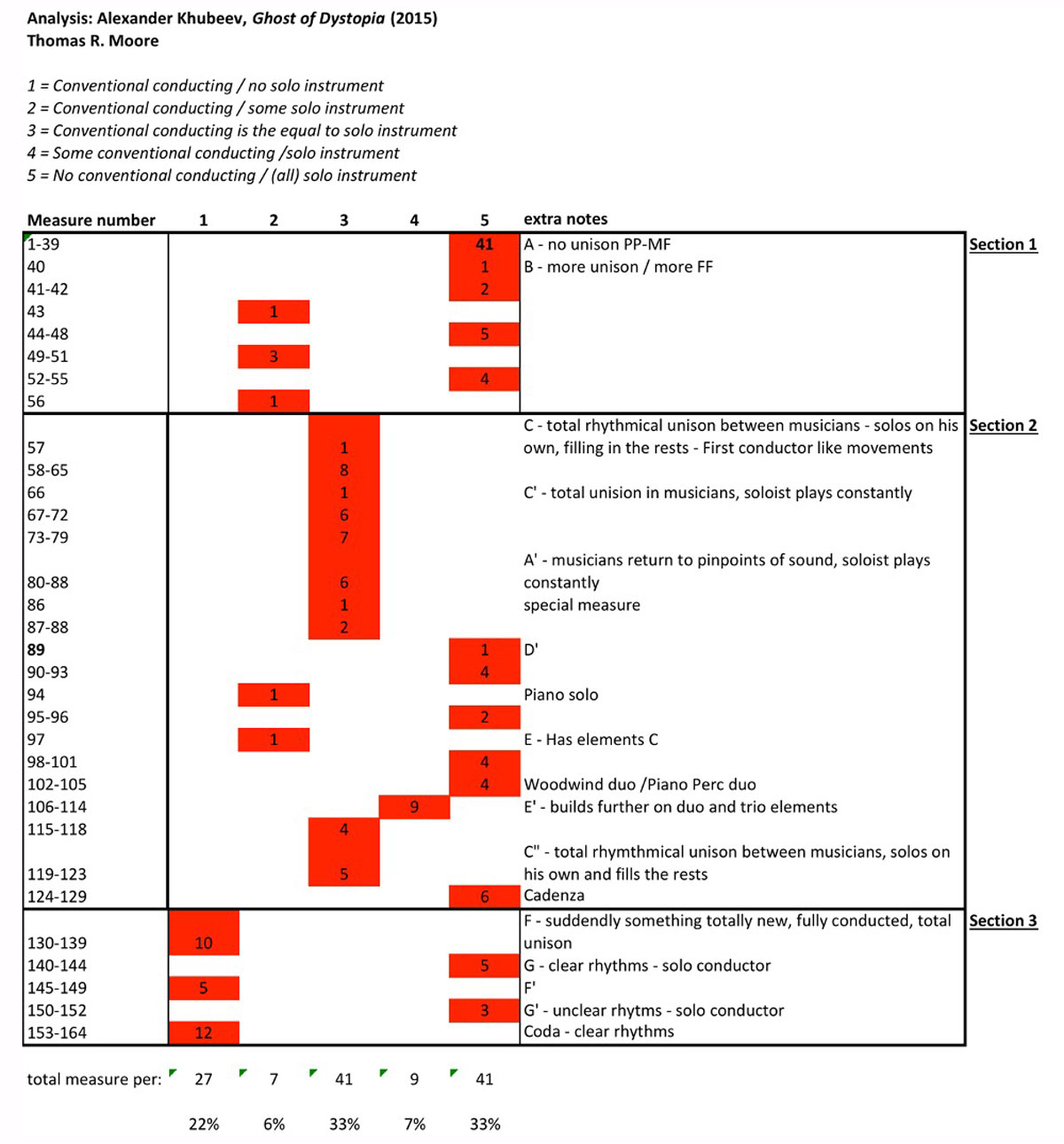
Notes
- 1 Peter Reynolds, “Transit Festival, Leuven, Belgium,” in: Tempo, 70(276), 85-87, 2016.
- 2 Alexander Khubeev, “Ghost of Dystopia” (Score, Moscow, Russia, 2015).
- 3 This analysis will refer to the revised score that was published by the composer in 2015. Though the piece was revised in 2019 for a smaller ensemble, the composer has not rewritten the entire score. The score is available for review only here.
- 4 I will refer to the conductor-like figure as either soloist or conductor throughout the paper.
- 5 Thomas R. Moore, “THE INSTRUMENTALISED CONDUCTOR,” Tempo 75, no. 297 (July 2021): 48–60, https://doi.org/10.1017/S004029822100022X.
- 6 Cayenna Ponchione-Bailey, Interview with Margaret Faultless, June 26, 2021.
- 7 Thomas Moore, “Hybrid Conductor Case Study and Analysis of Alexander Schubert’s Point Ones,” accessed December 2, 2020, https://www.researchcatalogue.net/view/908792/908793.
- 8 Alexander Khubeev, interview by Thomas R. Moore, 2019.
- 9 Gunther Schuller, The Compleat Conductor (New York: Oxford Univ. Press, 1998).
- 10 Elliott Schwartz and Daniel Godfrey, Music since 1945: Issues, Materials, and Literature (New York, Toronto: Schirmer Books ; Maxwell Macmillan Canada ; Maxwell Macmillan International, 1993).
- 11 Alexander Khubeev, Conversation with Alexander Khubeev, interview by Thomas R. Moore, 2015.
- 12 Khubeev, interview.
- 13 We can define it as measured because the solo is exactly six measures long and a click-track accompanies the entire piece (thus also during the solo), fixing the measures to an exact duration.
- 14 Khubeev, Conversation with Alexander Khubeev.
- 15 Khubeev, “Ghost of Dystopia.”
- 16 Khubeev.
- 17 Lydia Goehr, “Being True to the Work,” The Journal of Aesthetics and Art Criticism 47, no. 1 (1989): 55, https://doi.org/10.2307/431993.
- 18 Andy Scerri, Liam Magee, and Paul James, Urban Sustainability in Theory and Practice: Circles of Sustainability (2015), accessed December 2, 2020.
- 19 Paul Verhaeghe, Identiteit (Amsterdam; Antwerpen: De Bezige Bij, 2012). p. 235.
- 20 Simon Steen-Andersen, interview by Thomas R. Moore, November 10, 2019.
- 21 Moore, “Hybrid Conductor Case Study and Analysis of Alexander Schubert’s Point Ones.”
- 22 Max Rudolf and Michael Stern, The Grammar of Conducting: A Comprehensive Guide to Baton Technique and Interpretation, 3rd ed. (New York: Schirmer Books ; Toronto: Maxwell Macmillan Canada ; New York: Maxwell Macmillan International, 1994).
- 23 Schwartz and Godfrey, Music since 1945.
- 24 Tom De Cock, interview by Thomas R. Moore, October 22, 2019.
- 25 Cory D. Meals, “The Question of Lag: An Exploration of the Relationship Between Conductor Gesture and Sonic Response in Instrumental Ensembles,” Frontiers in Psychology 11 (December 10, 2020): 573030, https://doi.org/10.3389/fpsyg.2020.573030.
boundary thing 001650 (Gypsy)
Agency
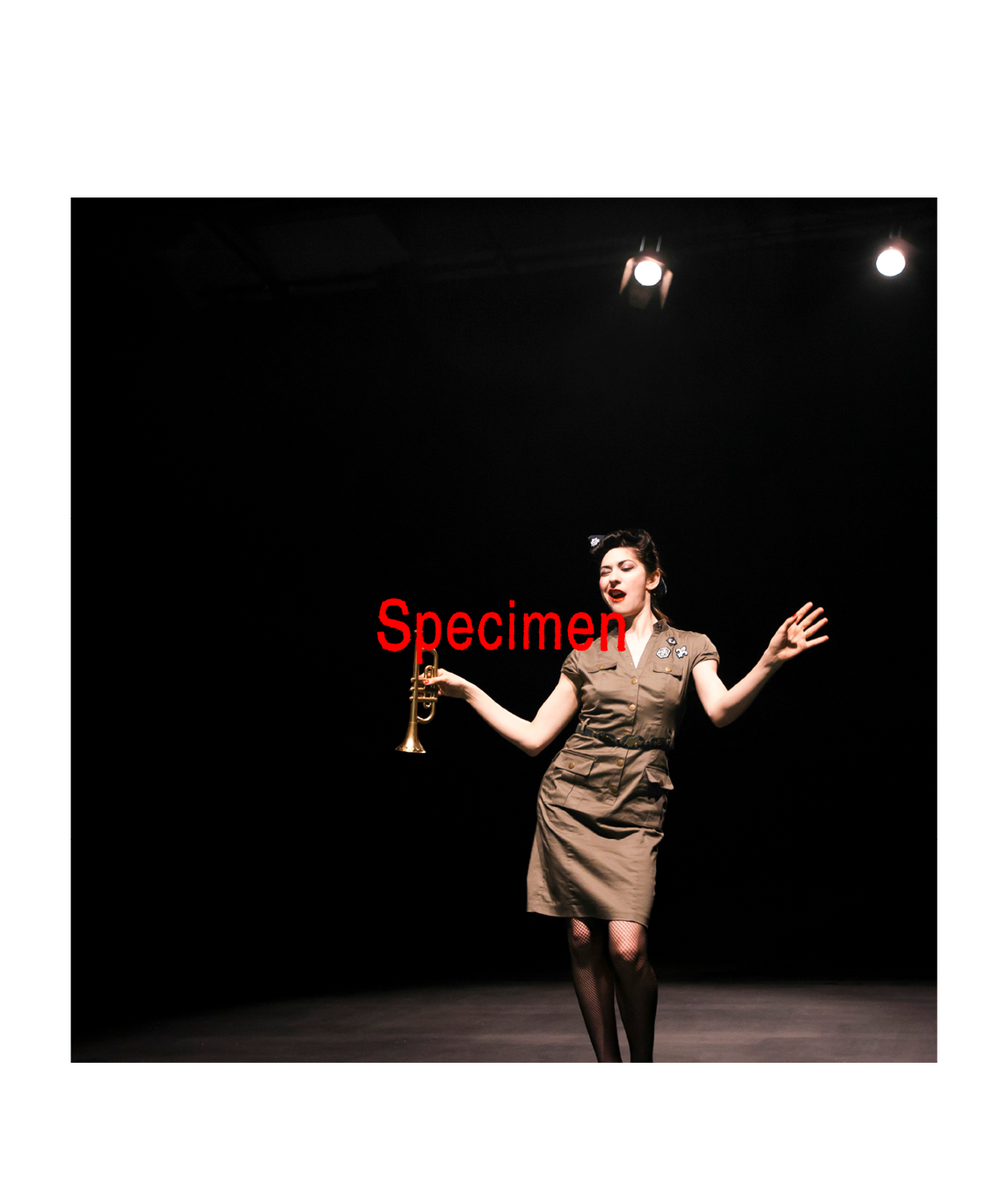
boundary thing 001650 (Gypsy)
In 1957 Gypsy Rose Lee, a burlesque performance artist from the United States, wrote her memoirs. Burly-q queen Gypsy Rose Lee was known for putting the “tease” in striptease. Her full administrative name was Rose Louise Hovick. The memoirs tell Gypsy’s biographic story. Louise’s mother, named Rose, wanted to see her younger daughter June succeed as a dancer on Broadway. But when June married and left the family, Rose pinned her hopes on Louise. Louise ended up becoming a dancer at Minsky’s Burlesque.In 1959 Arthur Laurents wrote the musical comedy, entitled Gypsy, based on the memoirs of Gypsy Rose Lee. On May 21, 1959, Gypsy opened at The Broadway Theatre with music by Jule Styne, lyrics by Stephen Sondheim, story by Arthur Laurents and production by David Merrick and Leland Hayward. The reviews of the show praised the burlesque queens in the musical as one of the highlights.
In 1959 Faith Dane had auditioned for the musical comedy Gypsy as the character of Miss Mazeppa, one of the queens working at Minsky’s Burlesque. During the audition she played a trumpet while dancing. Dane’s performance during the audition was a source of inspiration for You Gotta Have a Gimmick, one of the songs in the musical. The scene with Dane blowing a trumpet while dancing was included in the musical’s final stage version. Dane was also cast in the Broadway production, as well as the 1962 Warner Bros film adaptation of the musical.
In 1964 Faith Dane was no longer cast for the role of Miss Mazeppa. She attempted to extract royalty payments from playwright Arthur Laurents, alleging that he owed her money as a result of the incorporation of her trumpet scene in the script. On May 7, 1964, the court case Faith Dane v. M & H Corporation took place at Supreme Court. The judge held that:
The book of Gypsy had already been written. And as testified to by [Dane] and [M & H Corporation], before a musical show takes final form there is a certain amount of cutting, adding, varying and improvisation which takes place. [Dane] seeks to make much of the fact that the number You Gotta Get A Gimmick (in which her contribution appeared) was written after rehearsal had started and only because of what [she] had offered to the show. There is no substance to such contention. [...] [Faith Dane]’s number as described by witnesses shows: [Faith Dane] saluted with her left hand, facing in direction left while standing at rigid military attention, played [Faith Dane]’s variation and stylization of reveille and punctuated the first phase with two bumps; played her variation of reveille, still at military attention, left-hand salute, and repeated the same phrase. In facing right and left, the rigid military aspect is the most pronounced. Thereafter, as the “stripper” phase became more pronounced [Faith Dane] faced forward, played her variation of reveille consisting of slow growl trumpet variations of reveille to the accompaniment of grinds; [Faith Dane] then turned around, and as the final resolution of the competitive defiance, posterior to the audience, and blew a further variation of reveille with the bugle between her legs. [Faith Dane] also claims that her number was unique in that she portrayed a “stripper” without taking anything off. She admits that bumps and grinds or gyrating the pelvis back and forth (pelvic contractions) and sideways are movements going back to the days of Salome and “ever since the human being has crawled around this sphere”. [...] [Faith Dane] has attempted to give her 30-45 second choreographic composition of the resemblance of a story by her own interpretation. [...] [The] performance contains nothing of a literary, dramatic or musical character which is calculated to elevate, cultivate, inform, or improve the moral or intellectual natures of the audience, it does not tend to promote the progress of science of the useful arts.
The court concluded that Faith Dane’s dance was no doubt amusing and entertaining to many, but couldn’t be protected as an original work of drama.
(N)O'ING
Ode de Kort
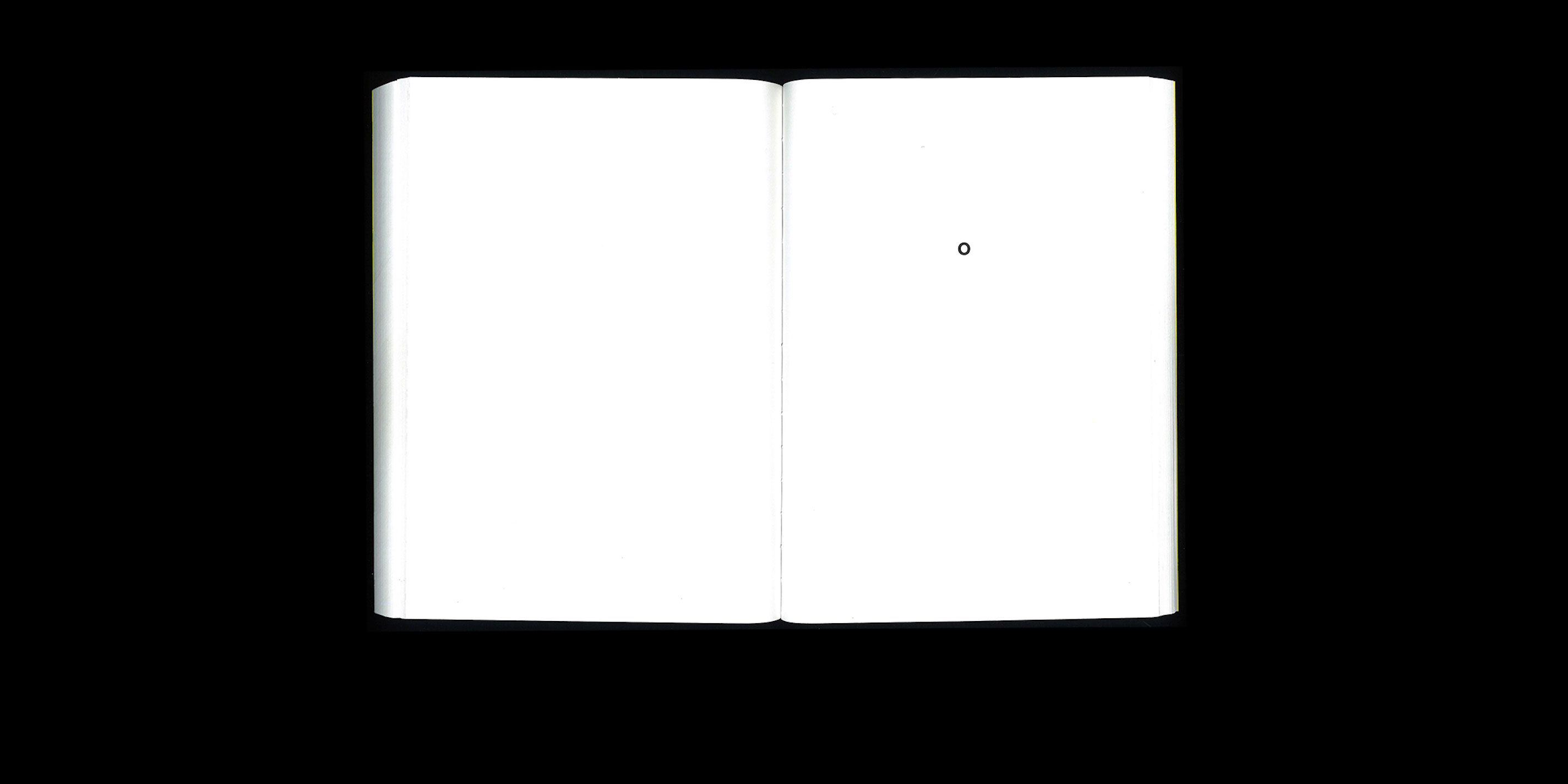
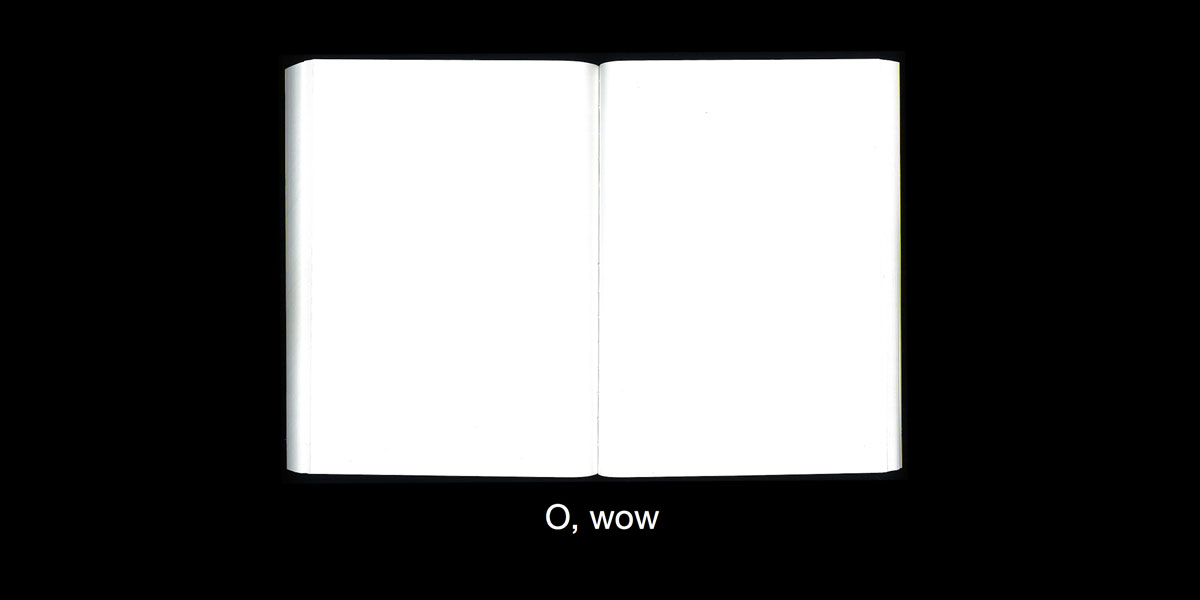
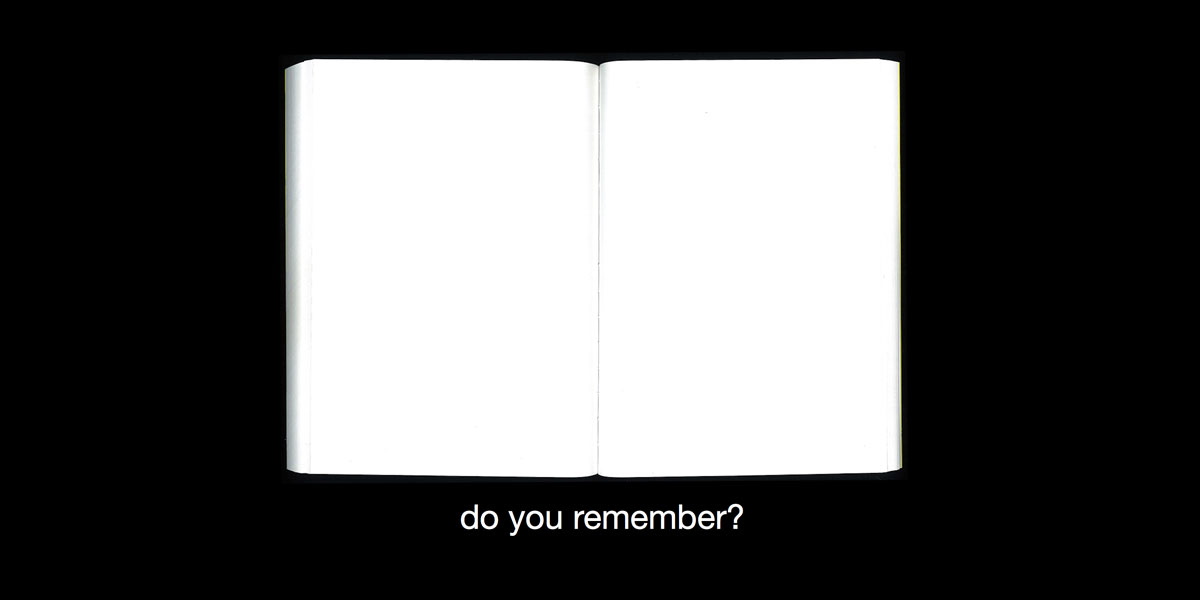
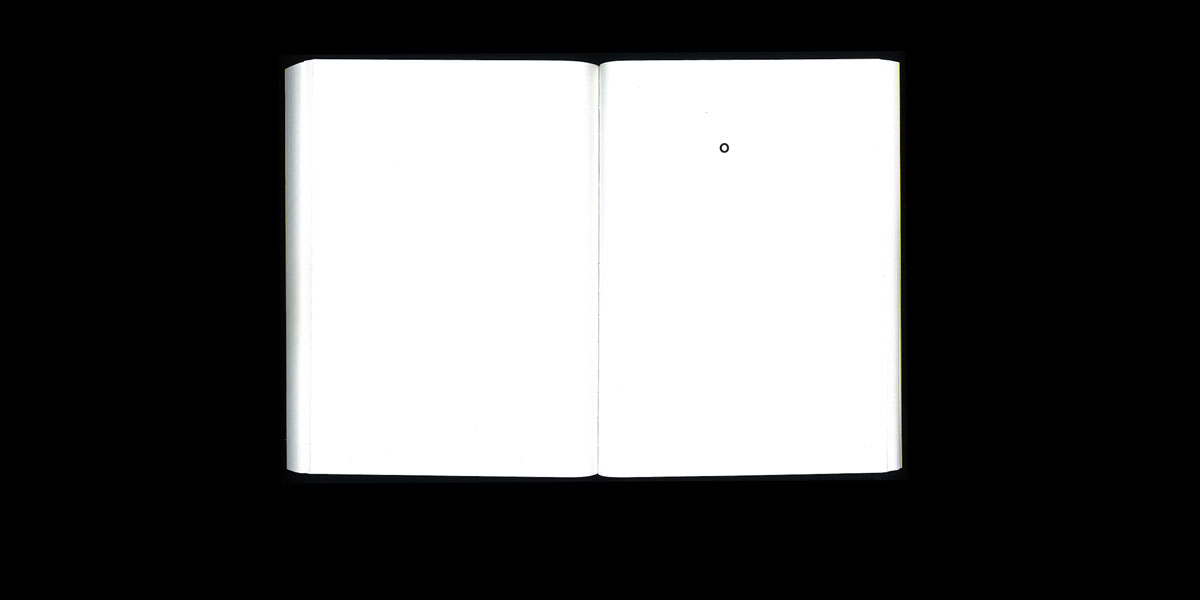
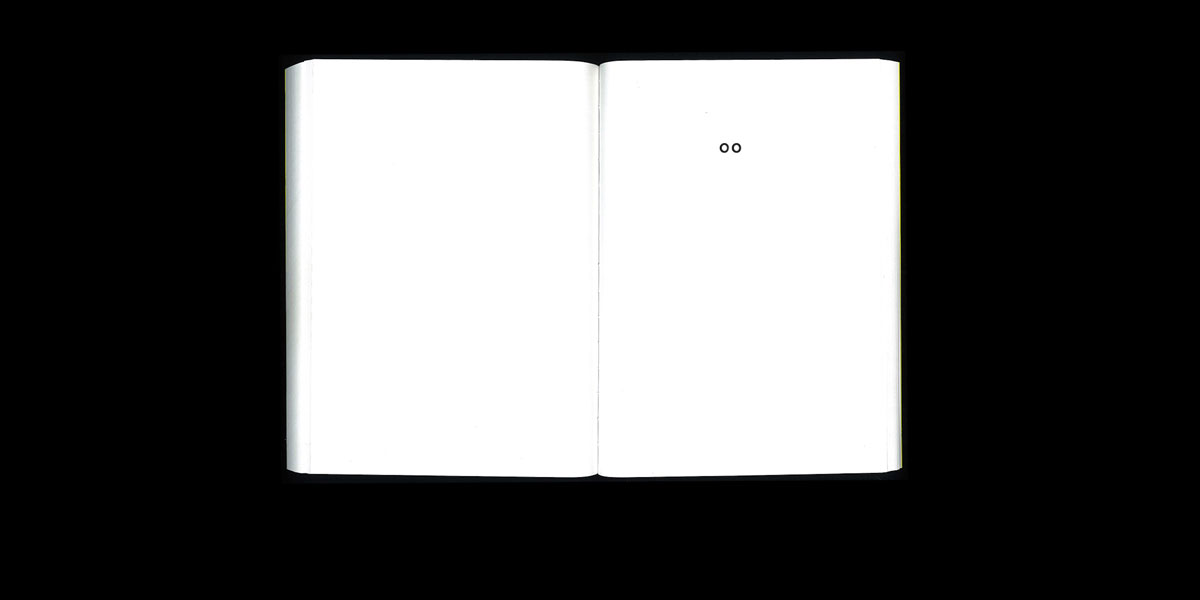
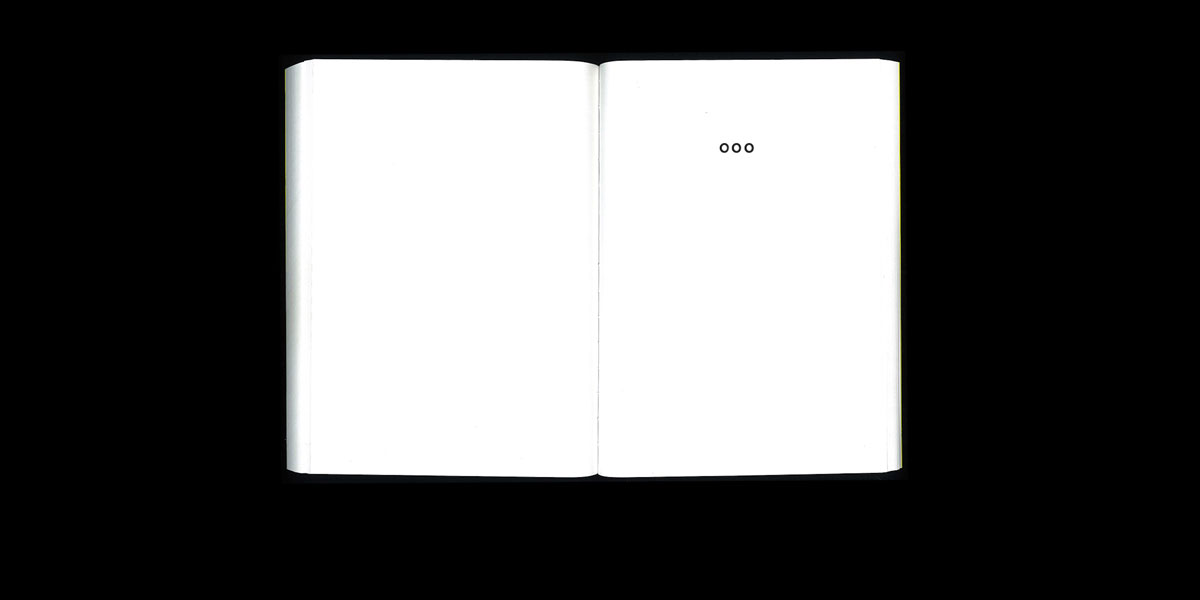
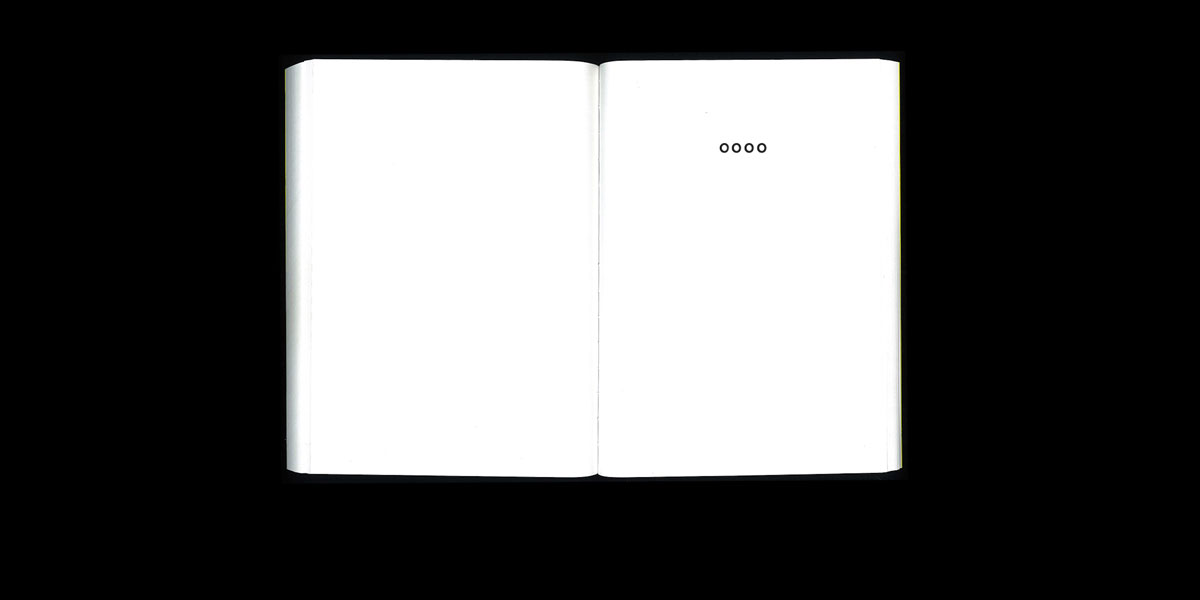
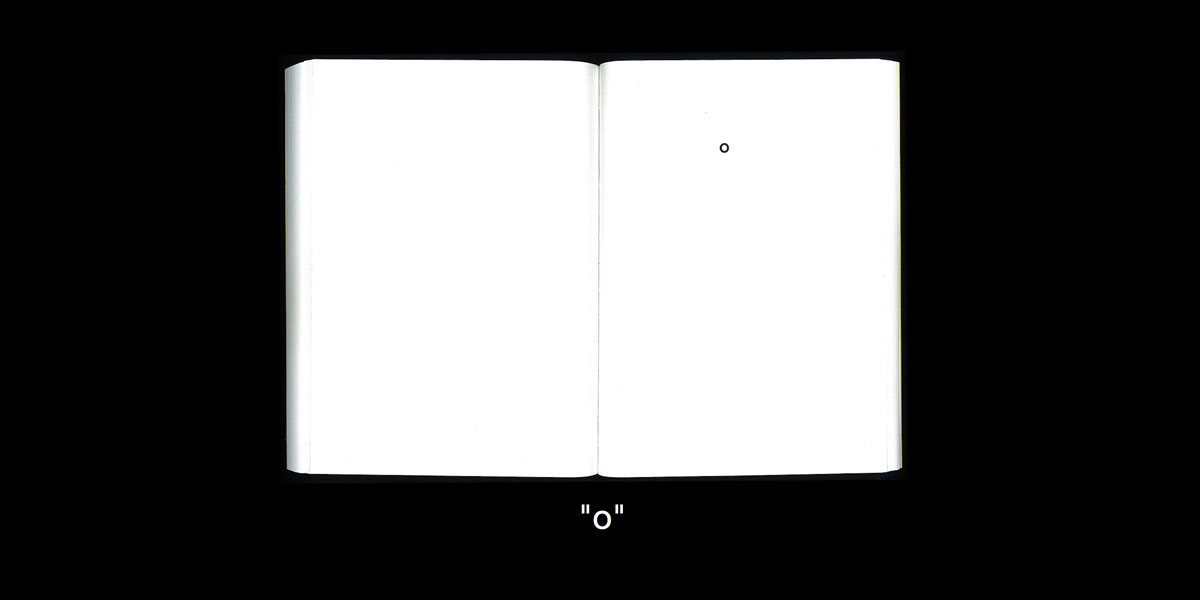
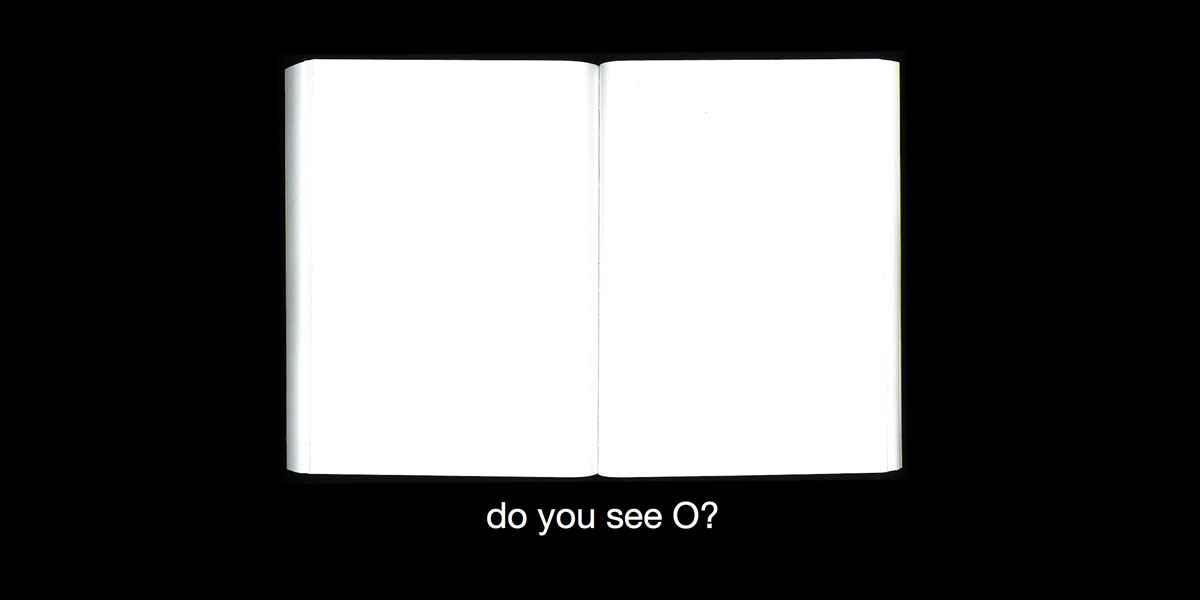
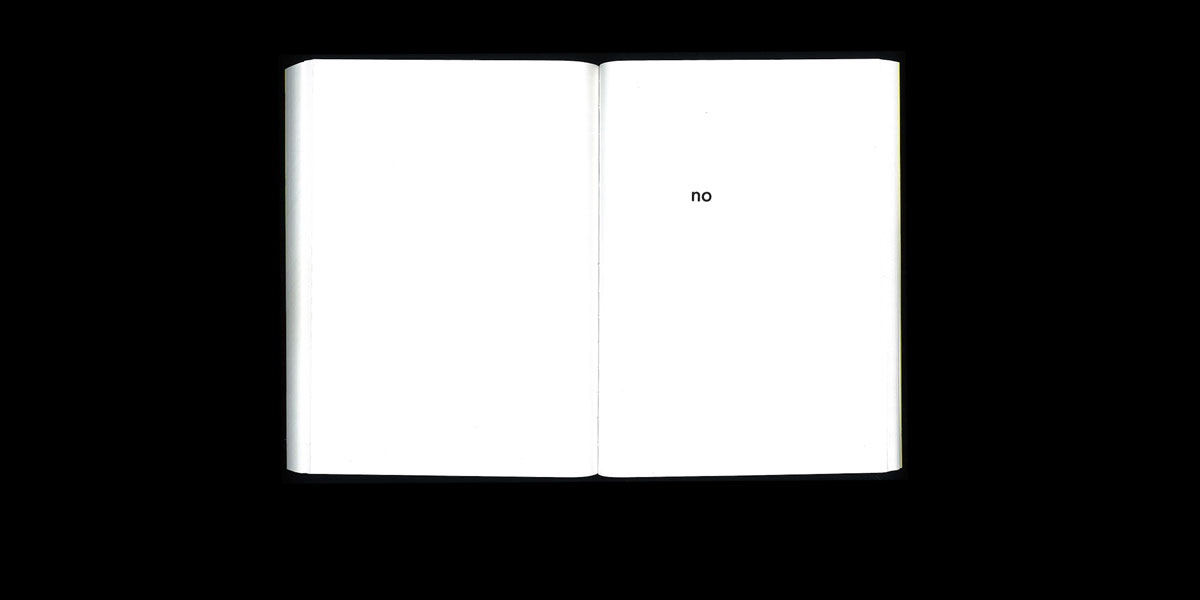
Rehearsal as an artistic method
Florian Dombois
c
clustered | unclusteredFictioning
Goda Palekaite, Agency, Charlotte Vanhoubroeck, Laura Vandewynckel
In addressing the role fictions have in our everyday lives, [these artists] show how fictions can be used as means of revealing the hidden workings of a state of affairs, and even of establishing a certain agency within it. Far from being an escape from the world, then, here fiction takes us to its symbolic center, and might allow us to establish some leverage within the tangled contingencies and hidden conventions that lie there.
— David Burrows and Simon O’Sullivan, Fictioning: The Myth-functions of Contemporary Art and Philosophy (2019)
5 DREAMS WITH IMPLICATIONS: On Private Methodologies of Artistic Research
Goda Palekaitė
When I first began to see myself as an artistic researcher, sometime in the spring of 2017, I remember my primary concern was the mysterious extinction of the medieval Khazar culture, which had once existed between the Caspian and the Black Seas. Living by the laws of ethnic and religious diversity and the wisdom encoded in dreams, Khazaria is sometimes considered the most tolerant empire of all time. Dreamhunting – an advanced religious practice – was cultivated by a sect of the most talented and respected priests. The art of dreamhunting enables one to enter other people’s dreams and have agency there. The Khazars have been reported to keep snakes around their waists, sleep with their heads turned south, wash their feet without taking off their shoes, and carry birds inside their shirts to keep warm. They believed that rivers followed one course at sunrise and another at sunset, and that contracts did not apply in the same way before and after a victory. They used to say that after an earthquake, even plants grow in a new and different way.
The Khazar king, or khagan, lived in the capital Itil at the mouth of the Volga River, where the Russian village of Samosdelka is now located. The controversial discovery of the ruins of Itil was made in 2003, when a history teacher at the Samosdelka high school found his pupils throwing stones at some ancient pots aligned by the school fence. The khagan also had a marble summer palace called Sarkel, which stood facing north, close to what is now Volgograd. Michail Artamonov, who is credited as the founding father of contemporary Khazar studies, excavated it in the 1930s. In 1952, Stalin decided to flood the most fascinating archaeological discovery of the century in order to create the largest industrial body of water in the USSR, the Tsimlyansk Reservoir. Today the fully submerged Khazar remains provide power to the Tsimlyansk hydroelectric station and an irrigation system for crop fields, including wheat, rice, cotton, maize, grapes, and vegetables.
The fatal event in Khazar history, which caused the collapse of the empire, occurred sometime in the ninth century, and is commonly referred to as the Khazar Polemic. All began with the khagan’s dream, in which God told him: “I am not pleased by your deeds, but by your intentions.” The sovereign summoned the most prominent dreamhunters and asked them to explain what God had meant. They said: “You must choose one of three biggest religions in the region, Christianity, Islam, or Judaism, and convert your whole nation to it.” The khagan then invited the most prominent scholars of each religion to lead a debate and convince him which religion to choose. The debate lasted an eternity and was followed by the extinction of the whole empire. Curiously, not enough historical sources survive to prove which religion the Khazars ended up adopting. Nor do we know how the collapse of the empire occurred or what happened to the Khazar people.
This story, neither fully invented nor really found in history sources, contained everything relevant for the formation of my personal and professional self. The idea that an entire empire went extinct as a consequence of a dream, helped me to unlock the practice of discursive reasoning, to reimagine the concept of truth, and invited me to explore new working methods. I could relate to it on both a personal and cultural level. I was born in the USSR, a state whose extinction was caused by a form of cancer, as its dystopian regime ate itself from within. I was raised as a part of the Lithuanian “ethnos”, the nation that built its identity on historical detective stories, pagan sentiments and ancient glory; imagination and inconsistency served as fundamental discursive principals. Intuition and dreams, and here I mean dreams in the English sense of the word – both night journeys and daydreams –, proved to be the only reliable guidelines.1 I grew up into a troubled artist, amateur writer, and a nonacademic anthropologist. But I was eagerly searching for a discourse and a methodology that could combine all these elements without asking me to compromise or lose what these fields could offer independently. It was then that the term artistic research unfolded its opportunities and complexities in front of me. In this text, I attempt to describe five of my privately developed (and often collectively exercised) methodologies of what I see as artistic research, or in other words, five dreams with implications.2
1: DREAM ON THE ARTEFACT: travel, dream, imagination
I developed interest in the Khazars after reading a novel by the Serbian writer Milorad Pavić, Dictionary of the Khazars (1984). There, he describes three versions of the Khazar history talking from three different perspectives (Christian, Jewish and Muslim), masterfully merging extensive historiographic and archeological research with poetic writing.
The research that began with a book of fiction led me to a variety of academic sources and, finally, to two research trips: the first one to the Caucasus region, nowadays Russia and Georgia (2017), and the second to Israel (2018). I came back with 24 archeological artefacts taken from the Khazar capital Itil – they were waiting there for the Volga River to rise and wash them away to the bottom of the Caspian Sea. On the field visit to the archaeological site of Itil, professor Dmitry Vasiliev, who has been excavating the site for the past 24 years, whispered to me that they might be 1000 years old.
I was familiar with the methodology of ethnographic fieldwork from six years of social and cultural anthropology studies, which led me to conducting research trips in several countries. But this one, guided both by fiction and intuition, was not exactly ethnographic fieldwork. I found myself observing and photographing landscapes, recording songs and stories told by local people (who had hardly heard about the extinct Khazars), and collecting my own “Khazarian” experiences. I wished I could hear the stories encoded in the material objects I carried back home, and read the dreams that these artefacts carry.3 Yet my own effort could not be sufficient to connect to the dreams of the extinct society. Thus, I shared the Khazar story with 12 other artists giving them one artefact each accompanied by the following instructions:
1) put the artefact under your pillow before going to sleep 2) dream of something that could cause legal implications 3) record your dream when you wake up 4) share it with me4
Some of the outcomes of the Dream on the Artefact method were later transported to Israel and contributed to my solo exhibition Legal Implications of a Dream, which took place at the RawArt Gallery in Tel Aviv and Art Cube Artists’ Studios in Jerusalem.5 The exhibition included my texts, sculptures, the archaeological artefacts, a film, sound pieces, and a performance. Working in (and about) the context of modern Israel, a state which is today to a large extent defined by its catastrophic implications, I addressed the political agency of dreams and the role of collective imagination in the formation of state ideology.
2: PUT WORDS IN MY MOUTH: conversation, incantation, overcoming the author
Besides the displaced artifacts, there are other “unreliable” historical materials that can unlock new methodologies within artistic research. I call them historical leftovers. These contain all things that do not fit formal historiographic criteria and have therefore been neglected by the grand historical narratives. Accounts that reach us as somebody’s dreams, visions, opinions or rumours have commonly been disqualified from the discourses of “truth” and censured as unreliable. It was perhaps Michel Foucault who first taught us how to draw ahistorical connections within history, how to use history as a material itself. This is the beginning of his Lives of Infamous Men:
“This is not a book of history. The selection found here was guided by nothing more substantial than my taste, my pleasure, an emotion, laughter, surprise, a certain dread, or some other feeling whose intensity I might have trouble justifying, now that the first moment of discovery has passed. It’s an anthology of existences.”6
One such historical existence relevant to my practice was the Russian anarchist thinker and presumed founding father of political anarchism, Michail Bakunin (1814-1876). Bakunin exercised political critique through his own existence: he left Russia to study philosophy in Germany but never came back as a free person. He traveled through most European countries giving speeches and initiating revolts. Every state he came to prosecuted him. He was given two life sentences in prison and sent to jail in Russia where he spent five years and lost all his teeth from scurvy. Nevertheless, he managed to escape through Siberian rivers to Japan and the USA, and he finally came back to Europe to continue his underground activities. My fascination with this specific historical figure arose from the fact that political anarchism has developed in the act of public speaking, i.e., in performance (in contrast to bookish Marxism, for instance). As Bakunin never published a coherent theoretical work and spent most of his life undercover, there are very few “reliable” sources. As Paul Avrich notes in his introduction to Bakunin’s most famous work God and the State: “he was forever starting new works which, owing to his turbulent existence, were broken off in mid-course and never completed.”7 As part of my research, I travelled to Bologna and Turin to conduct interviews with the contemporary Italian anarchist community. Yet, in order to write the script for my performance Bakunin, I sensed that the traditional ethnographic methodology is not sufficient to respond to the unruly nature of my research subject – I needed an experimental component. The method described below as Put Words in My Mouth contributed largely to the performance which premiered at The Venice Biennial for Architecture 2018 at the Lithuanian pavilion.8
For Put Words in My Mouth, I again invited a group of artistic researchers to develop dialogues based on a certain score or script. The people were divided into couples (preferably two people who did not know each other well would form a couple), and each given a sheet with 103 phrases divided into questions, answers and reactions. They were asked to construct and directly record a dialogue speaking out phrases spontaneously in any chosen order or repetition. Here are some examples of each:
QUESTIONS: Who are you? Where do you come from? What is your problem? How shall we live? What is destruction? … ANSWERS: A citizen of all history. My life itself is a fragment. What is real is rational and what is rational is real. I am a fanatical lover of truth and freedom. … REACTIONS: Hypocrite! Are you certain? Stop… Stop… [Ask the other to repeat] [Uncomfortable silence] [Uncontrollable laughter]
The simple phrases, influenced by the 19th-century anarchist discourse and aesthetics of language, enabled the conversation to evolve here and now, collectively, intuitively and without imposing the authority of an author (an anarchist gesture in itself). Later, the transcriptions of these private conversations formed an essential part of the performance script. Moreover, the audience members were asked to participate in a similar “blind” dialogue during the performance. One might also notice a Dadaist influence, where poetry readings occasionally consisted of placing cut-out words from newspaper articles in a bag, shaking it and then constructing poems while picking the words in arbitrary order. Or think of another element of the Bakunin performance: at certain moment, the performer Stefano Moretti would “read” a poem by Velimir Khlebnikov, a Russian constructivist poet, called Incantation by Laughter, which barely contains any meaningful words and instead consists of strange sounds reminiscent of somebody trying to contain their laughter. The performer would thus succeed to make the audience laugh without clowning or joking but through the power of incantation.9
In these explorations, the confrontational and provocative aspects of the methodology were no less relevant than its corporal performativity. By naming them Put Words in My Mouth and Incantation, I did attempt to comment on performativity as possibly a forceful political tool, as suggested by Bakunin’s anarchism. An underground agent who relied heavily on his performative abilities, such as improvised public speaking and provocative actions, Bakunin can be seen not only as a founder of a political movement, but also of the whole political performance methodology, and he can be compared with contemporary artist-activists. As Christophe Meierhans, a former theatre director and now one of the leaders of the Extinction Rebellion movement in Belgium, describes his work: it aims at “designing and realizing actions of civil disobedience.”10
3: VODKA SALT: partial truths, fictioning, intoxication
With the performance Vodka Salt, I intended to thematically integrate my two previous fields of research: the imaginary landscape of Khazaria and the speculative history of anarchism. This required a new methodological gesture again. The performance took shape as a personal encounter between a visitor, a historical character and myself. Each member of the audience was invited, individually, to spend time behind a huge curtain – on the backstage of a group show of performances entitled Unsettled Study and presented at the KANAL Centre Pompidou in Brussels as part of the Performatik festival 2019.11 A 20 meters long curtain was installed there to create a backstage for historical and political narratives and identities, in which the agency of the imagination is mobilized in processes of truth-making. Here, my methods were conversation, partial truth, fictioning, and intoxication. The performance would start with instructions for one visitor at a time:
1) Find an artist in a red military jacket 2) Tell her the keyword you chose to activate the performance: vodka or salt.
Hence, by choosing one of the two keywords, each visitor had a chance to encounter one half of the performance. It is perhaps no surprise that the vast majority chose vodka. Once the person would find me wearing a red military jacket and tell me the keyword, I would lead them on a journey behind the curtain, beyond geography and chronology. I would be speaking as one the two chosen historical characters: Essad Bey, whom I speculatively related to the Khazars and who was represented by a pile of salt; and Michail Bakunin, whom I chose to stereotypically represent by vodka.12 Mixing my biography with theirs, raising the questions of anarchism, orientalism, and their legacy in the contemporary world, sharing vodka and salt all night, in the closest possible proximity to my audience, I explored the intimacy with history that could have not been explored in another way. The space behind the curtain became a hideout from the busy public gaze of the festival goers, and unexpected drunk encounters took place.
The fact that nobody besides myself knew the full truth of the performance (full script, full concept) might remind us of the seminal essay by the anthropologist James Clifford, Partial Truths (1986), in which he insists that ethnographic research (and other kinds of research as well) is an interplay of voices and positioned utterances; it is closest to fiction and the ethnographer is closest to a “maker of texts”.13 Clifford suggests that we approach research as a constellation of partial truths. Thus, the partial truths of Vodka Salt did enable my visitors and myself to summon history, privately, personally, intimately. One might ask whether it was still history that was summoned as I confused the facts, made up the narrative, merged the biographies, writings and speeches of historical figures with my own.
In fact, the differentiation between “fact” and “fiction” can itself be seen as a historical confusion. As Lennard J. Davis shows in his article “A Social History of Fact and Fiction”, in the development of literary genres, fictionality or factuality were not crucial factors in defining the genre of a piece of writing until the 18th century.14 In 16th- and 17th-century English literature, the term novel was used to talk about both real and fictional, both everyday-life and supernatural events. The term covered both the Decameron and journalistic articles, and was used fairly interchangeably with the word news. Moreover, authors of English novels of the time usually began their texts claiming that this was not at all a fiction but somebody’s actual life, compulsively repeating phrases such as “as far as I can remember”. These techniques showed that the writer was merely documenting the true course of events, whether those of the physical or the discursive reality, which both stood on equal grounds. “Journalism” did not appear to be classified far from fiction either. News reporters of the early modern times were often accused of being liars (their accounts were based on a sworn statement of truth) while most of the successful writers were also reporters. In this light, our contemporary age of “post-truth”, “fake news” and “alternative facts” does not seem either novel or sensational.
4: THE STRONGEST MUSCLE: translating, editing, outsourcing
My favourite figure in 17th-century England, in this curious time before the brutal separation between fact and fiction, is Margaret Cavendish, the Duchess of Newcastle (1623-1673). Having had no formal education (on account of her gender), she yet enjoyed a privileged status in society by being married to a wealthy duke. Their house was a meeting place for thinkers, writers, scientists, and other intellectuals of the time. Being domestically involved in these circles, Cavendish educated herself – by listening to the discussions, opinions, gossip –, and started to write. My solo exhibition The Strongest Muscle in the Human Body is the Tongue was presented at the Editorial Project Space in Vilnius and at Kunsthal Gent in Ghent.15 There, among other things, I worked with Cavendish’s novel The Blazing World (1666), which is often considered the first written work of science fiction. In this rather hard-to-read novel, Cavendish wildly connects natural philosophy, sciences, speculative reasoning and fantasy, without complying with any rules, not even grammatical ones. With her excessive language she addresses issues that were not generally addressed in her days; we can hear her intuition for feminist and post-humanist ideas. Her radical descriptions of the body as a fluid and ever transitional entity with abilities to move back and forward in time, were particularly interesting to me:
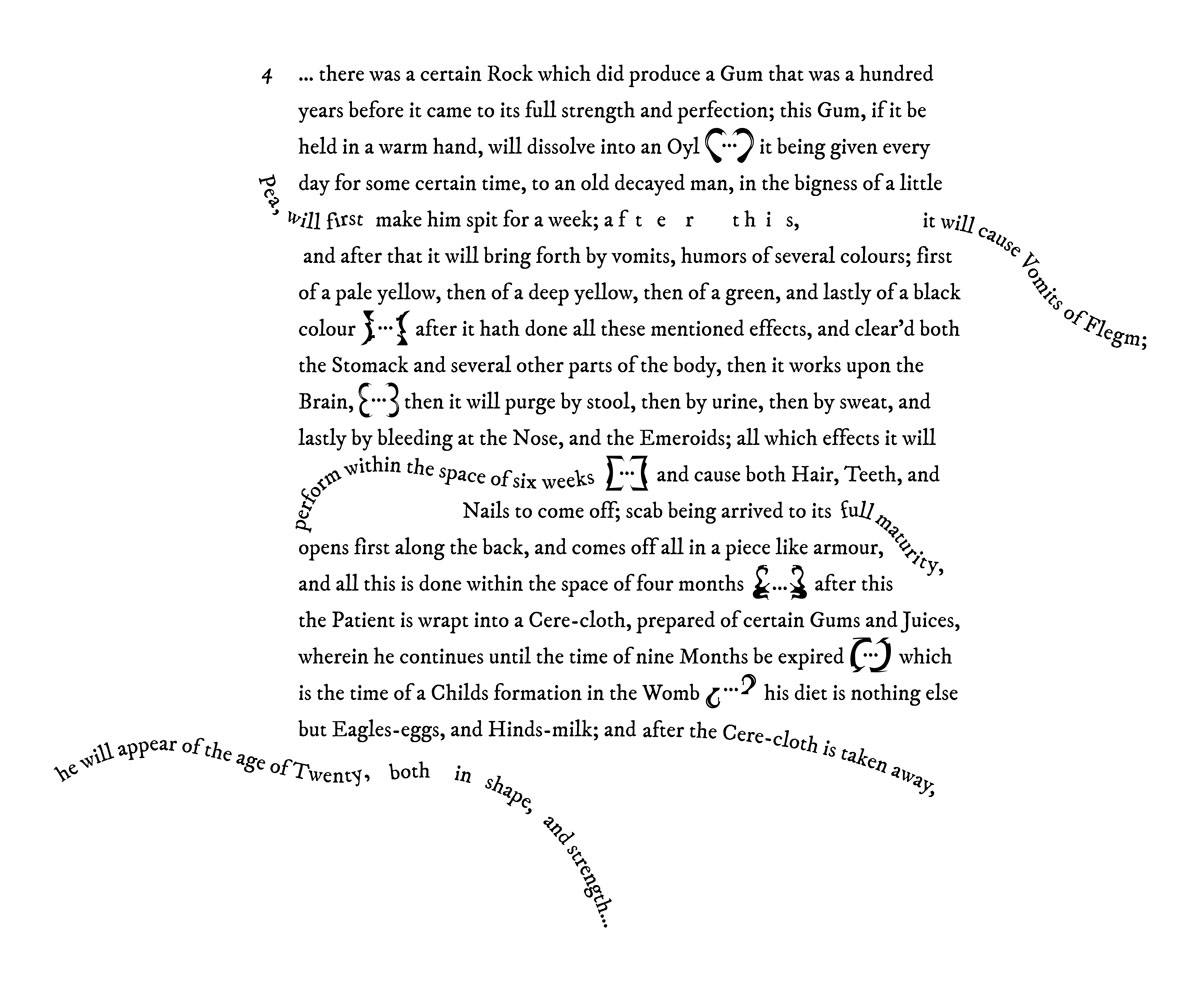
I consider my contribution to Margaret’s piece as an editor and translator as part of a methodology in artistic research. I was concerned with how to find a new, spatial shape for a historical, perhaps hardly accessible, text. How to edit or draw it, how to write in space in a way a contemporary audience would be able and willing to read? How to rescue it from an exclusively academic (and within academia, also very niche) circle? Half of The Blazing World’s fragments in my exhibition were excerpts from the English original and half of them were my translations to Lithuanian, deliberately attempting to imitate Margaret’s style. The graphic design, created by Jonė Miškinytė, attempts to materialize this wildly moving all-directional text.
In their book Fictioning: The Myth-functions of Contemporary Art and Philosophy (2019), David Burrows and Simon O’Sullivan discuss fiction not as a genre but as a method applied in contemporary art, music and philosophy, and suggest that fictioning in art is employed with visionary purposes.17 In their words, it intends to describe the reality to come. And, thus, I suggest that Margaret Cavendish was a visionary interdisciplinary artist employing the scientific research of the time along the method of fictioning, merging facts and imagination in order to create new worlds or new possibilities to think about the world she lived in and to define the reality to come.
5. ENCOUNTER THE PREDICAMENT: liminality, intimacy, transference
Since I have just described the artist-editor’s approach of outsourcing and repositioning (in contrast to the approach of an artist-God creating ex nihilo), I should mention at least one precursor, Bertolt Brecht (1898-1956), the German playwright, theatre director, theorist and poet known for revolutionising theatre and performance. Brecht, in his work, borrowed freely from many sources, adopting plagiarism in support of parody. Up to this day, many critics disagree about the ethical implications of this aspect of his work, without denying Brecht’s genius. Yet, it was Brecht himself, and not the subjects of his plagiarism, who took the political consequences of his explicitly Marxist art in Nazi Germany – his books were publicly burned in 1933 and he himself had to spend 15 years in exile before returning to spend the last years of his life in East Berlin.18
In performance theory, Brecht made his undeniable mark for developing the Verfremdung technique, which is translated to English as alienation. This artistic device requires an artist to distance the artwork from the viewer through confrontation and realisation, through an awkward gesture of disconnection (in Brecht’s case, the performer would disrupt the theatrical illusion by suddenly demonstrating that he/she is playing a role).19 In the political context of WW2, this has to be seen as a technique for raising political awareness and educating the audiences to detect propaganda by deconstructing the social meanings they encounter through art.20
What I wish to obtain today, however, might be seen as the opposite side of the Verfremdung coin. The terms of intimacy, affinity and transference (as used in psychoanalysis) are useful here. I do see my practice in Brecht’s lineage, working against artistic illusion and naturalism, standing for awareness-raising and society-questioning forms of art, and expecting intelligent engagement from my viewer. Still, I am interested in radically opposite techniques than the ones Brecht used – those that do not distance you from the artwork but confront you with its disturbing proximity, which, I believe, another form of alienation.
With the project Liminal Minds, I continued my investigation of the implications of dreams found in historical records and invited the viewers to closely encounter the predicament of two visionaries. The first one was the underestimated Swedish futurist Emanuel Swedenborg (1688-1772): philosopher, theologian, geologist, mineralogist, anatomist, astronomer, engineer – a man of many talents. At the age of 56, he started having intense dreams and visions in which he encountered Jesus and regularly visited heaven and hell, which made him turn away from science towards mysticism. After this transformative period, he devoted the rest of his life to theological writings, mostly regarding the afterlife, including descriptions of the architecture of heaven with an engineer’s precision. He claimed to be as objective in his mystical practices as in his scientific ones.
The second figure I presented was Michel Leiris (1901-1990), French anthropologist and surrealist writer. From 1931 to 1933 he participated in the Dakar-Djibouti Mission, which, sponsored by the French government, collected artifacts and documented and described cultural practices and peoples from East to West Africa. Early on in the expedition Leiris realised that the mission employed endless questionable, unethical and violent methods in taking ownership of peoples’ religious artifacts and artwork. Feeling trapped and frustrated, Leiris found himself unable to assume his role as secretary-archivist and to objectively document the mission. Instead, he began writing an enormous number of personal notes in free association. After his return to France, Leiris decided to publish them. L’Afrique fantôme was a 533-page surrealist constellation of dreams, fieldnotes, unstructured diary, self-analysis, descriptions of anxieties, and erotic fantasies.21 The publication was, for decades, refused by the academic community, but it immediately became a seminal work for surrealist literature.
The concept of liminality was first introduced by Arnold van Gennep in Rites de Passage in 1909.22 He observed the rites of passage or transformative rituals of social life (such as weddings, funerals, initiation rites, etc.) and described liminality as the psychic and emotional state in between one social status and another – the state of ambiguity, disorientation and loss of fixed identity. In three of my exhibitions related to the Liminal Minds project, I invited the audience to enter into the liminal minds of these characters, and to perceive them as critical thinkers who operated ahead of their times.23 While Swedenborg performed a radical critique of Western science and Christianity, Leiris’ account was central for the shift from a colonial to a postcolonial mindset. My light, sculptural and video installations in dark rooms served as bedrooms for an intimate encounter with the nightmares and desires (or, if you will, the madness) of my characters. Hence, in my research, I adopt the concept of liminality not in the classical anthropological sense but rather in a personal and creative sense. Personal journeys, often secret transitions and transgressions, usually accompanied by dreams and visions placing persons outside of society, alienating and excluding them, become my material.
Supposedly, dreams and imagination had a prominent role in the Khazar empire. And, again supposedly, the empire’s legal and administrative system codified the reality of dream, intuition and imagination. I wonder what the world would be today if it had taken the Khazar path. However, the historical and archeological sources that remain are limited, contradictory and used for different ideological purposes. Imagination is the only tool that does not fail in helping to understand not only where we are but also where we could be.
After the conversion, the wisest Khazar poet – princess Ateh – was condemned to forget her language and all her poems. She even forgot the name of her lover. But before all this had happened, princess Ateh, sensing the danger, requested a large number of parrots that could imitate human speech. Each of them was taught a poem in the Khazar language. The birds flew away into the forests, where they taught the poems to other parrots, and these taught them to others, until Khazarian was only known to parrots. This story is to remind ourselves that language may know more about us than we know about it. Ateh’s practice may be seen as an archaic methodology of artistic research itself. It is in those displaced methodologies that I notice an opportunity to reframe the hierarchy of epistemological structures of truth and objectivity. By exploring and constructing an alternative, more intuitive, poetic discourse and intertwining public and personal memory, we might be able to counter-write official, stubborn, one-sided historical narratives. I suggest that the transdisciplinary and unsettled field of artistic research is a key environment to work with speculative and creative methodologies. As a final remark, I feel a need to note that I believe the methodology of artistic research is private. It is driven by the impossibility to apply proven methods while exploring the most urgent inner questions. It cannot be taught, repeated or generalized because it is invented every time anew. Yet I believe that even private methodologies can and should be shared and that sharing methodology may be more relevant than sharing the results. In order to learn from you, I need to watch your process.
Notes
- 1 In contrast, in my native Lithuanian, which still usually serves as the language of my dreams, there are two distinct terms for dream as nightdream (lt. sapnas) and dream as daydream (lt. svajonė
- 2 A predecessor of this text was presented on the occasion of completing my participation in the post-master program in a.pass, a platform for artistic research in Brussels. Its rigorous and interdisciplinary context played an irreplicable role in the development of my methodology. Recently facing financial threats imposed by the Flemish government, the institute itself might soon become a dream.
- 3 Artifacts collected at Samosdelka, Russia. Image by Goda Palekaitė, 2017.
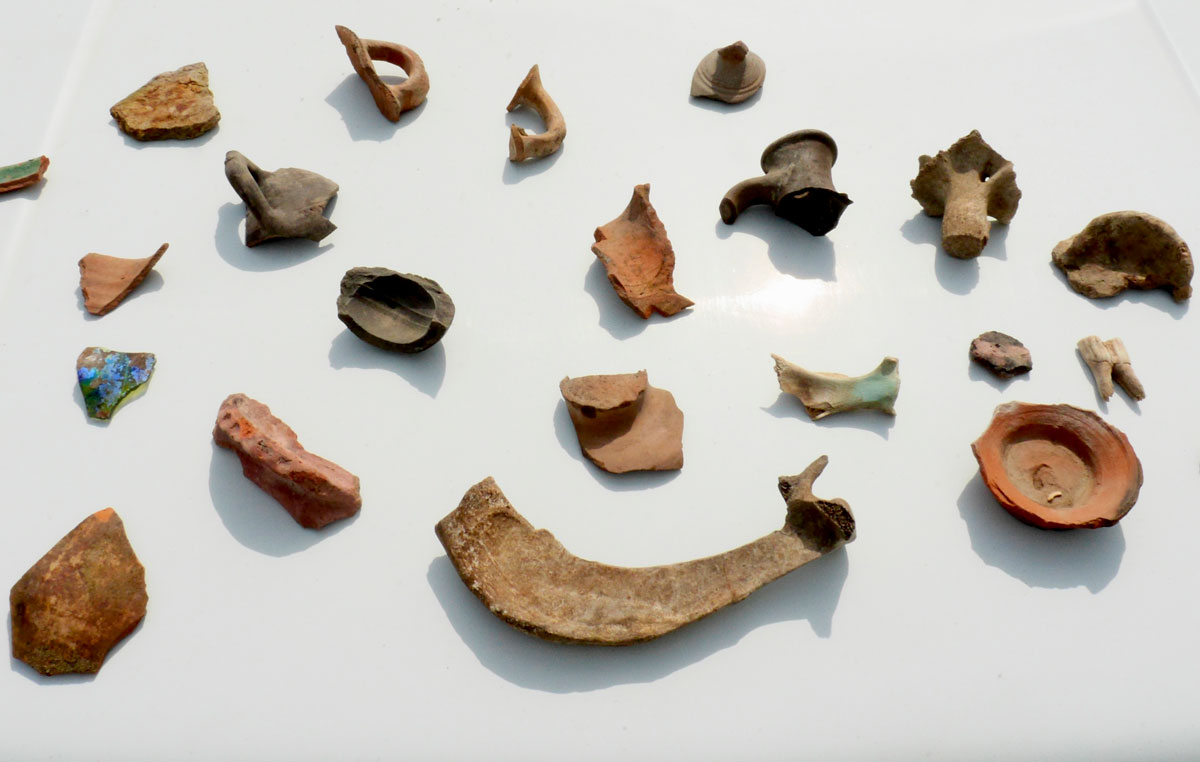
- 4This and some of the other group experiments described below took place in the context of a.pass
- 5 More about the exhibition Legal Implications of a Dream at RawArt Gallery and Art Cube Artists‘ Studios (2018-2019), curated by Leah Abir.
- 6 Foucault, Michel, “Lives of Infamous Men”, in: James D. Faubion, Power: Essential Works of Foucault, 1954-1984, vol. 3, New York: The New Press, 2001, p. 157-175.
- 7 Avrich, Paul, “Introduction to the Dover Edition”, in: Michael Bakunin, God and the State, New York: Dover Publications, 2015, p. v-xii.
- 8 Bakunin was further performed at the Laboratorio Artistico Pietra in Turin, and Vilnius International Theatre Festival Sirenos. The video trailer of the performance Bakunin filmed at Laboratorio Artistico Pietra in September 2018.
- 9 The audio recording of performer Stefano Moretti reading the translation of V. Khlebnikov’s poem Incantation by Laughter in the performance Bakunin, directed by Goda Palekaitė, sound-edited by Adomas Palekas (2018).
- 10 Without having a chance to expand on artist-activism here, I would like to refer to several contemporary examples, such as the contribution of Christophe Meierhans to Extinction Rebellion, Russian feminist activist band Pussy Riot, and Russian interdisciplinary activist collective Chto Delat.
- 11 Curated by Vladimir Miller and a.pass, Unsettled Study was a 3-day event in which numerous performances were simultaneously activated in a huge space at the KANAL Centre Pompidou in Brussels (2019).
- 12 Essad Bey (1905-1942) was a pseudonym of a Jewish writer and journalist from Baku, Azerbaijan, who spent most of his life in Germany, where he had converted to Islam. In the 1930s his books were praised by Nazis leading to international success, until his Jewish origin was revealed; as a result his books were burned and Bey died young in exile and prosecution. Today Essad Bey is perceived as an orientalist and often criticised for exotising and misrepresenting his home region and its peoples as primitive and barbarous.
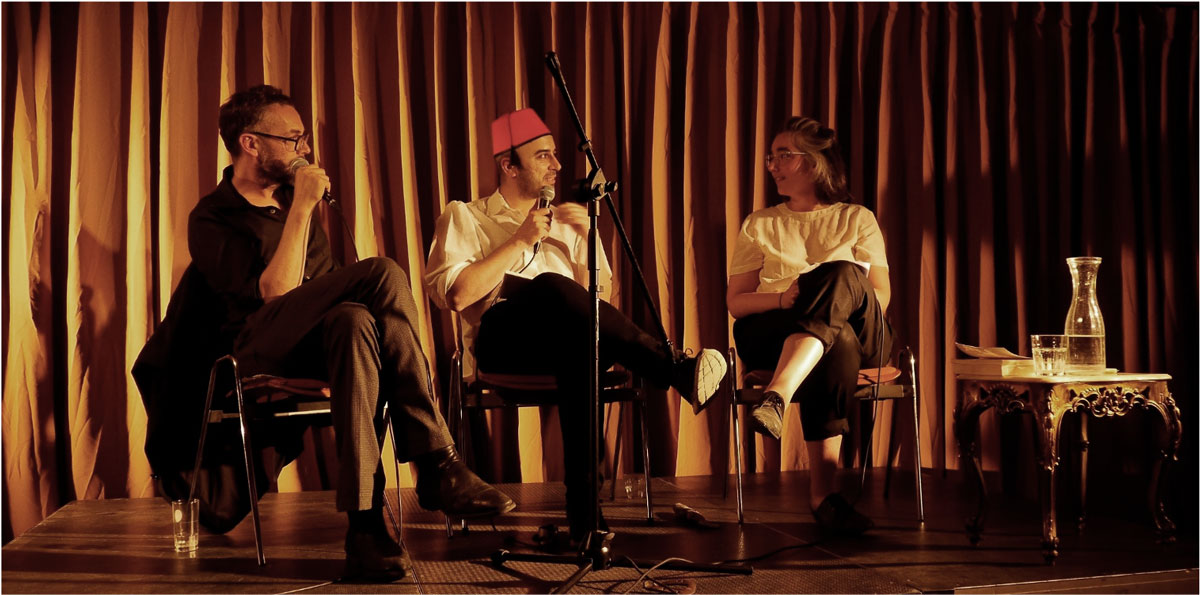
- 13 Clifford, James, “Introduction: Partial Truths”, in James Clifford and George Marcus (eds.), Writing Culture: The Poetics and Politics of Ethnography, University of California Press, Berkeley, 1986, pp. 1-26.
- 14 Davis, Lennard, “A Social History of Fact and Fiction: Authorial Disavowal in the Early English Novel”, in Edward W. Said (ed.), Literature and Society, English Institute, 1986, pp. 120-148.
- 15 The exhibition The Strongest Muscle in the Human Body is the Tongue at Kunsthal Gent was produced in collaboration with The Institute of Things to Come and curated by Valerio Del Baglivo.
- 16 Vinyl print for the exhibition The Strongest Muscle in the Human Body is the Tongue (2021): a quote from The Blazing World, edited by me and marked as […], graphic design by Jonė Miškinytė. My full piece The Blazing World exhibited at Editorial project space in Vilnius contained five excerpts from the book and their translations:
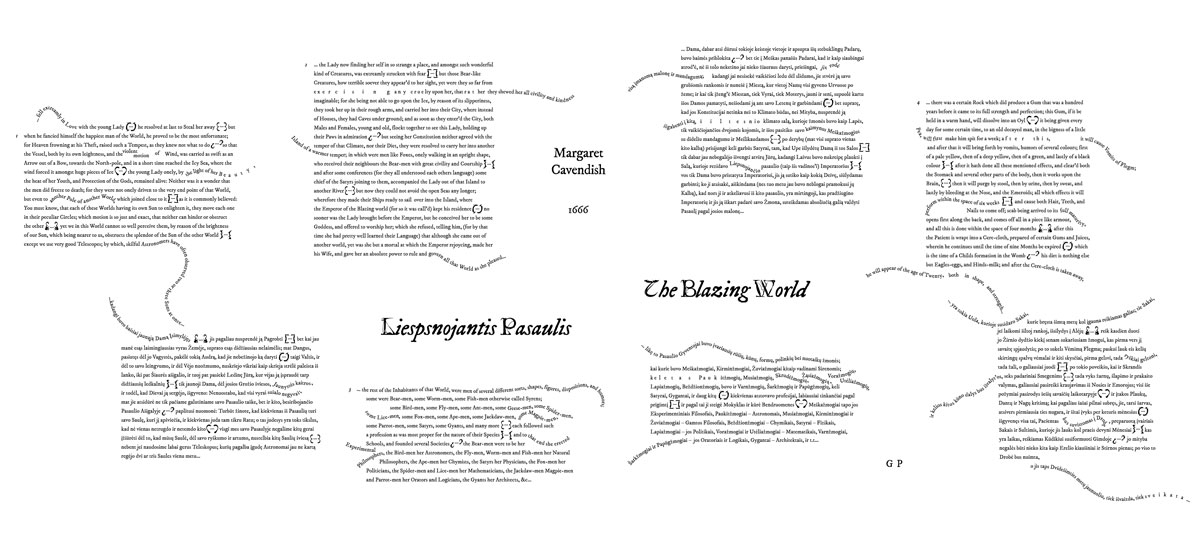
- 17 Burrows, David and O’Sullivan, Simon. Fictioning: The Myth-functions of Contemporary Art and Philosophy. Edinburgh University Press, 2019.
- 18 Freeman, John. New Performance / New Writing. Palgrave, London, 2016.
- 19 We could also consult Viktor Shklovsky’s notion of ostranenie or defamiliarization, which, even before Brecht, in the Russian formalist context, was referring to the crucial distinction of poetical and practical language. Defamiliarization was proposed as the fundamental artistic principle.
- 20 Freeman, John. New Performance / New Writing. Palgrave, London, 2016.
- 21 Leiris, Michel. Phantom Africa. Seagull Books, Calcutta, 2017 (1934).
- 22 Van Gennep, Arnold. Les rites de passage. Émile Nourry, Paris, 1909.
- 23 Exhibition view: Liminal Minds at Konstepidemin art gallery in Gothenburg, 2019
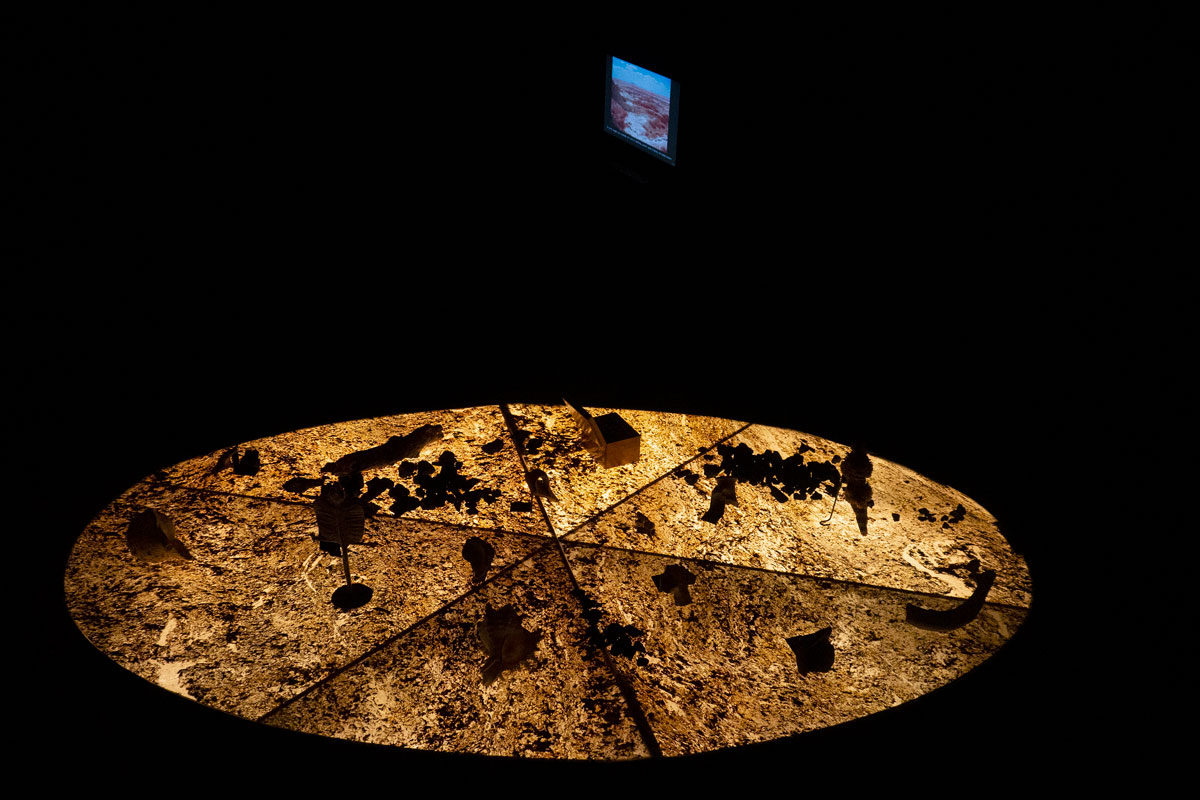
boundary thing 000923 (Scared Straight!)
Agency
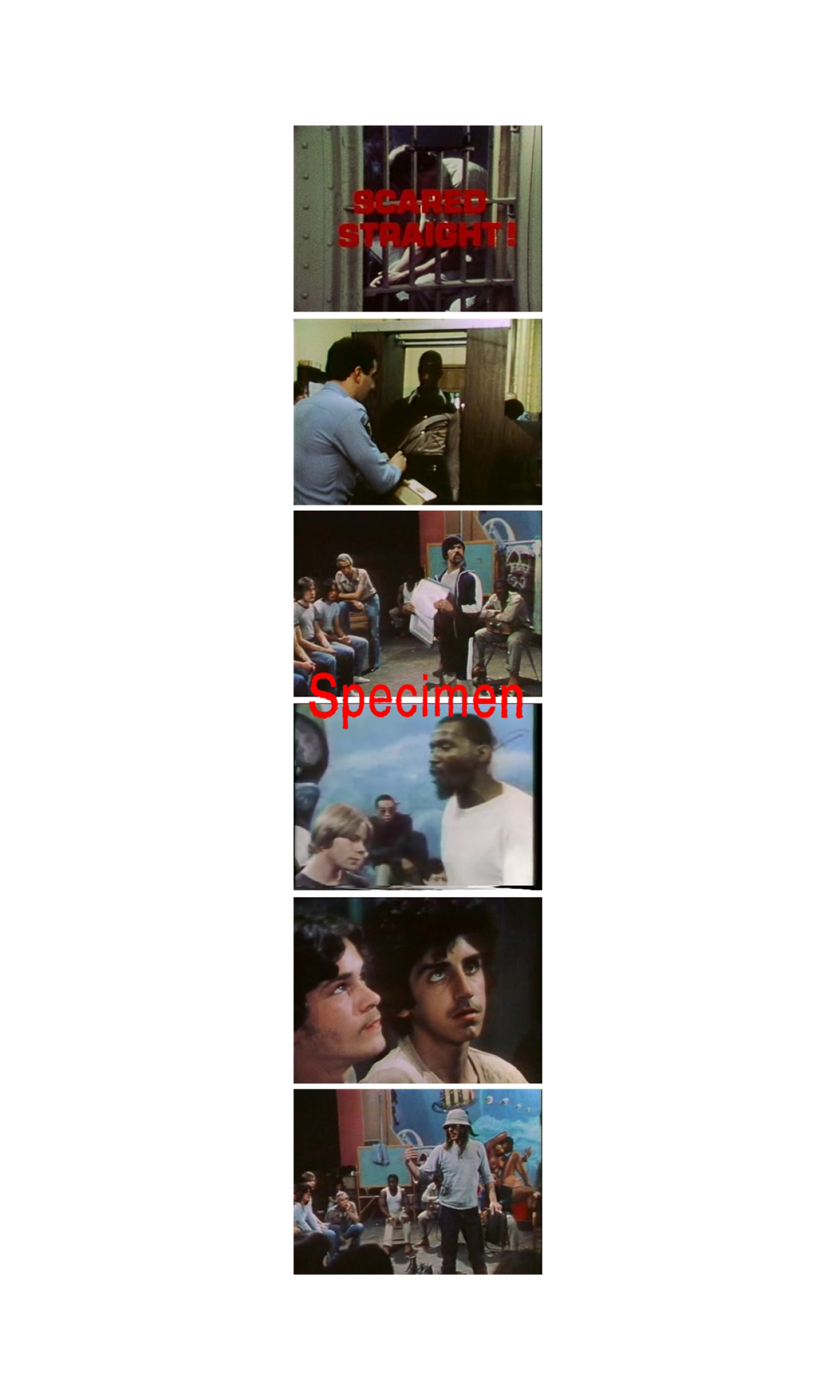
boundary thing 000923 (Scared Straight!)
In 1976, Richard Rowe, an inmate at Rahway State Prison, who started the Lifers Group, developed The Juvenile Awareness Program. The program was meant to deter participants from future crimes by providing first-hand observations of prison life and interaction with inmates. The program consisted of a confrontational talking session conducted by inmates serving life sentences and attended by juveniles who had begun experiencing difficulties with the law. During the course of each session the inmates exposed these juveniles to prison life by depicting the harshness and brutality of their incarceration. Each session differed from the other, depending on the reactions of the attendees. Although the actual sessions themselves were unscripted, Rowe instructed the inmates both on the contents of their talks and the methods to convey their thoughts. Rehearsals were also held. The goal of the program was that the juveniles would be “scared straight”. Rowe never recorded the program in any way.
In 1978, Arnold Shapiro made a documentary about The Juvenile Awareness Program at Rahway prison after reading an article on the program in the magazine, Reader’s Digest. He filmed seventeen juveniles before, during and after a three-hour visit to Rahway prison which predominantly consisted of a confrontational session with life-term inmates. In the documentary a group of inmates scare the juveniles by screaming and shouting brutally at them. In March 1979, the documentary Scared Straight! produced by Golden West Television Productions was first broadcasted on television. In December 1979, CBS entered into an agreement with Golden West to produce a new television film inspired by the documentary. In November 1980, the television film Scared Straight - Another Story, a drama with actors also produced by Shapiro, was broadcasted.
On March 13, 1980 Rowe filed a complaint against Golden West Television Productions, Columbia Broadcasting System (CBS) and Arnold Shapiro for infringement of The Juvenile Awareness Program. During Rowe v. Golden West Television Productions at the Superior Court of Middlesex County the judge held that:
The fluid, free-flowing educational “scared straight” program, where no script existed and audience reaction and inmate participation changed with each presentation, was not a concrete expression of an idea of [Rowe]’s that rose to the level of a tangible product deserving of a common law copyright.
The court concluded that there was no copyright protection. Rowe appealed the decision. He asserted that the sessions themselves were the tangible expressions of his conceptualization deserving copyright protection. On March 22, 1982 during Rowe v. Golden West Television Productions at the Superior Court of New Jersey, Judge Matthews held that:
Whether the session in question here was, as [Rowe] contends, a dramatization of prison life created by him, or, as [Golden West] assert, merely a real life exchange incapable of being copyrighted, we conclude that [Rowe]’s claim must fail. As we have noted, New Jersey law does not protect literary property which is not in a tangible form. And even if [Rowe] is to be credited with the dramatization of the sessions so that the sessions themselves are considered to be the concrete expression of his work product, we find that his claim nonetheless must fail as a result of federal preemption. Though the Copyright Act of 1909 preserved state law copyrights with respect to unpublished works, the [U.S.] Copyright Act of 1976 has now preempted this area. [...] Applied to [Rowe]’s claim for copyright infringement we find it clear that that action has been preempted by federal law. [...] [Rowe] makes no statutory copyright claim. Nor could such a claim be maintained in light of his failure to comply with the registration requirement.
The court decided that The Juvenile Awareness Program could potentially fall under the subject of copyright protection, but the claim of copyright infringement was preempted by the lack of registration.
Confabulation as Artistic Method
Reactivating the Sentimental Jewellery of Louise-Marie d’Orléans
Charlotte Vanhoubroeck
In 1832, Louise-Marie d’Orléans was welcomed in Belgium. The twenty-year-old French princess, an outspoken and sharp-witted woman, was to unwillingly marry the first king of the Belgians – who was twice her age – and become queen herself. As a wedding present, she received his miniature portrait, surrounded by diamonds and incorporated into a bracelet. An honourable act of love? Or a somewhat awkward formality? Presumably the latter. Transitions such as the 19th-century royal wedding, which rarely involved love, were frightening. These fears were anticipated, for instance, with jewellery. The sumptuous rituals of the bridal attire served to distract the bride from her impending marriage duties and the departure from her familiar home.1 This marriage was a turning point for Louise. The princess, who had been born into a large, warm nest and enjoyed herself with her brothers and sisters at the French court, could suddenly no longer be her witty self. Despair and melancholy steadily transformed the queen into a faint shadow of her former self. “When setting off for another place (…), hopes and imaginaries become reminiscences of lives lived before (…). When stuck in a place (…) we tend to dwell on memories of our former ways of life.”2 For Louise, it became tempting to muse. To visit bygone places in her mind, places that colour the day. “Mnemonic practices help to make sense of our lives,”3 and Louise developed the urge to cherish memories of loved ones and meaningful moments, memories that gave Louise’s life a new bloom. This she did by exchanging so-called sentimental jewellery pieces with the people she cared about. These small bodily treasures, which were very fashionable at the time, were known to encapsulate little mementos like miniature portraits, locks of human hair, engraved names, dates, messages, and so on. As small secular sanctuaries they gave a home to Louise’s inner world of feelings. They helped her celebrate sentiments of love and friendship, but also mourn and commemorate her departed loved ones.
Memories reside in the material world around us. They are recalled in dialogues – dialogues between people, but also between people and objects. Objects themselves may have no memory, but they certainly can contain and (re)produce memories.4 Memories can be evoked via the sensory touch, sometimes unintentionally.5 Objects that almost seem to be in need of this touch are jewellery pieces, as they are designed to be close to the body. It should not come as a surprise, then, that jewellery has been serving as a memory carrier for centuries. They proclaim not only status, splendour, but also, and sometimes above all, sentiment.
It’s fascinating to see how people can cling to the latter. To that sentiment. Louise lived during the heyday of Romanticism, a movement of emotion and melancholy that emerged during the drastic political, social and economic transformations of the late 18th century and early 19th century.6 The industrial society slowly became a harsh reality, and romanticism sought to bring salvation by creating an illusory, ethereal hideaway. Romantic moods were to move the minds, so sentiment and delirium took over from reason and nostalgic escapism was intensely encouraged.7 These ideals had also taken root in the mind of Louise, who wasn’t really interested in regal status displays and shimmering splendour. As a child of the sober French July monarchy, which did not want to indulge in decadent aristocratic behaviour out of fear of new rebellions, Louise valued simplicity and modesty and mostly cared about the matters of the heart. Her Estate Inventory, a document drawn up a year after her death in 1851, gives an insight into her belongings, including her jewellery. The voluminous book lists and values all movable property – from the simplest handkerchief to the finest court dress – that Louise owned at the time of her death.8 The chapter on jewellery describes no less than 293 pieces, of which more than a hundred are sentimental jewellery pieces. Throughout the descriptions, these pieces showcase a landscape of sentiments, and all together act as a miniature museum of Louise’s emotional mind. Regretfully, almost all of Louise’s jewellery got lost in the course of the inheritances.9
The loss of this heritage might displease the art historian. Nothing remains to be touched, there is nothing left but language. The artist, however, is intrigued. For the artist there is no need to accept that some information is lost forever. After all, the visual voids create space for imagination and ‘retelling’. I thus want to discover and work with what these descriptions reveal, or rather, what these descriptions don’t reveal. Intimate information such as Louise’s love for Leopold, the happiness she felt at joyful celebrations, the grief she struggled with after her firstborn died, etc., was once made touchable and wearable for a reason in many jewellery pieces; fragments of Louise’s sentimental mind were suddenly made tangible. What can this surviving information – with all its gaps – mean today, both from an art theoretical and artistic point of view?
This train of thought can be redirected to the question: how can the myth of Louise-Marie d’Orléans be retold through the sentimental jewellery pieces described in her Estate Inventory? Louise’s identity as a queen is a consciously constructed identity. Mainly for political reasons, she was presented as a pious woman who devoted herself to her children, charity, religious activities, and who refrained from political comments. This idealized image, as Regina Schulte pointed out, emerged in times in which the middle-class prevailed and new family values allowed for reimagining queenships. In an attempt to distance themselves from the late 18th-century European courts, which were characterised by the abuse of power, decadence and intrigue, the 19th-century royal houses designated themselves as middle-class, where “marriage and family were among the cornerstones of [the] conception of society, or more precisely were [the] natural preconditions.”10 The motherly ideal of the queen was already carried out by Louise’s mother, Queen Marie-Amélie, whose husband Louis-Philippe, duc d’Orléans, rose to the French throne following the July Revolution. Louis-Philippe was known as the ‘Bourgeois King’, or the ‘Citizen King’, and Marie-Amélie assumed the role of ‘an ideal Bourgeois Queen’. In fact “her apolitical public image was a conscious construction, designed to emphasise that the role of a queen was simply to be the king’s spouse.”11 Eventually, it would also be the reign of the English queen Victoria “that cemented an image of the monarchy as a fully politically domesticated institution”.12 Louise, being very close to her mother Marie-Amélie, and being a good friend of Victoria, almost had no other choice but to fit the narrative from the moment she became queen, and to become a national myth as well. My way of deconstructing the representation of Louise-Marie d’Orléans aims at presenting a new narrative of this first queen of the Belgians. Via (lost) objects of memory I’ll add a new layer of reality to the story. Of course, I will never pretend to uncover the absolute truth. However, both as an art historian as a maker, I will add a yet unseen perspective onto this fixed, artificial reality, which I call the Myth of Louise-Marie d’Orléans.
To create this new layer of reality, I allow myself to be intrigued by these aforementioned voids in the descriptions written down in Louise’s Estate Inventory. The gaps that emerge amidst the language are doors to a new reality, one that can be constructed in the here and now. Therefore, based on the descriptions, I’m reactivating the sentimental jewellery of Louise-Marie d’Orléans from a contemporary point of view. By appealing to the imagination, by “aiming at the imaginary”, I hope to go “beyond what one can cognitively know”.13 As such, I use experimental artistic methods that revise seemingly fixed truths through alternative narratives. In recent years, methods such as fictioning and speculative thinking have gained prominence and have been presented and employed as both academically and artistically valid work strategies.
At first sight, fiction as method may seem rather unscientific. Yet, in essence, it does not differ much from what the historian does.14 In the 1980s, Hayden White pointed out how historians can never represent historical reality in a neutral way, since their writing is inescapably influenced by the narrative conventions of their time. This is a turning point in history and in literary studies which White called the ‘Narrative Turn’.15 The historian is in fact also a writer of fiction: “Written history is (...) also ‘an act of the imagination’, filtered and tinted by the values, interests and assumptions of the historian. However, as readers and viewers we tend to be less aware of this.”16 In the arts, fiction and reality can be deliberately confronted, making the audience suddenly realise how relative each perspective on reality is.17 This was emphasised by Jon Shaw and Theo Reeves-Evison, who advocated the importance of fiction.18 Equally, David Burrows and Simon O’Sullivan explored fictioning techniques of numerous contemporary artists and philosophers and mapped out the three so-called ‘Myth-Functions’. The first function, ‘Mythopoesis’, is proposed as productive of worlds, people and communities to come, often drawing upon residual and emergent cultures. ‘Myth science’ functions by producing alternate perspectives and models, revealing habits of thought concerning physical, historical and social realities as yet more myth. Finally, ‘mythotechnesis’ concerns the ways in which technology enters into discourse and life, through projections of the existing and future influence of machines. Fictioning is seen as a ‘mode of operation’ and these myth-functions fiction reality in different ways.19 In the world of fashion (history) – which includes the world of jewellery –, Caroline Evans and Alessandra Vaccari expressed the need to examine the timelines of fashion: the ‘industrial’ time’, the ‘antilinear time’ and the ‘uchronic time’. Interesting is the latter, the ‘uchronic time’, since ‘uchronia’ means an impossible or fictional timeline. It allows the invention of possible futures, and the rewriting of the past. This means that uchronic time has the capacity to provide alternative histories of fashion: one can create utopian heritages, trend-forecasting predictions, forward-looking fantasies set in an imagined future, and activism motivated by a real sense of urgency and political engagement.20 Narratives like these eventually encourage innovative, experimental and even revolutionary thinking.
In the same way, I am adding a new layer of reality to Louise’s story. I am regenerating the sentimental jewellery described in Louise’s Estate Inventory by using the so-called confabulation method. This method starts from tangible, historical information, which is inevitably incomplete. Precisely these voids constitute the space in which I move, the space to which I ultimately give a personal interpretation. The confabulation of Louise’s sentimental jewellery is a process that unfolds in two phases, namely the linguistic confabulation and the material confabulation. The first makes me explore the tangible, historical information, which is, in this case, the Estate Inventory. I scrutinise the descriptions in this document in depth until certain words, phrases and sentence combinations generate associative streams of thought. These musings mingle with other known information about the described piece or about its context, and trigger first, fragmented ideas. The second phase – the material confabulation – is initiated as soon as the thinking takes on visual proportions and starts bringing forth specific material and technical solutions. From then on, I can move on to the making process and regenerate a new jewellery piece of Louise-Marie d’Orléans.
As an illustration, I’ll demonstrate a brief outline of my creation process of jewellery piece N° 16, the sixteenth piece described in the Estate Inventory.
Original description:
« N° 16: (S. A. R. La princesse Charlotte) Une broche en or, forme de nœud, ayant pour pendant un cœur en or, enrichi de pierres précieuses; ce cœur qui s’ouvre contient l’œil du Roi peint en miniature, prisée deux cents francs. »
English translation:
« N° 16: (H. R. H. Princess Charlotte) A gold brooch in the form of a knot, having a gold heart for a pendant, enriched with precious stones; this heart, which can be opened, contains the King’s eye painted in miniature, valued at two hundred francs. »
N° 16 concerns a piece of jewellery that Charlotte, Louise’s daughter, is said to have inherited. At the time of her mother’s death, Charlotte was ten years old and was given this gold brooch in the form of a heart-shaped medallion enclosing an eye miniature of king Leopold, hanging from a bow. Each fragment of this description makes me ponder. The linguistic information provokes words, sentences and questions; even wordplays or puns come to mind. All kinds of associations arise while reading and rereading this description, associations that continue to transform into new thoughts and ideas and eventually lead to visual thinking.
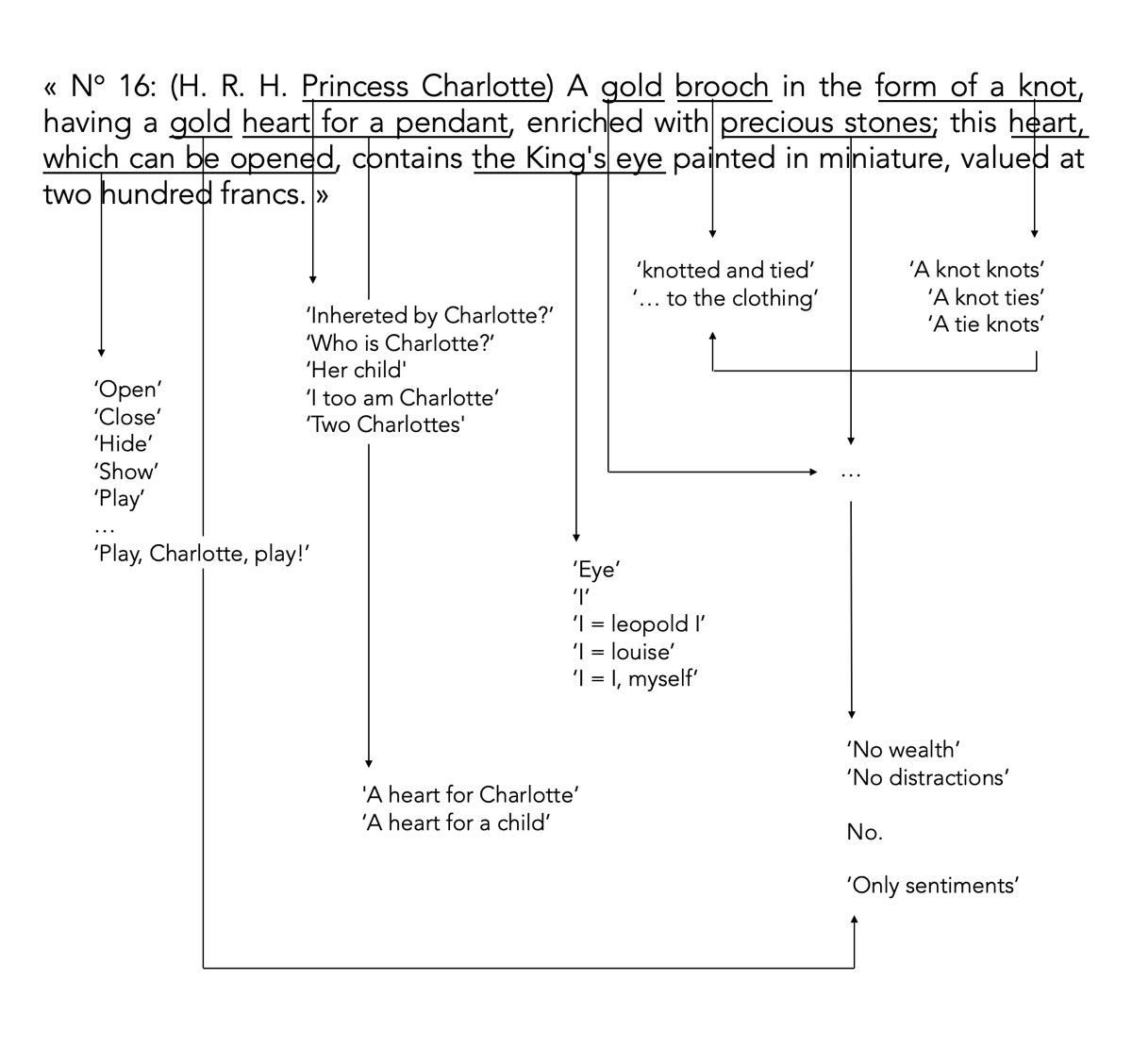
The associations that emerge from these streams of thought eventually substantiate into visual images, images that stimulate the maker to collect materials and sort out technical details. This is where the material confabulation comes in. Reflection and creation go hand in hand; both can only take place in constant interaction with each other. The mind moves the hands – and vice versa – until I obtain a new N° 16. This new piece has been stripped of its wealth and can no longer show off royal status. The shimmering of the gold and precious stones just blind the eye too much. The childlike heart invites to play. It gives the young Princess Charlotte comfort, distracts her from her grief. Inside the heart, the invitation ‘Place I Here’ reveals itself. An ‘I’, like in ‘Eye’, referring to the eye miniature? Or to leopold I? To louise maybe? Or to I, myself, the maker, who might also want to play along? Once closed, the heart is eventually ‘tied’ to the clothing. An abstracted bow-’tie’ presents itself as both a decorative element and a functional brooch mechanism.
Jewellery piece N° 16 was once a lover’s gem given by Leopold to Louise. Princess Charlotte cherished the piece after Louise’s death, until it finally disappeared. While confabulating, a fragment of Louise’s love for both Leopold and Charlotte is reactivated. A new jewellery piece emerged that renews a past reality. A reality that tells of Louise-Marie d’Orléans, first queen of the Belgians.
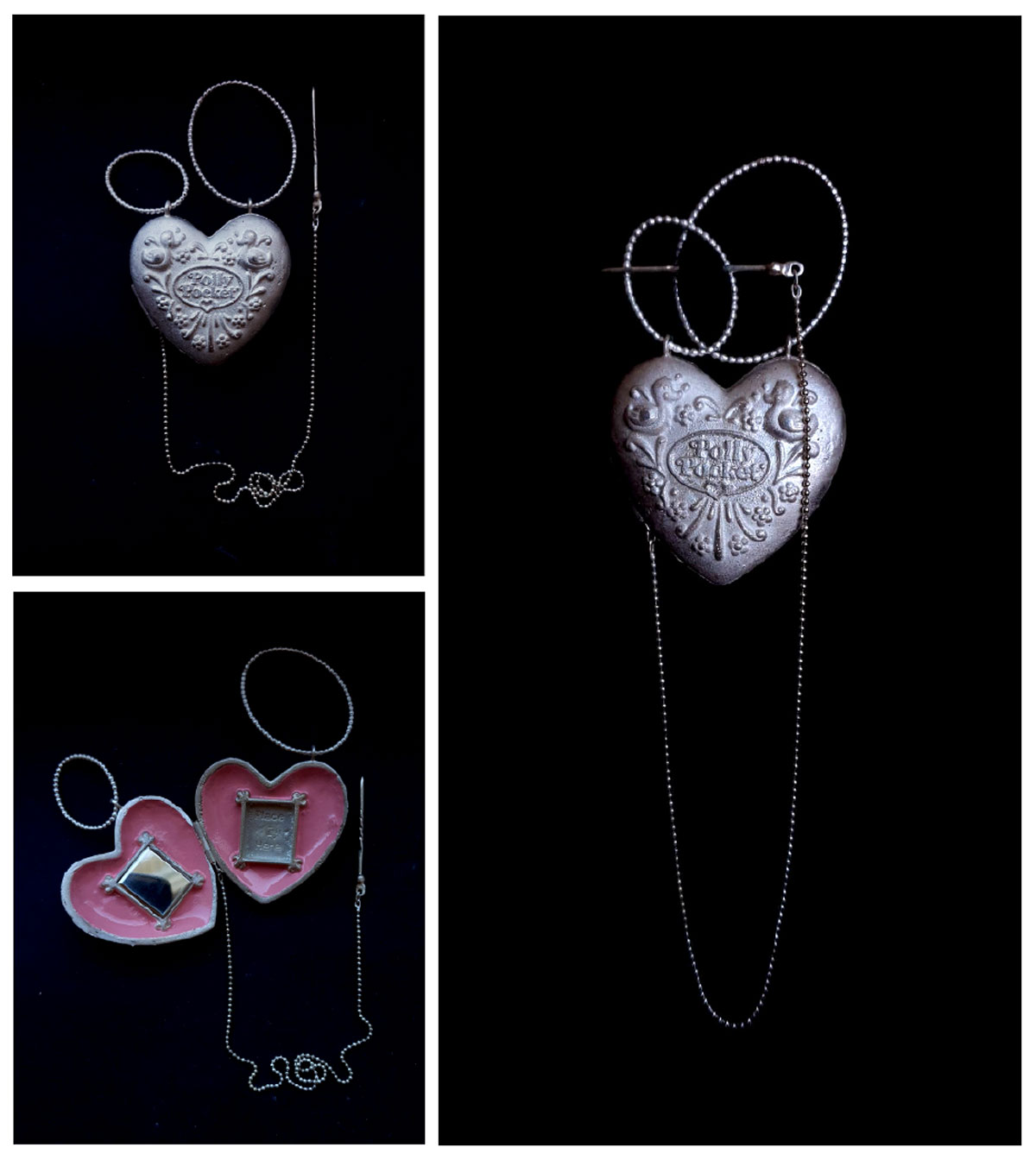
Notes
- 1 Marguerite Coppens, Elke bruid is een prinses: het verhaal van de bruid in België van de 19de tot de 21ste eeuw (Brussels: Koninklijke Musea voor Kunst en Geschiedenis, 2001), 148.
- 2 Monika Palmberger and Jelena Tošić, Memories on the Move: Experiencing Mobility, Rethinking the Past (London: Palgrave Macmillan UK, 2016), 1-2.
- 3 Ibid, 6.
- 4 László Munteán, Liedeke Plate and Anneke Smelik, Materializing Memory in Art and Popular Culture (London: Routledge, 2016), 11.
- 5 Remember the famous ‘madeleine scene’ in La Recherche du Temps Perdu, where Marcel Proust’s character, after tasting a madeleine dipped in blossom tea, is suddenly overwhelmed by childhood memories of the village of Combray and his great-aunt Léonie. Ibid, 2.
- 6 Michelle Facos, An Introduction to Nineteenth-Century Art (New York: Routledge, 2011), 77.
- 7 Dominique Marechal and Francisca Vandepitte, De romantiek in België: tussen werkelijkheid, herinnering en verlangen (Tielt: Lannoo, 2005), 76.
- 8 Estate Inventory of the movable property belonging to Louise-Marie d’Orléans, first queen of the Belgians, 1851, Conway Archive, folder 114, Brussels: State Archives of Belgium.
- 9 Griet Byl and Christophe Vachaudez, Koninklijke juwelen van de koninginnen en prinsessen van België (Tielt: Lannoo, 2004), 11.
- 10 Regina Schulte, “The Queen – A Middle-Class Tragedy: The Writing of History and the Creation of Myths in Nineteenth-Century France and Germany,” in Gender & History 14, no. 2 (2002): 269.
- 11 Heta Aali, French Royal Women during the Restoration and July Monarchy (Cham: Springer International Publishing, 2021), 9.
- 12 Virginia McKendry, “Taming the Sovereign. Princess Charlotte of Wales and the Rhetoric of Gender,” In Strategic Imaginations. Women and the Gender of Sovereignty in European Culture, ed. Anke Gilleir and Aude Defurne (Leuven: Leuven University Press, 2020), 256-290, here 278.
- 13 Pascal Gielen and Nele Wynants, “De queeste van de menswetenschappen,” in Forum+ 25, no. 1 (2018): 6.
- 14 Gielen, “De queeste van de menswetenschappen,” 12.
- 15 White, “The Question of Narrative in Contemporary Historical Theory,” in History and Theory 23, no. 1 (1984): 1-33.
- 16 Gielen, “De queeste van de menswetenschappen,” 12.
- 17 Ibidem.
- 18 Jon Shaw and Theo Reeves-Evison, Fiction as Method (Berlin: Sternberg Press, 2017).
- 19 David Burrows and Simon O’Sullivan, Fictioning: The Myth-functions of Contemporary Art and Philosophy (Edinburgh: Edinburgh University Press, 2019), 1-2.
- 20 Caroline Evans and Alessandra Vaccari, Time in Fashion: Industrial, Antilinear and Uchronic Temporalities (London: Bloomsbury Visual Arts, 2020), 29-30.
Moved by the object
Laura Vandewynckel
L’appèl
“We’re overwhelmed, suffering from bad news fatigue.” We have seen uncountable faces of people fleeing their country in search for shelter. They’ve blurred into an anonymous black hole, unfathomable for a simple mortal. We are occupied with closer-to-bed concerns, begging for a time-out of “hardships which are not our business.” During our oblivious nap, however, a million faces appeal for recognition. They have shimmering eyes, soft smiles and hairs whirling in the wind. They remain unseen, unheard.
From September to November 2020 Amal travels Europe. She’s tall for her age, 3,5 meters to be exact, gentle, and a bit stiff. Her eyes shimmer, her smile is disarmingly soft. Wherever she passes, crowds flock together to marvel at this young girl travelling 8000 km in search of her mother. Amal is an automated giant, created by the Handspring Puppet Company. She is on a cultural odyssey transcending borders, politics and language, to remind us of the millions of displaced children like her, in search of shelter, separated from their families. Amal has become the talk of the town.
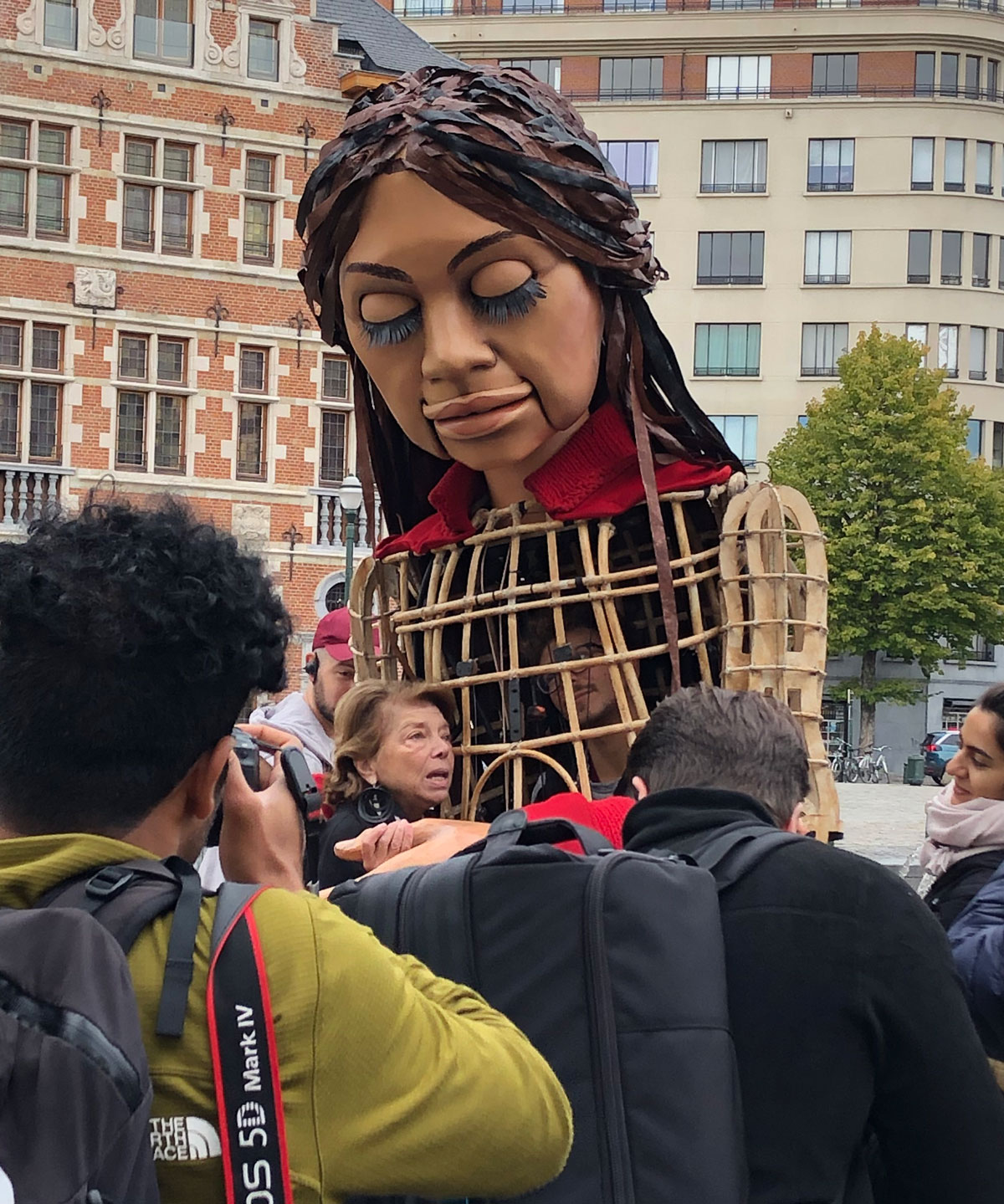
It takes a puppet to raise a child
The creative team of Good Chance and the Handspring Puppet Company have created a strong community-building interaction ritual. The heart of that ritual is a young girl’s effigy, which, through her lifelike gestures and charm, becomes – in the words of her creators – “a communicator and empathizer1” and wakes us out of our slumber. Built out of canes and wires, collectively brought to live by her puppeteers and her audiences, Amal has the power to brush up our minds, to make us wonder about the situation of real children resembling Amal, whom we have forgotten.
Amal’s walk reveals the impact of the automaton on audiences. What can an automaton achieve that a human cannot? How can a bunch of canes and screws so strongly affect us? The investigation of ‘thing-power’ is one of the scopes of my research on thaumata automata as triggers for social change. / τῶν θαυμάτων ταὐτόματα / is a term borrowed from Aristotle’s Metaphysics. Thauma means wonder, automaton means self-moving. Aristotle refers to automatic wonders that inspire metaphysical curiosity:2 the same way we are puzzled by and inquiry about these automats, we wonder and learn why all things are as they are.
Assuming that automata indeed have a power to make us wonder, can they be used to confront us with and teach us about social injustices and our responsibility for these? And if staged in public space, as a part of a collective interaction ritual, do they have a community-building potential? To find out I started ‘invading’ public space with automata: puppets, robots and kinetic sculptures. The encounter with them is always sudden and ephemeral. The hope is to bewilder the spectator, to encourage interaction and reflection and to offer a moment of togetherness.
First of all, there are the scapegoat projects, presented under the names Pharmakos, the Sin-eater, Cat Consolation, which I discuss below. Another long-running project is the participative choreography Stick Together. It has been performed on several public squares in Brussels in 2020 and 2021, and is made by and for Brussels citizens or visitors. It departs from international stick games, dances and fights. The attempt to play a stick game together is a metaphor for the social game we try to play daily in a community that is increasingly diverse and competitive. We want to collaborate, but never lose. We have to deal with cocks of the walk, hacks, nit-pickers, tacticians, cheaters, know-it-all’s, winners, losers, bad losers. How do you play that game? Which game?
Finally, there is The Unheard, a project initiated by K.A.K. and CREW and to which I contributed. K.A.K. is a Brussels group of 17 multidisciplinary theatre makers and “tinkerers”. CREW is a Brussels experimental theatre company that aims to visualize how technology is changing us. The Unheard was created during the Brussels lockdown in 2020 and was an attempt to answer two fundamental needs that emerged during the lockdown: how could we create intimacy remotely? And how could we represent the voices hushed by the public noise during the crisis? Five automated horn robots were presented in public space as the megaphones of unheard voices. The voice of the introvert, for whom the lockdown was a blessing, of the elderly, whose fate in corona times was discussed by many, except, it seemed by the elderly themselves, the voice of the youngsters who were banned from the suburban squares, of artists bereft of a platform, the voice of all mouths figuratively and literally masked. The robots drove through streets connecting people through talks and songs, mediating a public conversation.
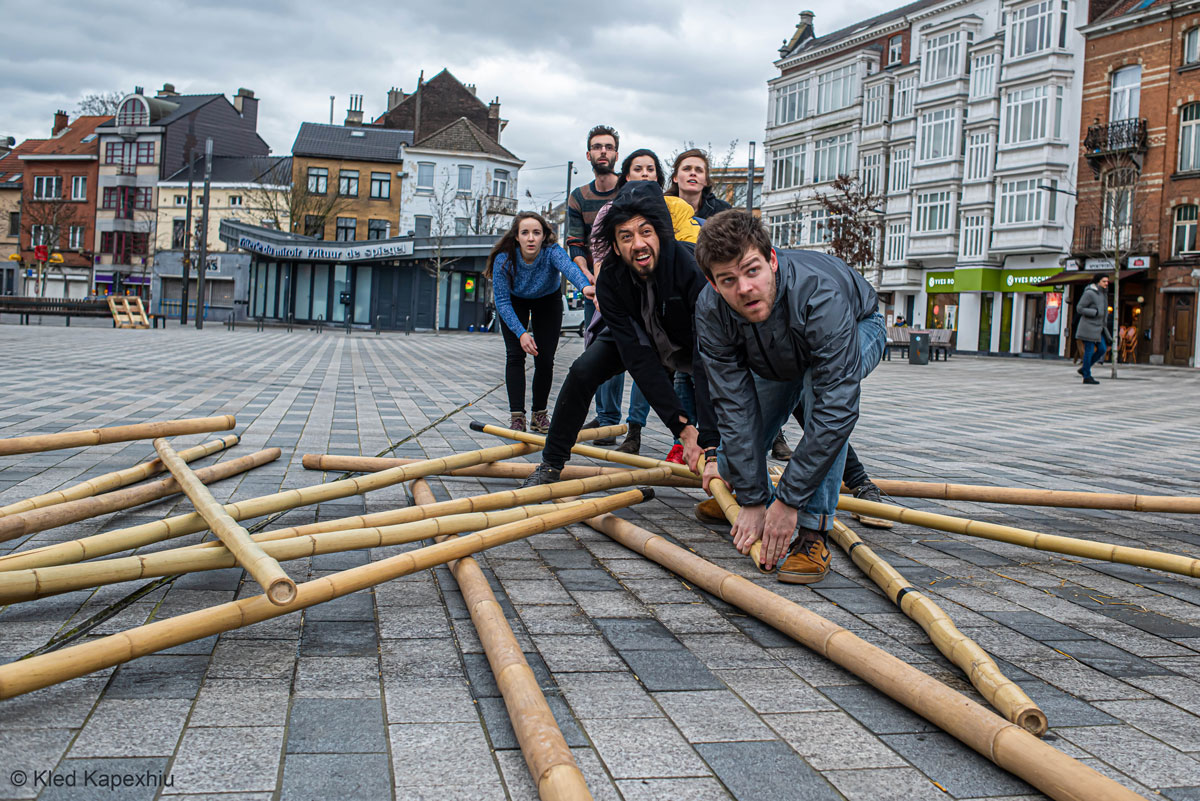
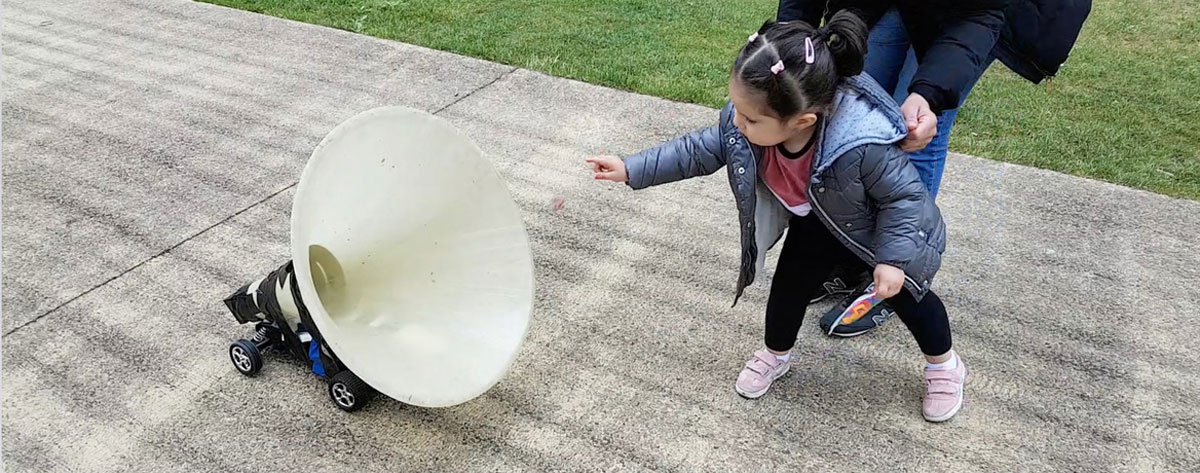
The scapegoat mechanism sublimized through myths and rituals
Pharmakos, The Sin-eater, Cat Consolation and Let the sea take away all the evil make up the different scapegoat projects. They are aimed at the dissection of a very specific psychological mechanism, ingrained in the human psyche and cultural history. The scapegoat mechanism refers to a tremendously fascinating trait which is more familiar to us than we are willing to admit. This (in)humane mechanism saved individuals, groups, or large communities from internal conflict in the short term, but made countless people suffer both in the short and the long term. Every day we unwittingly shift the blame of our misfortune to innocent others, sparing us from the toughest question: Am I to blame? Am I responsible?
Since the beginning of time, this subconscious mechanism has been reflected and sublimized in myths and rituals, which serve to channel our frustrations and strengthen the bonds threatened by crisis. They have become less violent over the course of time. The ancient pharmakos ritual for example, in which real people were sacrificed, has morphed into the still widely practiced ‘non-violent’ judas burnings, in which a puppet-like embodiment of a community’s persona non grata is collectively beaten and burnt. A seemingly innocent scourging-by-gossip might be considered its contemporary equivalent. But are these evolved rituals and myths really devoid of direct violence—are they really less harmful? How innocent has been the ritual burning by the Croatians of two kissing gay puppets?3 How harmless is the myth of Great Replacement or the complot theories rampant around covid-19 vaccination? Cultural anthropologist René Girard (1923-2015) has investigated dozens of ancient and contemporary rituals and myths and distinguished in them the stereotypes of persecution. As the myths are always told from the perspective of the persecutor, the scapegoat mechanism is neatly tucked away in self-legitimation and lies, cunningly proving the scapegoat is guilty and the violence against them justified.4
The awareness that there is no escape from this inherently violent mechanism and the harmful myth- and ritual-making that comes with it should not keep us from searching for less harmful alternatives. Girard states that if we want to put an end to the violence, we need to deconstruct the scapegoat myths, expose their lies (stereotypes of persecution), and retell them from a different perspective.
Pharmakos – Sifnos
In 2016 I was invited to create a short film on the Greek island Sifnos. I had never heard of René Girard. At that time, my mind was troubled, and I was desperate for consolation. Being an atheist, I envied those who find comfort in religious rituals. Researching the project, I chanced upon an ancient ritual which apparently took place around the 6th century BC in Athens and other towns in the Mediterranean region called Pharmakos. Pharmakoi means ‘medicine’ in Old-Greek but also ‘poison.’ Every year, before the first harvest, during the Thargelia festival, or in case of war, pestilence or famine, the Greek citizens chose two men “of low origin and useless” and “common and maltreated by nature”, onto whom they transferred the bad luck that had hit or might hit the town.5 During an extensive ritual ceremony these men, burdened with the sorrows of the people as a whole, were bombarded with stones and burnt. Thanks to their ritual but all too real removal, the citizens felt appeased.
I decided to bring the ancient Pharmakos victims back to life in the shape of two human-like objects and crafted two life-size mechanic puppets. Packed with limbs and heads I flew to Sifnos. There, the Pharmakoi meticulously reenacted the archaic ritual as described by the historians. They collected stones and handed them out to the people of Sifnos, who were invited to inscribe them with whatever they wished to get out of their mind: fears, sorrows, angers or the names of whomever had caused them. In the meanwhile, the pharmakoi chopped wood for their fire and dragged the poles onto which they would be hung. On the night of the ritual, right outside the walls of the village, they were beaten up, stoned, and burnt.
The Sifnos experience had a big impact on me and, more than I had anticipated, on the people of Sifnos. My companion Nienke Deutz and I had been parading these pharmakoi around the island, initially much to the hilarity of its inhabitants. The puppets were quiet listeners during the many interviews with passers-by and participants. Unconsciously, we had started to like these clumsy puppets. When the moment of the ritual had come, and we invited the participants to throw their burdened stone onto them, it left us all with mixed feelings. For sure, it was a relief to hit these objects hard with the stone that carried our burden, but the result of our actions rebounded in our minds. The foam head of the puppets became the faces of those whom we had ranted against in our stories. There were dangling on their poles, staring at us.
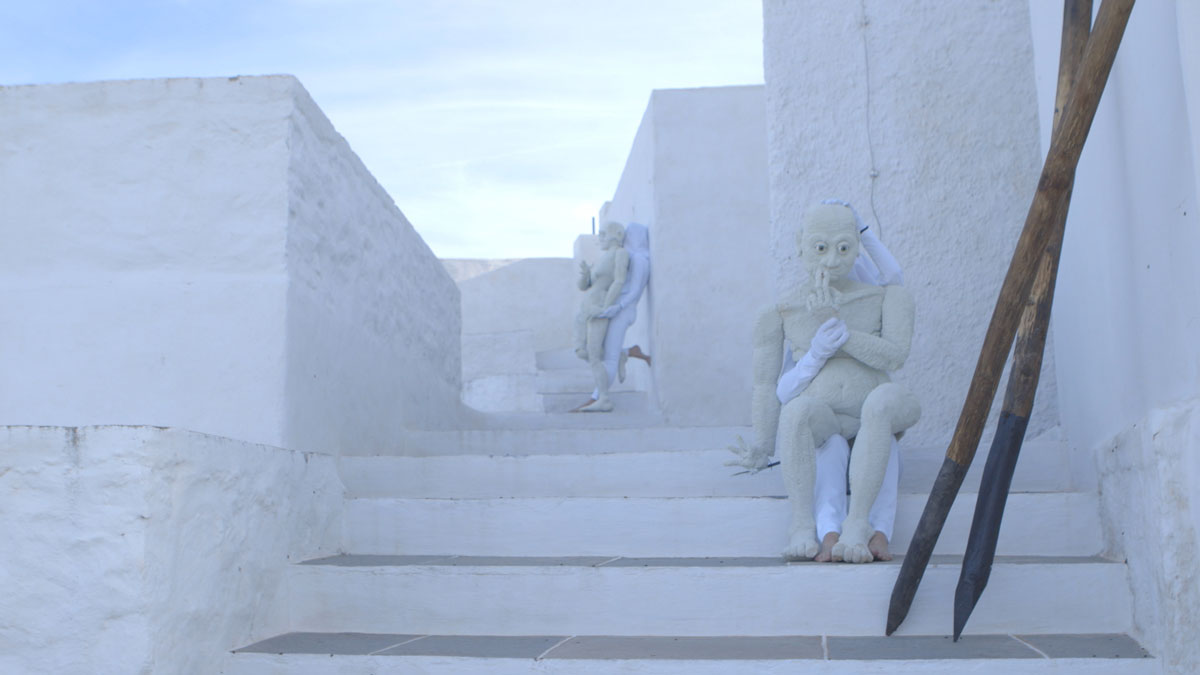
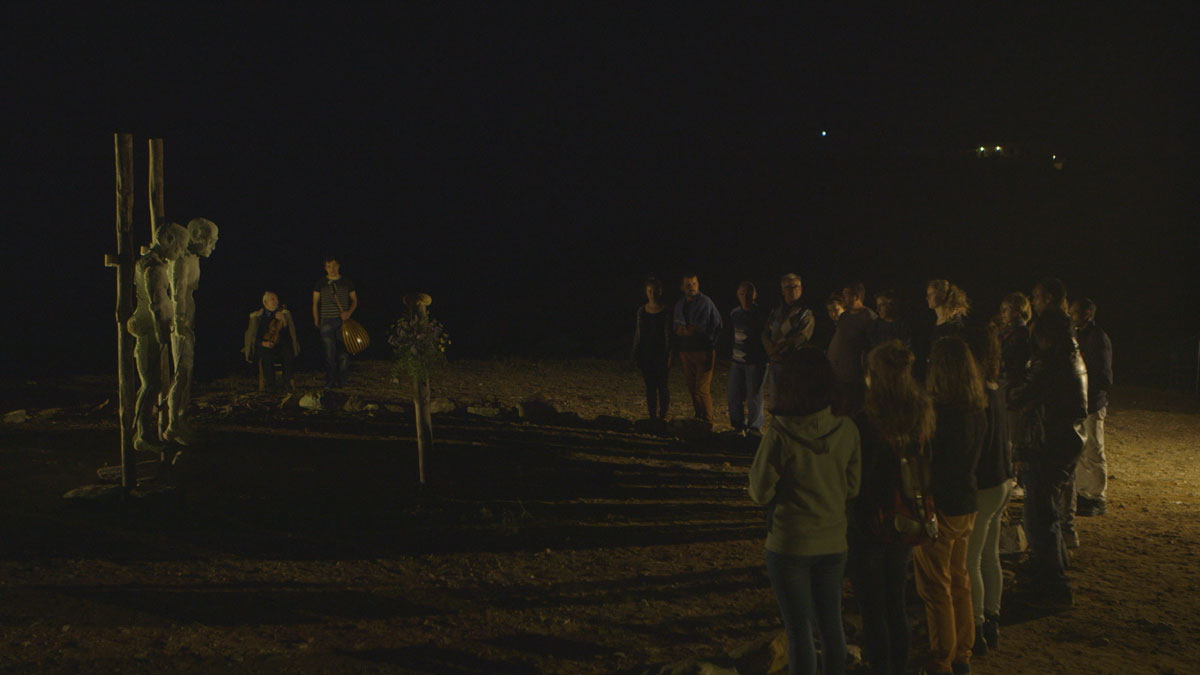
The scapegoat projects
The Sifnos experience marked the beginning of a series of scapegoat projects. Each time, such projects depart from an ancient or contemporary scapegoat myth and ritual, which is then de- and reconstructed by social artistic means. The ambition, naïve as it might be, is to turn existing scapegoat myths and rituals into new ones that would put a spell on us and at the same time unravel their own lies—that delude and confront us, that blatantly show our responsibility, but at the same time sooth and relieve us from carrying that responsibility.
The approach is based on two artistic elements. First, non-human automata would mount the stage. These animated inanimate objects are deployed as a method to externalize the mechanism, to lift it from the subconscious realm, to visualize it and make it debatable. They exhibit three characteristics which distinguish them from human actors and make them, in my view, more apt for the task.
(a) You could tell they are negligible, mere assemblies of wood, screws and ropes, lacking a soul, blessed with the gift of feeling no pain, no emotion, impervious of the violence we inflict on them. At the same time, however, they are very much alive, affectionate and “like us”, and if we take a closer look, we’d swear we have seen tears in their eyes.
(b) In scapegoat myths the scapegoats are said to have deliberately chosen their roles. To problematize this idea of voluntariness, I choose to underline the active-passive paradox of the animated dead object. Automata seem to act on their own, but at the same time we are aware they are manipulated and bereft of agency.
(c) Scapegoat myths are ideologically and politically charged. It does not need explaining that their narrators would be offended by hearing their truth be called a myth. A lifeless thing, on the contrary, is neutral—or at least, neutral at the start. It is a carte blanche, an Every-Body which can be invested with whatever identity or conviction.
Second, as the interventions happen in public space, the spontaneous interactions with the passers-by as audiences and participants are another essential element. The automata do not actively address people, as they have their own occupation, they are out there in the streets to fulfil their own tasks. However, when addressed by passers-by the interaction slowly builds up. The spontaneous encounters trigger stories and testimonies. In the summer of 2020 and 2021, for instance, we ventured out with a cat. This automaton was inspired by the cat-throwing ritual that has been held for centuries in the Belgian city of Ypres. On the annual fair, a number of living cats would be thrown from the 70 meters high belfry. (Nowadays the real cats are replaced by toy cats.) Up till today, the official explanation for the ritual is that cats were simply too numerous . During our interventions we brought one of those damned cats back to life. The animal searches for the real roots of this bizarre habit in the streets and living rooms of contemporary Brussels, Poperinge and Ypres. People stoop down to caress and to cuddle it, it is invited inside family houses, it snores on the lap of elderly ladies at the care center. The video Cat Consolation can be watched here.
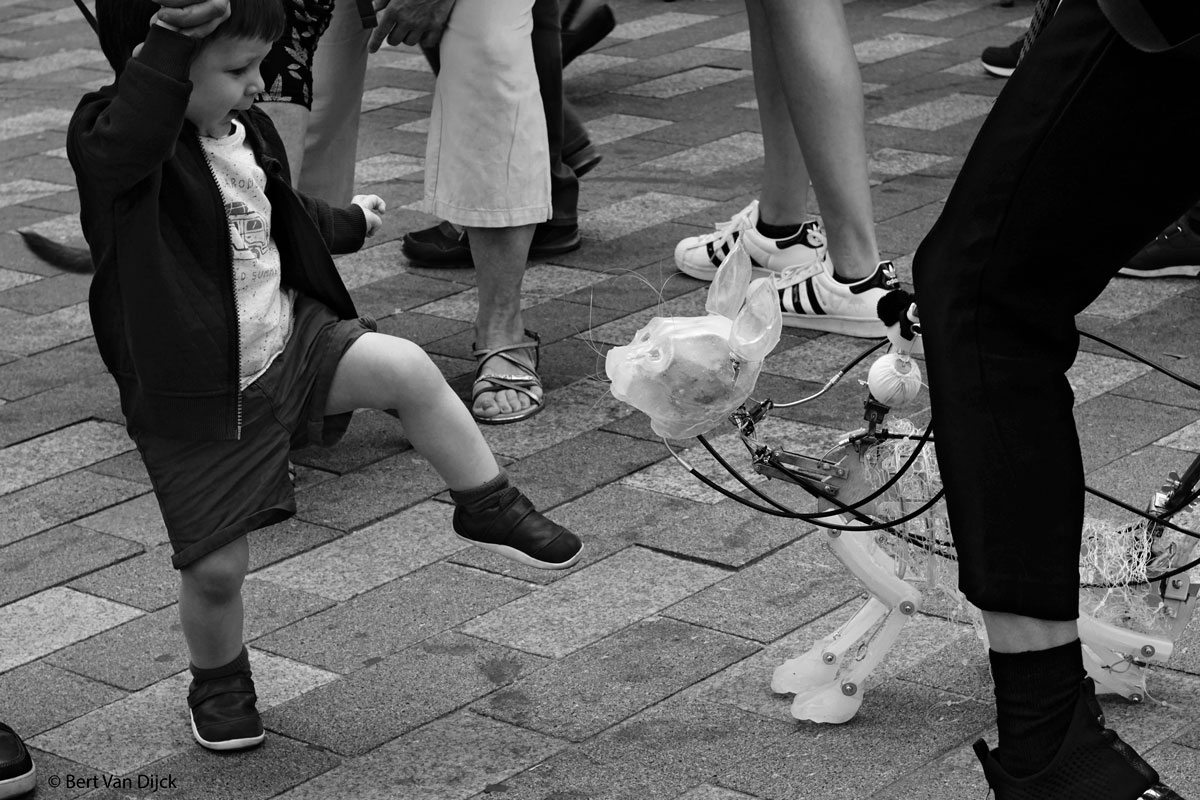
In the future, the collective approach will be expanded and even the handling of the puppets and the scripting of their actions will be lent to whomever feels like participating. By collective playing and voicing, the automata will come to represent the polyphony of visions and turn into containers of meaning.
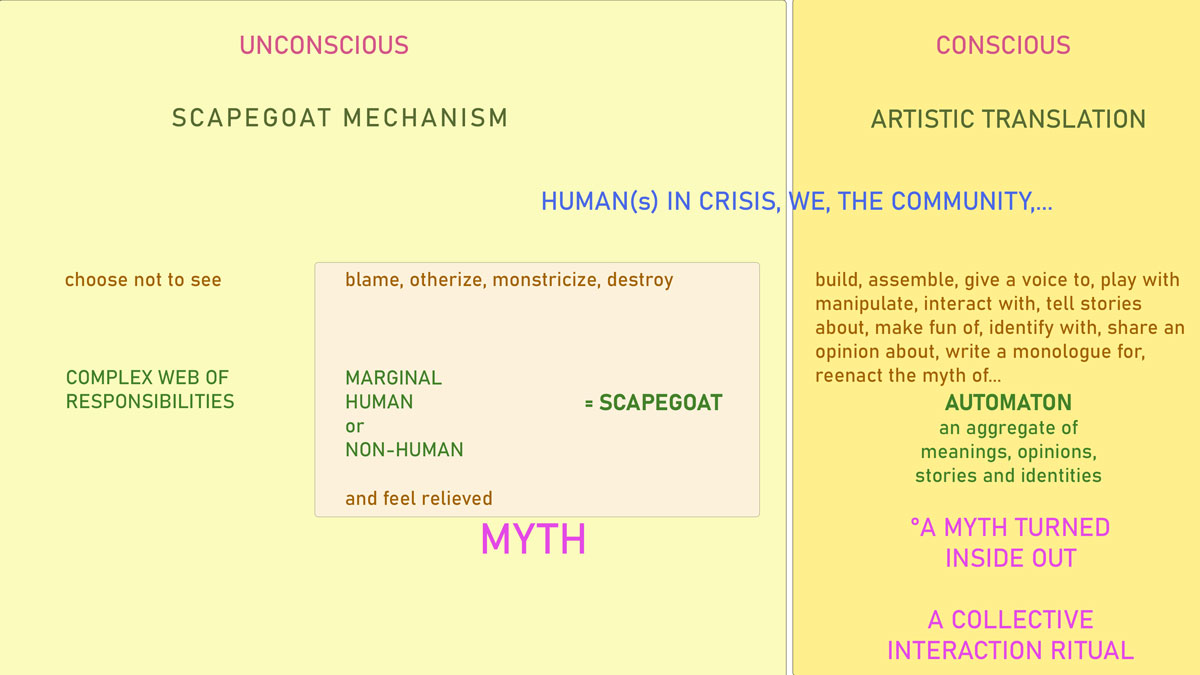
Human-non-human hybrids
The creatures staged in the scapegoat projects are never fully non-human; they are, instead, assemblies of human, animal, plant and object elements. They recall the Latourian concept of hybrids or mixtures of nature and culture6consisting of human and nonhuman components that exchange properties, mutually translate one another, shift their capacities.7 The human and non-human object co-exist horizontally and symmetrically. This flat ontological conception of reality is contrary to a long philosophical tradition, which draws a clear line between a superior human subject and an inferior non-human world of animals and objects. The non-human world only matters to the extent that we, humans, perceive it, and is only valuable if we humans can control it and make use of it. In the past we bridled horses, water, and forests, reined and exploited objects and animals for our (mental) comfort and survival. In a drastically changing natural environment and with technology penetrating our daily lives, we increasingly touch upon the borders of our capacity for control. We can no longer view ourselves as the puppeteers of the object world. In fact, we are no more puppeteer than puppet, played by the non-human forces around us. Forest fires, excessive waste, invasive animals, viruses, artificial intelligence, … have an effect on us as much as we influence them. What’s even more, we can no longer see ourselves as separate from these entities. We are entangled with them in complex networks of meaning … and responsibilities.
Pharmakoi, let the sea take away all the evil
In 2018 I travelled to Brazil, to the island Itaparica, for an artist’s residency. This island is located 40 minutes by boat from the metropolis of Salvador in the Baia de Todos os Santos de Bahia. From the outside, Itaparica is a tropical paradise with a very rich cultural history, exuberantly celebrated during the many colourful festas. In reality, the island faces serious challenges: there is constant drug violence, police violence, high unemployment, a healthcare system collapsed by COVID-19. Itaparica is decaying and sees its last factories closing. Anti-establishment sentiments run high.
Already upon arrival I was amazed by a peculiar phenomenon. In the middle of the overgrown streets, hardly visible in the shade of streetlights, horses would emerge. They stood still and stared. On the 7th of January I attended the speech by the mayor of Itaparica on Itaparica’s Independence Day. She was rightly proud of her accomplishments and fully aware of the big challenges she and her team face in Itaparica. After an enumeration of problems-still-to-be-tackled, she said: “We have a lot of problems, but what really makes our throats tick is those horses in the street. I’m not afraid to talk about it!” I had marveled at these beautiful fairytale-like horses, so for me as an outsider it was hard to understand why these horses were a problem. I asked around and heard they were a true nuisance: they invade houses, leave the streets filthy, they cause car accidents and when they die, their corpses often linger there for a long time. It felt strange to hear the horses being mentioned in the same breath with public health issues, drugs violence, and poverty. I was wondering whether the horses maybe were the only of these problems that could readily be tackled: eliminating horses is way easier than tackling persistent poverty and violence. I assumed their removal would mean a lot to the people of Itaparica, who told me they were fed up with the inertia of the Brazilian government and the lack of prospects. I decided to explore this assumption further.
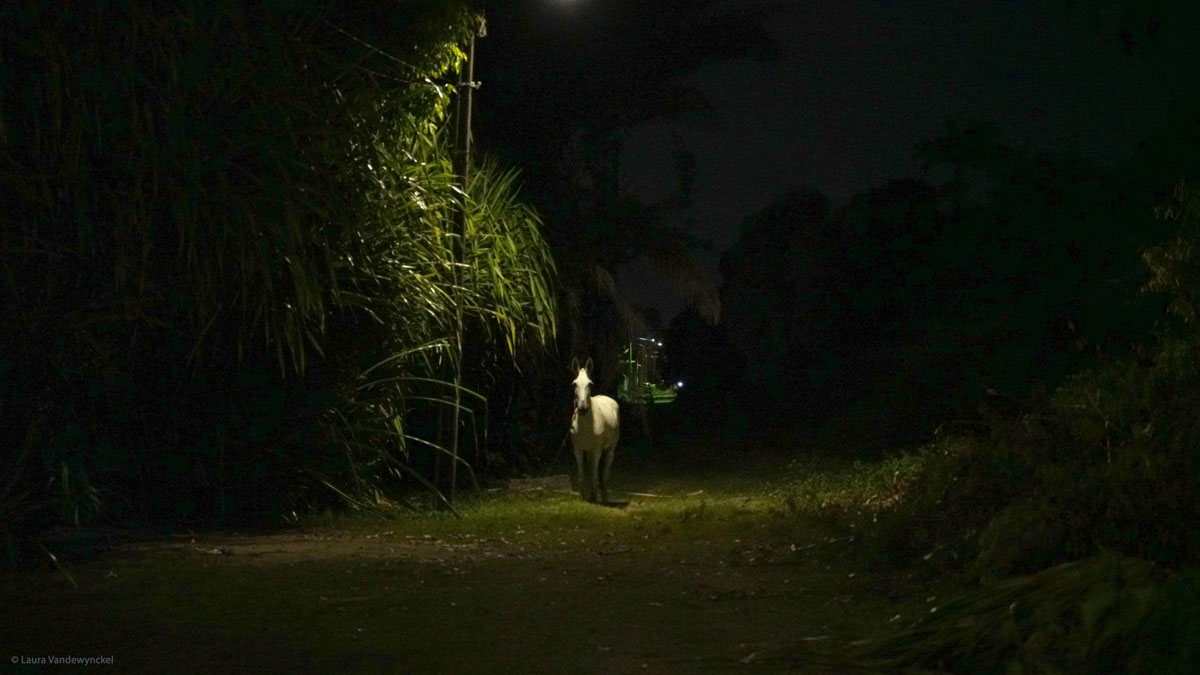
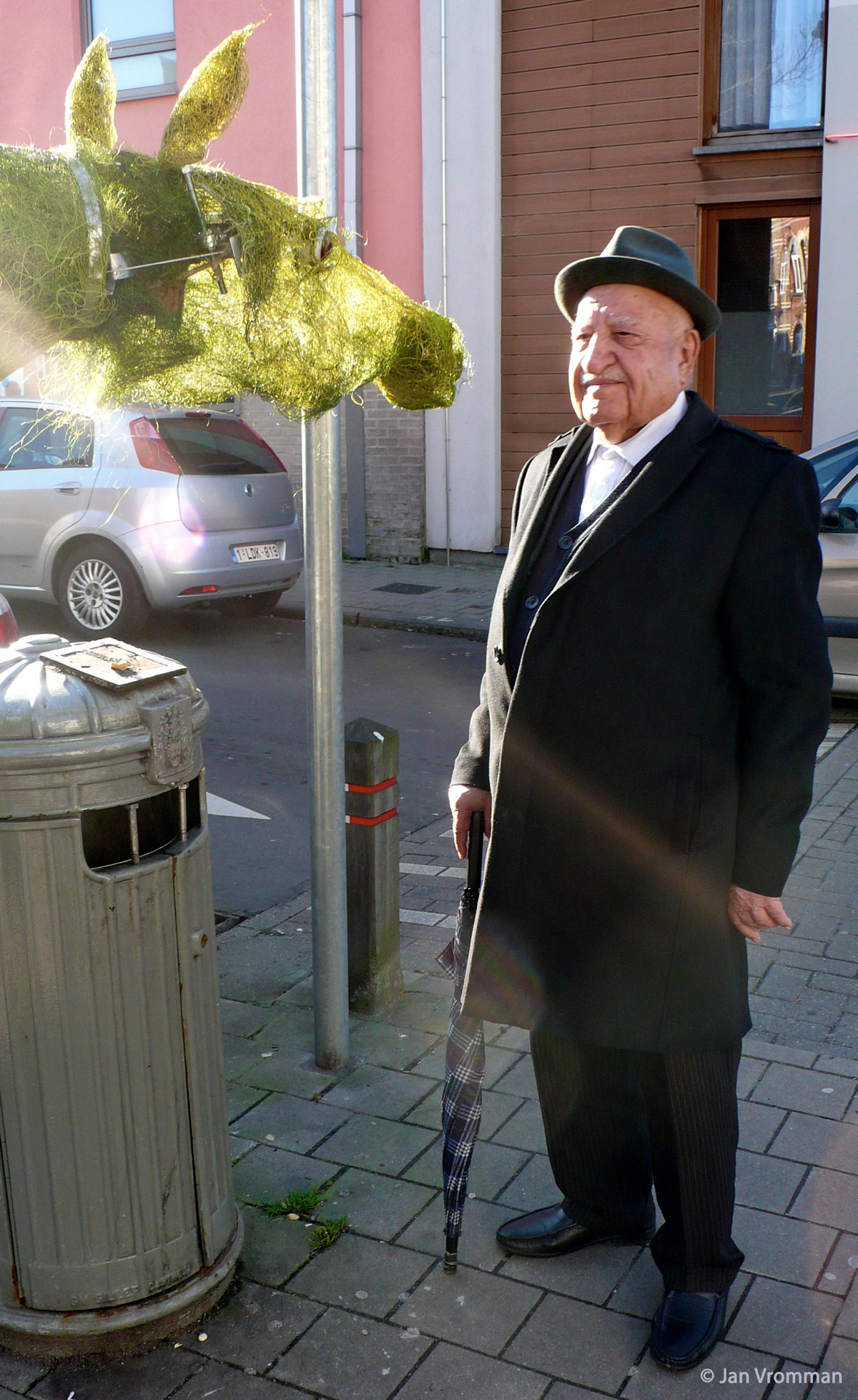
Back home we recreated the horse in the shape of a hybrid automaton. Our hope was to travel back to Brazil with it. However, before undertaking such an ambitious journey, we wanted to test the mechanism and find out if the automaton would in some way affect the passers-by when released in public space. We roamed the streets of Jette for three days. We invited people to saddle the creature with their burdens. In the following video (password: zondebok) you can watch the result.
After two years of postponement due to the covid crisis, the documentary film project in Brazil has finally taken a new start. The film’s treatment is currently being written in dialogue with Brazilian filmmaker Camila Grégorio. Also the street horse is well accompanied now. It will take up the protagonist’s role together with two other damned non-human entities, which mark the Itaparican landscape and offer considerable food for debate. Like the horse, the bridge and the paredão got caught up as scapegoats in a web of political, social and economic tensions.
In Itaparica, there are two possible stances: you are either for or against the bridge. For twelve years now, the governments of Itaparica and Salvador have been thinking about building a bridge to connect their territories, and for just as long this bridge has divided the island. The conviction that the bridge will economically revitalise the island through the influx of businessmen and tourists clashes with fears that the bridge will pose security problems due to the ‘dangerous invasion’ of people from the mainland and of the Chinese. After all, people think, with this construction project, investor China will hold the region in its grip for 35 years. The project for ‘the longest bridge in Brazil’ costs billions and also comes with a major ecological cost. Hundreds of acres of nature reserve will make way for the construction of the bridge and the building of fenced communities. Will the bridge jeopardise the unique cultural identity of the island, or will it revitalize the island? One resident states: “With a bridge, an island ceases to be an island.”
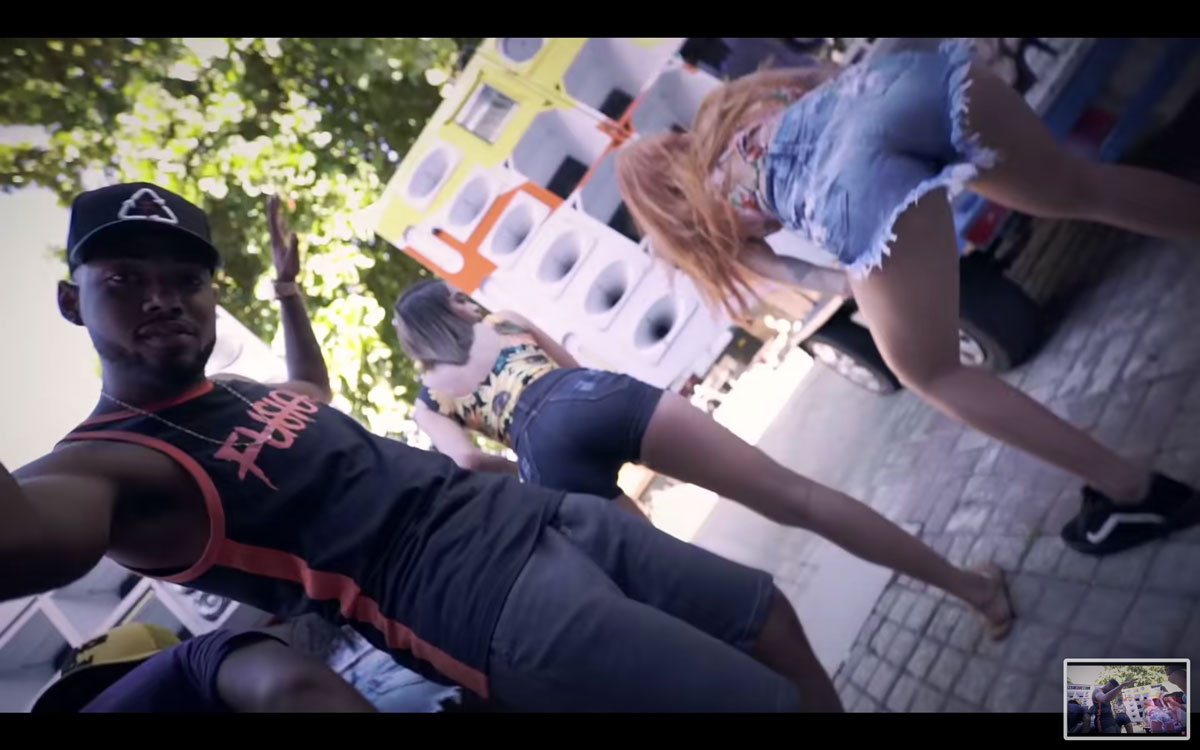
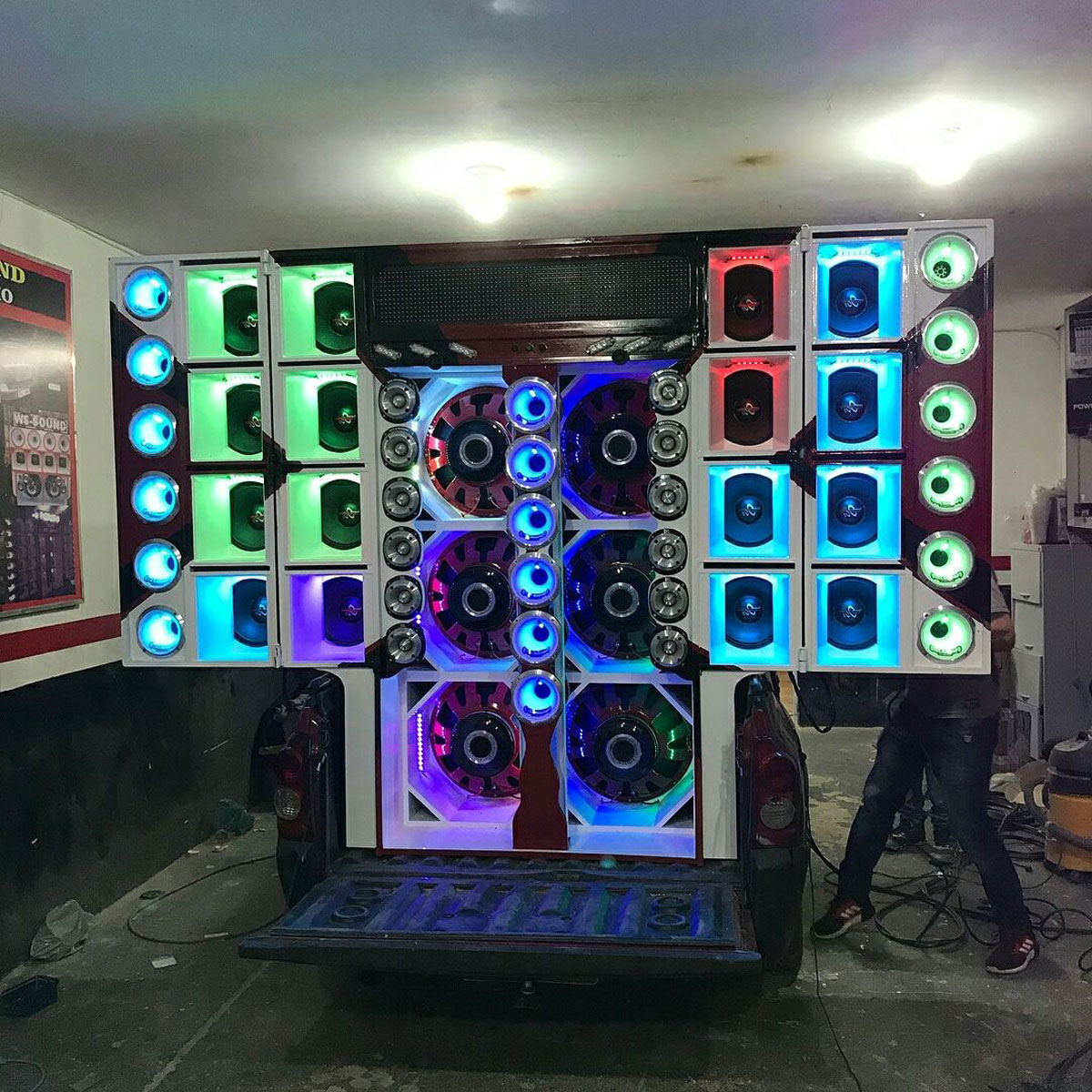
The third character recalls the former project The Unheard and can be considered as their Brazilian brother. Local authorities hunt down paredão every week. These deafening mobile speakers play a symbolic role for the young people of the slums, who gather around them, twerk and drink. They live hidden in the trunks of cars, bear names like Tough John and Hot Tracey, pop up clandestinely and shout it out: decibels of funk and pagoda-style tunes full of raw, politically charged frustration and pornographic escapism reverberate through the night. The speakers are despised by the evangelical church and the middle-class community. The police have a full-time job confiscating and publicly executing these indecent troublemakers.
For each of these three main characters, we write a fictional microscript based on the fates of their real-life counterparts. The horse is looking for a home (but is not welcome anywhere), the speaker wants to be heard (but is silenced), and the bridge wants to connect (but does nothing but divide). Their stories are performed in public space, by and for the people of the island. These automata are the instruments with which a multitude of ‘islanders’, i.e. insiders and outsiders, creative participants and casual passers-by, representatives of different communities and individuals, experts and local administrators, give their account of the facts. The script of the automata is constantly being rewritten by the people who play them, voice them or interact with them. The automata-scapegoats become passive marionets and mouthpieces at the service of their players. However, their active and living presence and their recognizable desires remind us of ourselves. Man and automaton melt together. The line between scapegoat and perpetrator, between man, animal and thing becomes blurred.
Conclusion
My artistic research is aimed at understanding if and how animated lifelike objects move us in an emotional and intellectual way. How can they activate us in order to reflect upon our behaviour? Through the series of projects I described, I experienced how the automata, however shabby they look, can strike a sensitive chord with casual onlookers. They make people stand still, they are caressed and spoken to in whispered “thank you”, they make passers-by open up to talk in natural ways. People speak about their sorrows, about the people they love or miss or about whatever the automata reminds them of. The interventions are heartwarming, emotionally soothing and socially inviting. This reconfirms the findings of researchers in AI and robotics investigating the potential of automata as social companions.
Still, we may wonder whether the interventions with automata are more than pleasant entertainment? The appearance and actions of the automata (who, in the eyes of the passer-by are just walking by without a clear goal) do not spontaneously trigger any in-depth reflections nor discussions amongst the public. People would ask what the intervention was about, and we would explain, as if providing the manual accompanying an abstract painting. People would understand and confirm. One could suggest that the intervention is too short and ephemeral to invite people to engage in a reflective way, let alone to genuinely participate in them. In any case, the interventions up till now habe had many shortcomings. The automata were probably too idle, and in their actions they distracted onlookers from their myths, so people could hardly link them to these myths. In Pharmakos and Cat Consolation, moreover, the selected myths were historical. On first sight, the myths are no longer relevant, they are obsolete relics of a folkloric past, which people no longer feel any affinity with. Everybody agrees it is outrageous to throw cats from towers. So even if we reenacted the cat-throwing with an automated puppet, we would be appalled by the cruelty of the act, but never question the reasons why our ancestors did this. Nor will we ever associate those practices with our current scapegoating practices. No one would wonder who the present-day cats or pharmakoi are.
Therefore, for the Brazil project, which is the cornerstone of my research, it has been a conscious decision to tackle topical myths, revolving around urgent and much-debated issues. The myths are so much part of the general public discourse that we would never call them myths. Precisely this makes them extremely valuable for a Girardian deconstruction. By a repetitive reenactment of these myths, from the most diverse perspectives, we assure that they lose their obviousness. The themes associated with the horse (poverty and governmental inertia), the bridge (economic progress versus incapsulation and preservation, cultural decline, natural sacrifice) and the paredão (the silencing of vulnerable groups) are highly relevant. They are not only relevant for the local island community, but for all figurative island communities we create on the back of the scapegoat on a daily basis around the globe.
The challenge for the next stage of the research is thus to deploy the automata as fora for debate. It would be unrealistic to expect that interventions will trigger discussions on the spot. It is the task of filmmaking to assemble many voices and interpretations and juxtapose them in a polyphonic film. The resulting bigger picture, unravelling the complex web of responsibilities, should serve as a catalyst for discussion. Finally, we will strengthen the participatory dimension and make even the construction, performing and storytelling into a collective process. The non-hierarchical co-creation and collective experience can transform the interventions into real interaction rituals that confront, connect, and sooth.
Notes
- 1 Good Chance Theatre, The Making of Little Amal by Handspring Puppet Company, 2020 https://www.youtube.com/watch?v=NgLrtWZQ24s [accessed 23 January 2022].
- 2 G. S. Bowe, ‘Thaumata in Aristotle’s Metaphysics A’, Acta Classica: Proceedings of the Classical Association of South Africa, 60.1 (2017), 50–72 https://doi.org/10.15731/AClass.060.03
- 3 Lippeveld, ‘Ophef om in brand gestoken pop van homokoppel in Kroatië', in De Standaard, 25/02/2020 https://www.standaard.be/cnt/dmf20200225_04864385 [accessed 23 January 2022].
- 4 René Girard and others, De zondebok (Kampen; Kapellen: Agora ; Pelckmans, 2001), p. 20-59.
- 5 Jan Bremmer, ‘Scapegoat Rituals in Ancient Greece’, Harvard Studies in Classical Philology, 87 (1983), 299–320.
- 6 Bruno Latour, We Have Never Been Modern (Cambridge, Mass: Harvard University Press, 1993).
- 7 Mike Michael, Actor-Network Theory: Trials, Trails and Translations (55 City Road, London, 2017) https://doi.org/10.4135/9781473983045.
d
clustered | unclustered(An)archive
Lieven Van Speybroeck, Agency, Saddie Choua
[T]o be en mal d'archive can mean something else than to suffer from a sickness [...] It is to burn with a passion. It is never to rest, interminably, from searching for the archive right where it slips away. It is to run after the archive, even if there's too much of it, right where something in it anarchives itself. It is to have a compulsive, repetitive, and nostalgic desire for the archive, an irrepressible desire to return to the origin, a homesickness, a nostalgia for the return to the most archaic place of absolute commencement.
— Jacques Derrida, “Archive Fever: A Freudian Impression”, in Diacritics, Vol. 25, No. 2 (Summer, 1995)
Something went wrong
Lieven Van Speybroeck
Permission Denied. Unauthorized. Forbidden. Permissions error. You don't have permission to perform this action. You're using an older version. Your computer is not supported. You cannot establish a secure connection. Connection refused by host. File is locked. Request TIMEOUT... Trying to connect. Trying to reconnect. Cannot connect. Host is down. You sent too many invitations. Service temporarily overloaded. File system is busy. Can't launch file. You do not have enough storage for this file. There are too many files. Please buy more storage. Files on different volumes. Too many open files. Too many files open. Maximum open file count reached. Purchase a larger storage plan. The system cannot move the file to a different disk drive. File table overflow. Cannot delete an open file. Can't exchange a file with itself. File id already exists. Duplicate file name. Happens when file already exists. Expected a folder, got a file. Malformed Macho file. Inappropriate file type or format. File descriptor in bad state. This file can't be previewed. This file is too big. This file is too big to preview. You can try again or check out our Help Center. Host unavailable. Additional participants couldn’t be added to the share. Can't share with user. Sharing was unsuccessful. A failure to connect to the servers. Sharing failed due to a network failure. Restart Backup and Sync. Syncing is stuck. Manually sync files. Can't sync data across devices. Unable to complete sync. Invalid file type. The file contains one or more syntax errors. The file is not a dictionary. The file is not a part of the assembly. Read-only file. Nothing to read. Read beyond logical end-of-file. Operation not supported. Can't launch file. Specified destination does not exist. A file could not be mapped. Result too large. Too large to be mapped. Illegal seek. Operation now in progress. The Enabler was asked to create a duplicate card entry. Foreign File system does not exist. ACCESS DENIED. Power to the card has been turned on. The context ID was not valid. Identifier removed. UNAUTHORIZED. Address is not in a file view. No file thread exists. No such record. Not supported. Deprecated. BAD FILE REQUEST. Operation not permitted. Argument list too long. Missing. File is corrupt. The system cannot open the file. Bad data in file. Need authenticator. Port was closed. FORBIDDEN. Bus error. Broken pipe. Improper driver dispatch table. Illegal sequence. Too many clients. Terminal driver still needed by someone else. No space left on device. No route to host. Can’t find the specified environment. HOST UNAVAILABLE. Bad address. Tracing error. Location name malformed. Track number wrong on address mark. Sector number never found on a track. Bad address mark bit slip nibbles. Move into offspring error. No child processes. Not enough room. Buffer too small. Network is unreachable. Tried to get a nonexistent property. Package 0 not present. Package 1 not present. Package 2 not present. Package 3 not present. Package 4 not present. Package 5 not present. Package 6 not present. Package 7 not present. Returned by driver. Step handshake failed. Reserved. Rejected. Transfer request was rejected. Privilege violation error. No locks available. Protocol error. Operation cancelled. No message of desired type. Too many processes. Too many users. Too many transactions. A coordinate overflow. General system error. Acceptable. Deflectable. Rejectable. Incorrect types. Invalid permissions. Reached end of file. End of file. Writing past end of file. Memory full. Cannot allocate memory. File won't fit. There are no more files. Out of memory.
boundary thing 001038 (Uniform Code and Nomenclatures
Agency
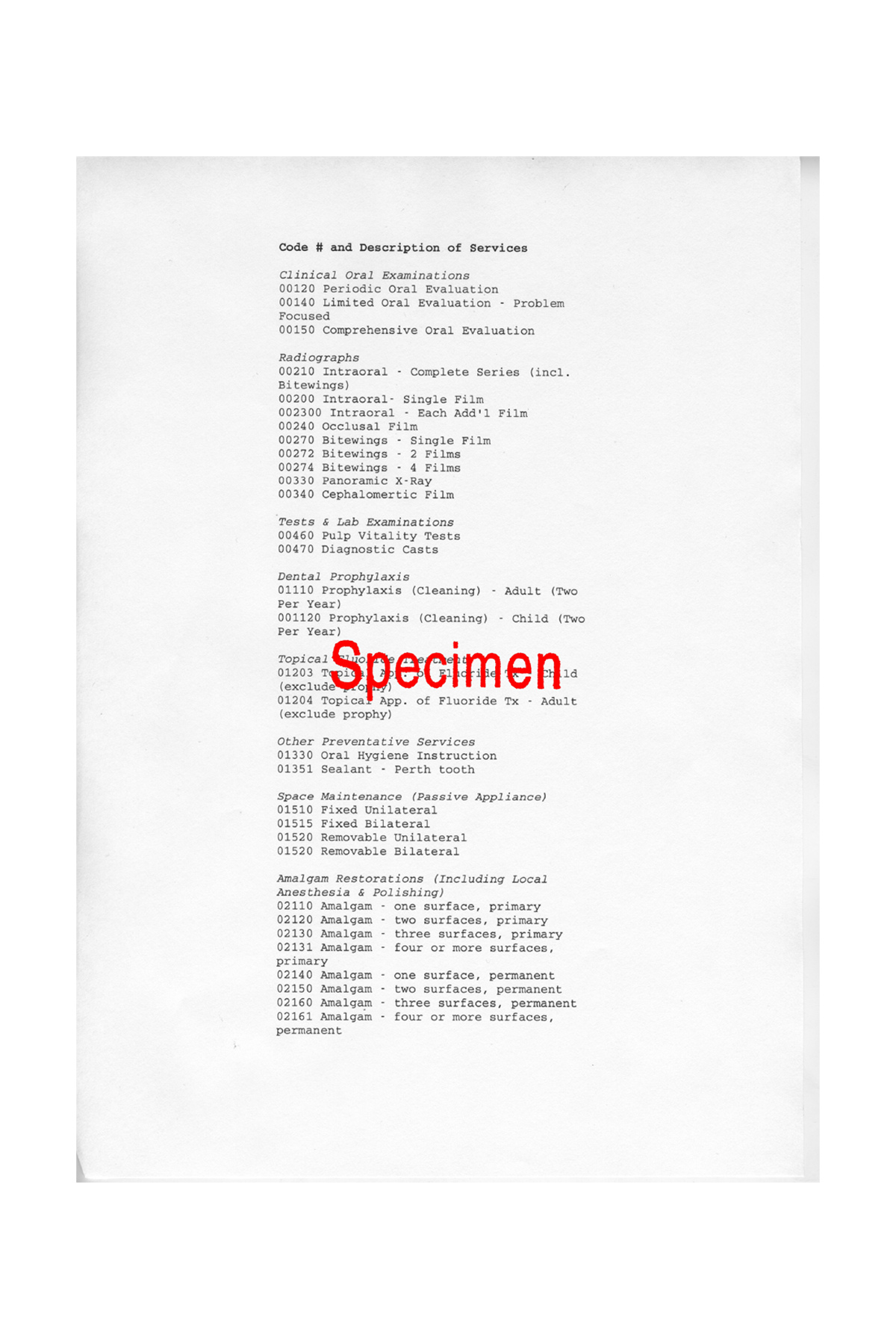
boundary thing 001038 (Uniform Code and Nomenclatures, page 1)
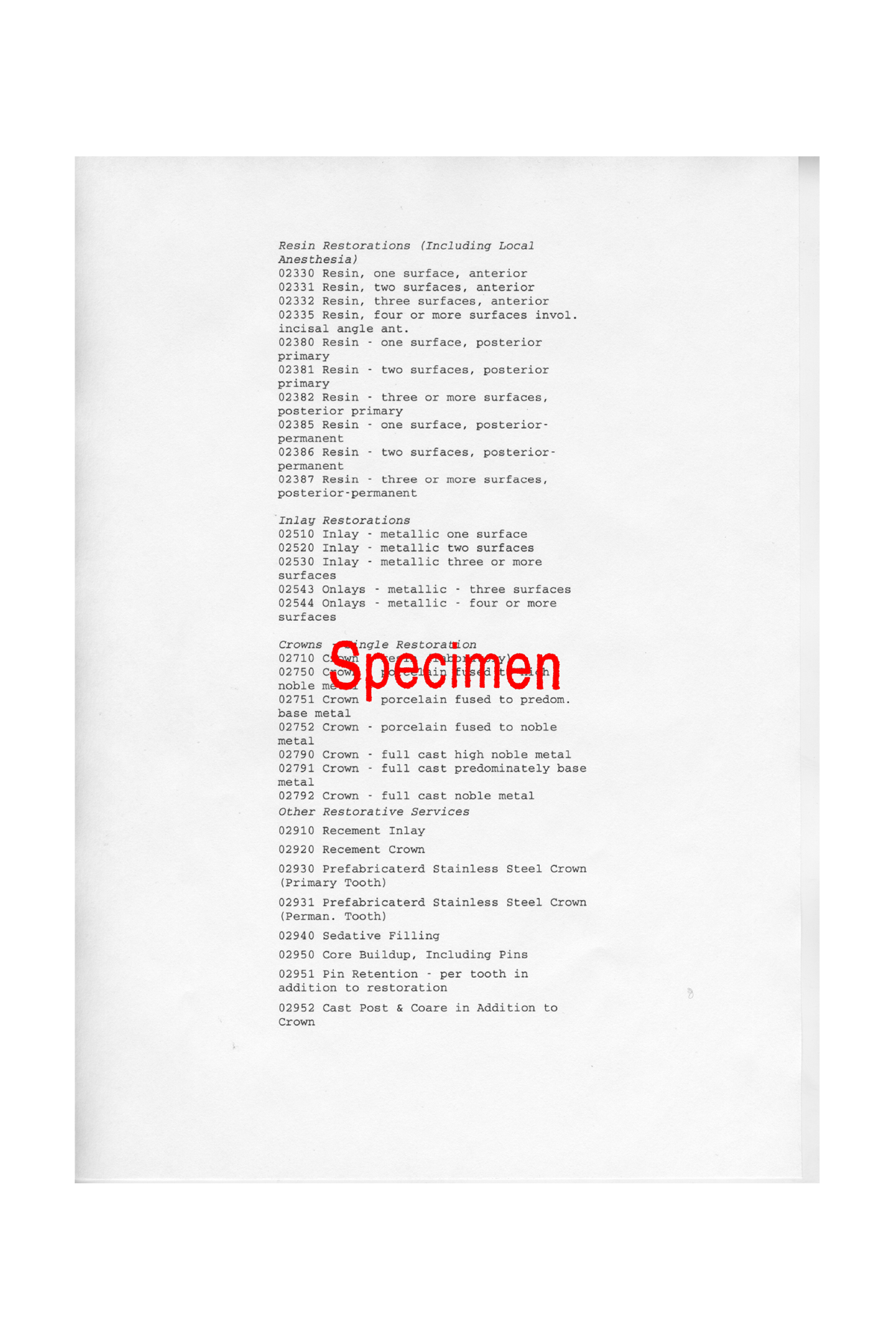
boundary thing 001038 (Uniform Code and Nomenclatures, page 2)
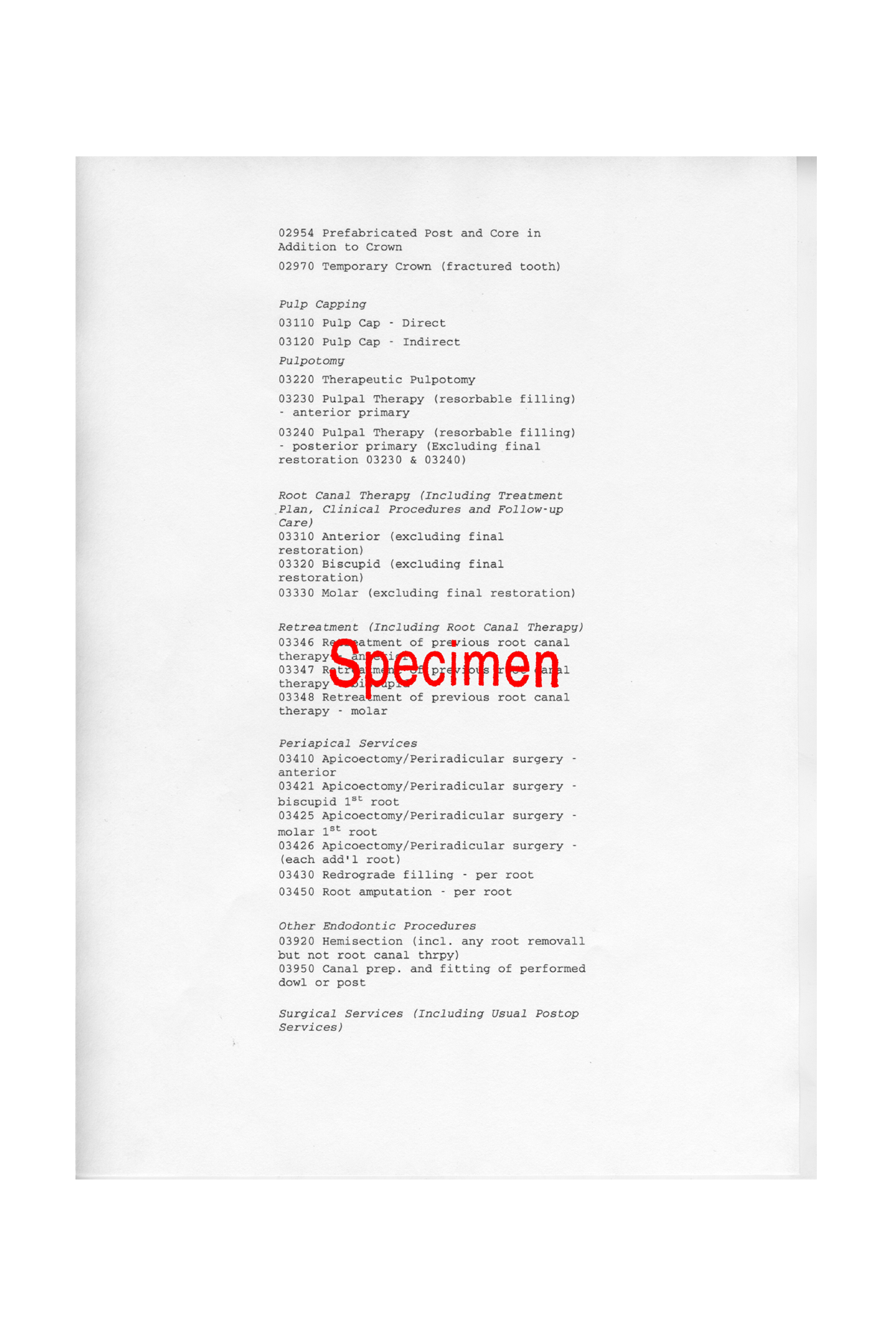
boundary thing 001038 (Uniform Code and Nomenclatures, page 3)
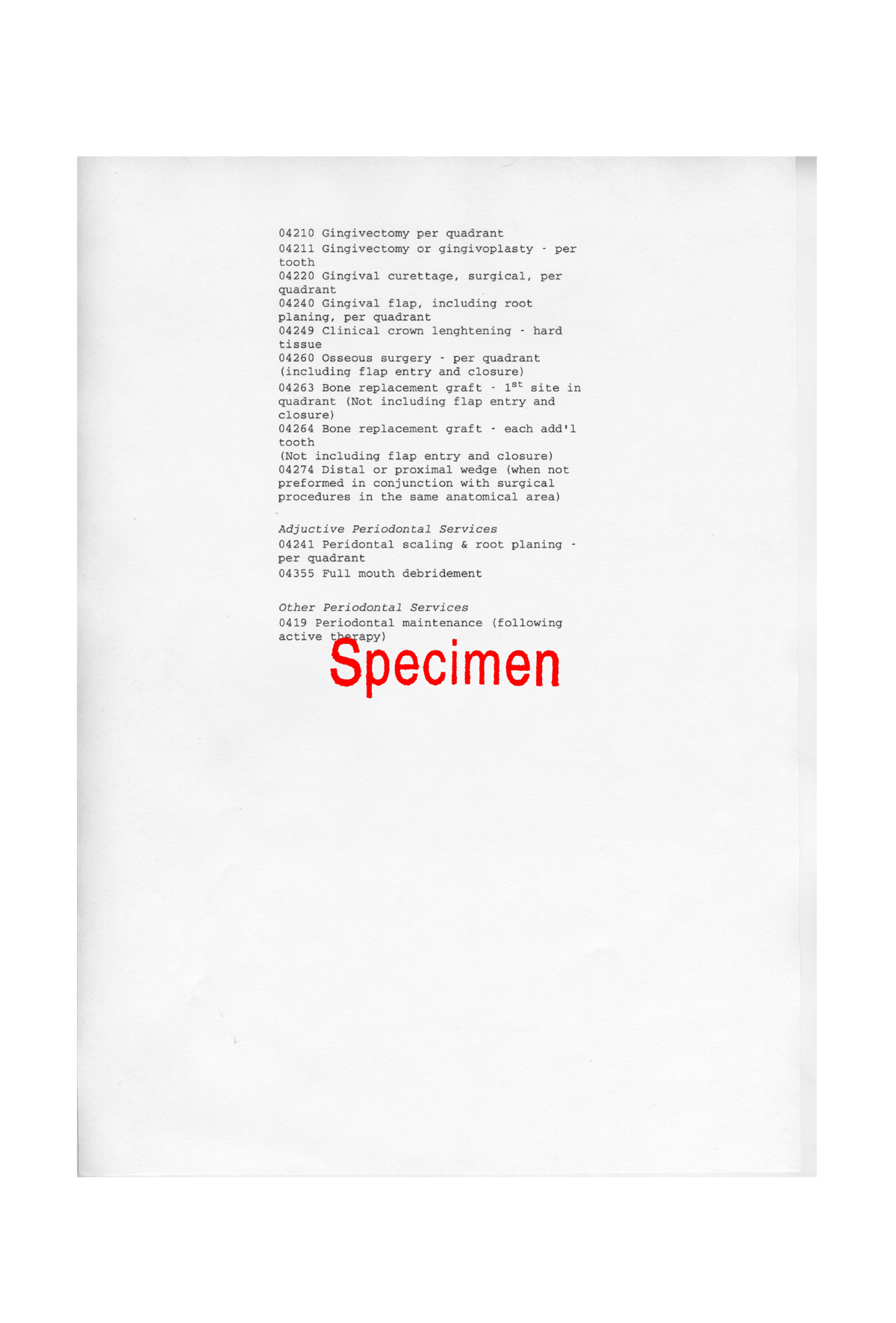
boundary thing 001038 (Uniform Code and Nomenclatures, page 4)
In 1969, The American Dental Association (ADA), a not-for-profit corporation that represents the interests of approximately 140.000 dentists and representatives from Delta Dental Plans Association (Delta), convened to develop a numerical shorthand code to describe all potentially billable dental procedures. This code, entitled Code on Dental Procedures and Nomenclature, allowed dentists to report to insurance companies which procedures they had performed. Every five years, additions, modifications and deletions were made. These revisions of the taxonomy were subsequently published in the Journal of the American Dental Association (JADA).
In 1989, during negotiations in the revision process, Delta withdrew from the process of updating the code. In 1990, Delta, against ADA’s wish, developed an alternative code: Uniform Code and Nomenclatures. On August 1, 1991, the American Dental Association obtained a copyrighted registration for JADA which included it the 1990 version of Code on Dental Procedures and Nomenclature. Delta subsequently filed for copyright registration but the Copyright Office rejected Delta’s request for registration of Uniform Code and Nomenclatures, stating the deposited material failed to disclose the required element of originality in selection, coordination or arrangement necessary to protect a compilation.
On September 19, 1992, the ADA filed suit against Delta for infringing ADA’s copyright for Code on Dental Procedures and Nomenclature. On May 1, 1996, the court case American Dental Association v. Delta Dental Plans Association took place at the United States District Court of Illinois. Judge Zagel stated:
The primary purpose behind Code is administrative convenience: making billing easier for dentists, their clients, and insurance companies. [...] What is protected in a compilation, therefore, is not the facts, data or preexisting material that form the content of the work, but rather (and only) the compiler’s original contribution. [...] As the ADA wanted Code to be comprehensive, there was no “choice” in the sense of selecting one procedure over another based on qualitative criteria. [...] Code follows [...] logical principles [...] The inclusion of dental procedures in Code resulted from a vote by a majority of committee members after collective editing and revision [...]. Any spark of authorial “personality” was drained through the process of consensus [...].
The court concluded that the taxonomy made by ADA was devoid of the necessary creativity in its “descriptors”, its selection and its arrangement. It stated that its copyright registration was invalid.
ADA appealed the decision. On September 30, 1997, the court case American Dental Association v. Delta Dental Plans Association took place at the United States Court of Appeals. Judge Easterbrook held:
This case presents the question whether a taxonomy is copyrightable. [...] Any original literary work may be copyrighted. The necessary degree of “originality” is low. [...] Dental procedures could be classified by complexity, or by the tools necessary to perform them, or by the parts of the mouth involved, or by the anesthesia employed, or in any of a dozen different ways. Code’s descriptions don’t “merge with the facts”. [...] There can be [...] multiple original taxonomies of a field of knowledge. [...] This is clear enough for the long description of each procedure in the ADA’s Code. [...] But we think that even the short description and the number are original works of authorship. [...] Delta Dental Association could have written its own classification of dental procedures. [...] A taxonomy is a way of describing items in a body of knowledge or practice; it is not a collection or compilation of bits and pieces of “reality”. Delta asks us to affirm [...] that Code is not copyrightable because it is a “system”. [...] Code is a taxonomy, which may be put to many uses. These uses may be or include systems; Code is not.
The court concluded that the arrangement of the taxonomy Code on Dental Procedures and Nomenclature was not a system and could be protected as an original work of literature and decided that the previous judgement was vacated.
